
MARCH 2023 CONSTRUCTION SPECIAL SECTION | ARCTIC ENERGY | 7(I) AND 7(J)

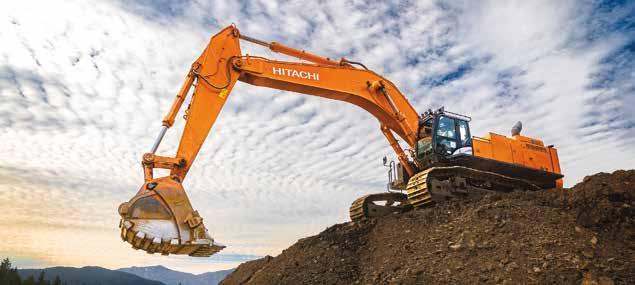



PROTECTING YOUR REPUTATION AND YOUR BOTTOM LINE. A thousand factors impact your bottom line every day. Some in your control, some well beyond it. One thing you have the power to choose is who you work with. Our job is to keep you moving forward. Our machines are engineered with a “get it done” mentality and our After Sales Solutions are designed to keep you up and The tougher your job gets, the easier it is to see we’re here when Hitachi Construction Machinery Americas Inc. Anchorage, Alaska (907) 563-3822 Toll Free (800) 478-3822 Juneau, Alaska (907) 780-4030 Toll Free (888) 399-4030 Fairbanks, Alaska (907) 931-8808 Ketchikan, Alaska (907) 247-2228 IN THE WORLD Hitachi, the best in construction equipment technology IN ALASKA CMI, the best sales and product support lineup IN YOUR CORNER The Winning Team www.cmiak.com Kirk Currey Anchorage Branch Sales Rep. Korey Day Anchorage Branch Sales Rep. Seward Highway, AK Seward Highway, AK


HELP TUR N POTENTIA L INTO POSSIBILIT Y. Go online or call the number listed above to request a Plan Disclosure Document, which includes investment objectives, risks, fees, expenses, and other information. You should read the Plan Disclosure Document carefully before investing. O ered by the Education Trust of Alaska. T. Rowe Price Investment Services, Inc., Distributor/Underwriter. 202212-2648028 O er employees the benefit of Alaska 529 Workplace. A convenient way for employees to save for education. 1-844-529-5290 | Alaska529plan.com/Workplace SAVE IN ALASKA. STUDY ANYWHERE.
22 ENERGY
Arctic Alternatives
Multiple roads to Alaska's energy future
By Tara O’Hanley
16 ALASKA NATIVE
Voice of the Arctic Iñupiat
Vision and priorities for Alaska’s Far North
By Richard Perry
84 HEALTHCARE
Against the Darkness
Promoting mental health in Arctic workplaces
By Alexandra Kay
90 MINING
Countdown to Graphite One
Restoring the US supply of a critical mineral
 By Amy Newman
By Amy Newman
96 FISHERIES
Snagged by Accident
Escaping the bycatch blame game to seek balanced solutions
By Vanessa Orr
104 FINANCE
Sharing Value
The rich past and uncertain future of 7(i) and 7(j) revenue
By Elwood Brehmer
108 EDUCATION
LeeAnn Munk and Mary Beth Leigh
Inducted into the Innovators Hall of Fame
By Tasha Anderson
10 EDUCATION
Rooms Full of Leaders
UAA’s Alaska Native Business Management program
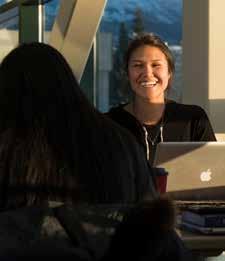 By Jesse Leman James R. Evans UAA
By Jesse Leman James R. Evans UAA
QUICK READS
Todd Paris | UAF 4 | March 2023 Alaska Business www.akbizmag.com MARCH 2023 | VOLUME 39 | NUMBER 3 | AKBIZMAG.COM
8 FROM THE EDITOR 114 INSIDE ALASKA BUSINESS 114 ECONOMIC INDICATORS 116 RIGHT MOVES 118 ALASKA TRENDS 120 OFF THE CUFF
CONTENTS FEATURES
SHAPE YOUR TOMORROW
As First National enters a second century of investing in Alaska, you and your financial needs will continue to come first. From buying a home to growing your business, you can count on our experienced team to deliver personalized service and innovative banking solutions to help you shape a brighter future.

FNBAlaska.com
907-777-4362
MEMBER FDIC • NMLS# 640297
32 TERMINAL CONDITIONING
Upgrades at ANC airport welcome a new intercontinental carrier
By Scott Rhode
40 OUT IN THE COLD
Constructing buildings for Arctic conditions

 by Rachael Kvapil
by Rachael Kvapil
60 SPECIALIZING BY GENERALIZING
By Rindi White
62 PAVED PARADISE
The development impact of parking requirements
By Scott Rhode
70 CONSTRUCTION ROUNDUP 2023
Infrastructure projects starting or finishing this year
By Katie Pesznecker
80 MERIT SHOPS AND FREE ENTERPRISE
A Q&A with ABC Alaska President and CEO Alicia Maltby
By Tasha Anderson
ABOUT THE COVER
Construction projects north of the Arctic Circle have provided much of the state’s revenue for more than forty years. One specific marvel of engineering and construction, the Trans Alaska Pipeline System, connected northern resources to Southcentral, and from there to the rest of the world. But every smaller (and significantly shorter) pipeline, bridge girder, and cell tower built since is a critical part of developing and understanding the Arctic.
Alaska’s place in the Arctic, and the way it joins the United States to international Arctic conversations, has become even more critical over the years. The resources located in the Far North, the potential for travel and trade, the opportunities for research, and the role the Arctic plays in the overall health of the planet are hard to understate. Alaska is center stage, and the show is nowhere near over.
Cover photo courtesy of US Department of Energy Alaska Business (ISSN 8756-4092) is published monthly by Alaska Business Publishing Co., Inc. 501 W. Northern Lights Boulevard, Suite 100, Anchorage, Alaska 99503-2577; Telephone: (907) 276-4373. © 2023 Alaska Business Publishing Co. All rights reserved. No part of this publication may be reproduced without written permission from the publisher. Alaska Business accepts no responsibility for unsolicited materials; they will not be returned unless accompanied by a stamped, self addressed envelope. One-year subscription is $39.95 and includes twelve issues (print + digital) and the annual Power List. Single issues of the Power List are $15 each. Single issues of Alaska Business are $4.99 each; $5.99 for the July & October issues. Send subscription orders and address changes to circulation@akbizmag.com. To order back issues ($9.99 each including postage) visit simplecirc.com/back_issues/alaska-business. 52 HONING IN Specialty contractors sharpen skills for market niches
46 COMMUNITY TRANSPORTATION INFRASTRUCTURE How the CTP and TAP build local projects By Dimitra Lavrakas STG Corvus Design 6 | March 2023 Alaska Business www.akbizmag.com MARCH 2023 | VOLUME 39 | NUMBER 3 | AKBIZMAG.COM CONTENTS SPECIAL SECTION: CONSTRUCTION
By Rindi White
COMMITTED TO YOUR SUCCESS



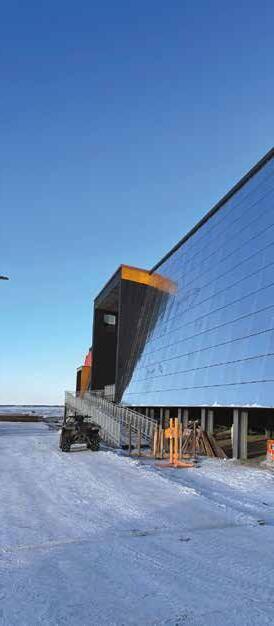

FROM THE EDITOR
In February federal authorities delivered two decisions on projects long under development: no for Pebble, yes to Willow. When determinations like these are made, my inbox is flooded with emails from interested parties and key stakeholders lauding or lamenting the announcement.
In the case of ConocoPhillips Alaska’s Willow project, a North Slope development estimated to produce approximately 180,000 barrels of oil per day at its peak, most of the press releases that jammed my inbox commended the US Bureau of Land Management’s Supplemental Environmental Impact Statement (SEIS), which indicated there is a federally permitted path to production. A joint release from the Iñupiat Community of the North Slope, North Slope Borough, and Arctic Slope Regional Corporation stated: “The elected regional Iñupiat leadership of the North Slope encourages the Biden administration to move forward with final approval for Alaska’s Willow Project… As the final SEIS signals, advancing Willow is critical for domestic energy independence, job security for Alaskans, and the right of Alaska Natives to choose their own path… We know our lands and our communities better than anyone, and we know that resource development and our subsistence way of life are not mutually exclusive. The new economic activity initiated by Willow will strengthen our region’s economic foundation and make possible the continuation of our Iñupiaq culture and way of life.”
In contrast, the reaction to Pebble was mixed. I received an equal number of press releases condemning and praising the US Environmental Protection Agency’s (EPA’s) decision. It’s not surprising: the Pebble mine has been a highly controversial project for years, and for good reason. Most look at development at Pebble as choosing between copper and gold or fish—and they’re all good things to have. The question is, of course, does the risk make sense?
According to the EPA and many who live in the region, it does not. Bristol Bay Native Corporation’s President and CEO Jason Metrokin stated in response to the announcement: “Today is a great day for Bristol Bay, and one that many thought would never come… EPA’s Final Determination is confirmation that Bristol Bay is a special place and Pebble mine represents a unique threat to our region, economy, and way of life.”
Part of being an editor is selecting what facts and opinions we publish. In this instance, the opinions that I chose to include in this letter are those that I feel are the most pertinent: the views of those who must live with the project in their backyard.
This publication supports responsible development. But who decides if a project is responsible? Tons of people. Alaska is a checkerboard of federal, state, and private ownership, rich with resources and crisscrossed by innumerable bodies of water. Major projects require feedback from local communities, state officials, and federal regulators. “Is it responsible?” is a question that’s been explored for years, maybe decades, through data collection and analysis and public input. No significant project in Alaska has not had that question applied to it liberally and repeatedly.
The decisions for Willow and Pebble are a comfort to some and a disappointment to others. In my position at this magazine, I find deep satisfaction in knowing that we support the Alaskans who advocate for the right process, every time.
VOLUME 39, #3
EDITORIAL STAFF
Managing Editor Tasha Anderson 907-257-2907 tanderson@akbizmag.com
Editor/Staff Writer Scott Rhode 907-257-2902 srhode@akbizmag.com
Editorial Assistant Emily Olsen 907-257-2914 emily@akbizmag.com
PRODUCTION STAFF
Art Director Monica Sterchi-Lowman 907-257-2916 design@akbizmag.com
Design & Art Production Fulvia Caldei Lowe production@akbizmag.com
Website Manager Taylor Sanders webmanager@akbizmag.com
BUSINESS STAFF
President Billie Martin
VP & General Manager Jason Martin 907-257-2905 jason@akbizmag.com
VP Sales & Marketing Charles Bell 907-257-2909 cbell@akbizmag.com
Senior Account Manager Janis J. Plume 907-257-2917 janis@akbizmag.com

Senior Account Manager Christine Merki 907-257-2911 cmerki@akbizmag.com
Accounting Manager James Barnhill 907-257-2901 accounts@akbizmag.com
CONTACT
Press releases: press@akbizmag.com
Tasha Anderson Managing Editor, Alaska Business
Postmaster: Send address changes to Alaska Business 501 W. Northern Lights Blvd. #100 Anchorage, AK 99503

AKBusinessMonth alaska-business-monthly
AKBusinessMonth akbizmag
8 | March 2023 Alaska Business www.akbizmag.com
FORWARD
We have been industry leaders providing innovative transportation solutions in Alaska for over 40 years.

MOVING PROJECTS
Rooms Full of Leaders
UAA’s Alaska Native Business Management program
 By Jesse Leman
By Jesse Leman
When the Alaska Native Claims Settlement Act established corporations to facilitate land transfers, one of the objections to the federal law was that Western corporate structures were alien to the Indigenous way of life. Fifty years of struggle and success have demonstrated that Alaska Native corporations can thrive under self-determination. A critical part of their history and path forward is finding and developing leaders within their ranks.
Joining in that mission of nurturing business acumen, UAA offers its Alaska Native Business Management program.
“It’s a small, fledgling program,” says Sharon Lind, an assistant professor of management. “We are still in a growth phase. When I left UAA two years ago, the program was actually growing. We’re trying to reinvigorate and reactivate that interest.”
After a two-year hiatus from the program, Lind returned as its director, and she found that recruitment had dwindled. “The program was kind of in limbo during those two years,” she says, “so we’re working really hard to change that and get the word out. I’m working nonstop on recruitment.”
To streamline recruiting, Lind built a statewide database that includes all of the Alaska Native regional and village corporations, their nonprofit affiliates, and even individuals that Lind has spoken with at events like the Alaska Federation of Natives convention, where she set up a booth with the focus of outreach.
Flying the Flag
It helps to have unofficial ambassadors of the Alaska Native Business Management program, such as alumni Zach Dunlap and Francine Moreno. Whether presenting at a showcase in Rasmuson Hall for the College of Business and Public Policy (CBPP) or meeting with Senator Dan Sullivan, Dunlap and Moreno are always willing to volunteer their time and energy toward making sure people know how impactful the program has been for them.
10 | March 2023 Alaska Business www.akbizmag.com EDUCATION
James R. Evans UAA
For the past fifteen years, Dunlap has worked at Doyon, Limited, where he is also a shareholder. When he and his wife both decided to go back to school, they came across the minor in Alaska Native Business Management through their degree program. With each working for Native corporations, they thought it was worth looking into, and after the first class Dunlap knew it was a great fit.

“I had done other professional development sort of similar to this, and this program specifically was geared exactly towards what we do every day at work,” says Dunlap. “It’s so uniquely Alaskan. It’s a big business community, as far as the Native corporations go, but there isn’t a whole lot of opportunity for this kind of academic pursuit. You just have such great exposure to people in Alaska Native businesses. It was definitely the highlight of our academic career.”
When Lind found out she was going to be out of town last fall during the CBPP showcase, she asked Dunlap if he would present on her behalf. “It was a pretty good experience to sort of fly the flag [for the program] and mingle with people throughout the business community and tell them what the university can offer, especially as people are trying to recruit and grow local talent,” says Dunlap. “I was able to present to a room full of business leaders, including Governor Bill Walker. I definitely did a lot of networking and ran into a few people that had gone through the program after me.”

“I want students to enter into the classroom and leave and be able to immediately apply the information they learned to their day jobs.”
Shauna Hegna, President, Koniag
Koniag President Shauna Hegna teaches BA A402, Alaska Native Corporation Leadership.
www.akbizmag.com Alaska Business March 2023 | 11
Kerry Tasker
Minor Achievement
Moreno found going to college challenging initially. “I was working toward my bachelor’s degree, and I was really interested and passionate about going to school at first. I had a lot of years of work experience, and translating that to college courses telling you how to give a presentation, how to write a document, how to write a proposal… I’d done all of that through work. It started turning into, ‘Let’s just check the boxes and get these classes done,’" says Moreno. “Until, in one of my classes, somebody came in and said, ‘Hey, there’s this new Alaska Native Business Management minor program; you can attend a weekend class and you’ll get one credit. It’s an introduction class, and if you’re interested you can sign up to have this as a minor in your degree.’ So I did it, and I found that I was extremely passionate, and it reinvigorated my interest in attending and finishing college.”
The passion that Moreno has for the program was the topic of conversation when she met with Sullivan at the Alaska Federation of Natives convention in October. Upon running into Lind at the event, Moreno was asked if she would like to meet with

Sullivan along with another alumna, Kalani Tucker. “When he asked about the program, Kalani and I both shared our experience and the reason why we minored in the program and how impactful it was for our education. I let him know that I wouldn’t have gotten this foundational knowledge without this program,” says Moreno.
Upon coming back to UAA, one of Lind’s first tasks was to create a certificate for those who aren’t enrolled in a degree program, which is the only way students can minor in Alaska Native Business Management.
“That was a huge accomplishment of the program this year,” says Lind. “I spent hours upon hours on making the certificate, and when they told me it couldn’t launch in the fall of 2022, I said, ‘It has to. It just has to!’”
Working through the Undergraduate Academic Board, a curriculum for the certificate program was approved in the nick of time.
“So now, not only do we have an eighteen-credit minor in Alaska Native Business Management, we also have a sixteen-credit occupational endorsement certificate in Alaska Native Business Management,” Lind explains. “It’s a unique program. No
other university in Alaska offers a minor and a certificate on Alaska Native corporations. UAA does.”
Master Plan
One thing Lind would like to add is an emphasis area for UAA students pursuing a master’s degree in business administration. “A lot of graduate students are interested in these courses. In fact, my 401 class [Alaska Native Corporation Business Management] is pretty much filled with graduate students this semester,” she says. “How can we build sustainability into the program? That’s one thing that I have to look very seriously at, to make sure that this program has longevity, just like Alaska Native corporations have longevity.”
Also on Lind’s wish list is a named professorship, like CBPP’s Distinguished Rasmuson Chair of Economics. “One of the things I’m preaching to UAA leadership right now is that we cannot let this program die just because you have a different faculty member,” she says. “We have a working committee, and we are brainstorming ideas.”
While she says it’s premature to discuss some of the ideas that the committee is looking at, Lind maintains that it is all for the improvement and efficiency of Alaska Native corporations. “I would love to have some of the board members of both regional and village corporations in my classes,” she says. “Once a year we invite the twelve chairs of the Alaska Native regional corporations into the classroom. At its height we had ten of the twelve chairs in the classroom working with students. We want to do more with these chairs.”
Humble Beginnings
The program has plenty of room for growth, coming from humble beginnings. Not long after its inception in 1997, the board of directors of the ANCSA Regional Association—that is, the presidents and CEOs of the twelve Alaska Native regional corporations— voiced their opinion to UAA that there was a lack of curriculum in the area of Alaska Native corporations and the Alaska Native Claims Settlement Act of 1971. They formed an education committee headed by Sheri Buretta, board chair of Chugach Alaska Corporation, that included former
Representing the program at the AFN convention. Pictured from left to right: Kalani Tucker of Southcentral Foundation (a past graduate); John Nofsinger, Dean of the UAA College of Business and Public Policy; Sharon Lind; Francine Moreno of Alaska Native Tribal Health Consortium (a past graduate); and US Senator Dan Sullivan.
12 | March 2023 Alaska Business www.akbizmag.com
Sharon Lind
ALASKA

USA FEDERAL
CREDIT
UNION IS CHANGING ITS NAME TO GLOBAL CREDIT UNION
New name.
Still Alaskan to our core.
Learn more
Insured by NCUA
CBPP dean Elisha Baker and the late George Geistauts, former director of the MBA program at UAA.

“They remembered several papers I wrote in my MBA program about Alaska Native corporations, knew I was heavily involved, and asked me to come talk with them,” Lind remembers. “Quite honestly, I didn’t love what they were saying about the program, but I did like what they were proposing about adding curriculum in this area. I was hired in 2011, and it started with one single class. By 2014 we had a minor in Alaska Native Business Management.”
The minor and certificate program now boasts four courses. One of them, BA A402 Alaska Native Corporation Leadership, is taught by Shauna Hegna, president of Koniag.
“We are so fortunate to have Shauna this spring,” Lind says. “Shauna has participated in this program previously as a guest speaker, and I just look at her and see this incredible, charismatic leader who can mentor the next generation in a phenomenal way.”
In addition to being the president of Koniag, Hegna is a shareholder of Koniag and Afognak Native Corporation and is an enrolled tribal member of the Native Village of Afognak and the Native Village of Port Lions. Hegna grew up in Port Lions, a village with fewer than 200 people on Kodiak Island that is still deeply rooted in traditional values and a subsistence lifestyle. “I have very fond memories
of fishing and hunting for ducks and deer growing up. Still today, three generations of my family get together to go deer hunting every fall,” Hegna says.
“My father is a very traditional Alaska Native man, so he doesn’t say much, but when he does speak, you’re expected to listen,” she adds. “And I remember one day he just looked at me and said, ‘You’re going to go to college, and you’re going to get a degree, and you’re going to help your people.’ My father knew that I needed to go to college to best help our community, but he didn’t understand what that would entail. And growing up in those traditional values really shaped who I became as a professional.”
Theories of Leadership

Hegna has volunteered as a guest speaker at UAA, Alaska Pacific University, and UAF in courses related to Alaska Native corporations for several years.
“Sharon Lind has been encouraging me to teach, and I finally said yes, and I am so excited,” says Hegna. “The reason why I said yes is because of the uniqueness of the class itself. It speaks specifically to Alaska Native corporation leadership, from the boardroom to executives. I feel that it is a topic that has a lot of areas for robust dialogue with students and a lot of opportunity to find similarities and differences in the way in which Alaska
Native corporations are led versus other for-profit corporations that you might see in America.”

The Alaska Native Business Management program wasn’t offered when Hegna was in school. “The closest thing that would position me for Alaska Native corporation leadership—besides a business major, which I chose against at that point in my life—was to major in history and minor in Alaska Native studies,” Hegna explains. “That was the only way I could cobble together a strong knowledge base in traditional Alaska Native cultures.”
Hegna added to her undergrad studies with a graduate degree in rural development. “I was able to maximize the courses that were available through UAF that really helped to inform my leadership style and that I could also immediately apply to work,” she says. “And that’s my vision for this course. I want students to enter into the classroom and leave and be able to immediately apply the information they learned to their day jobs.”
Her course covers contemporary theories of leadership, but with a twist. “Like comparing and contrasting traditional Alaskan Native values with modern corporate leadership theories,” Hegna says. “Some of the course is going to be talking about leading sustainable change in an organization. And I’m really excited to engage the students in dialogue about that and talk with them about both effective and ineffective change that they have seen led in their own organizations.”
One change coming to the program is expanding its online offerings. Lind admits it’s a hard transition, and while Hegna sees potential challenges as an instructor, both are excited about reaching students who might have otherwise not been able to access the program.
“I think that it’s really empowering for the next generation of leaders. You find leaders in communities—whether they’re tribal administrators, presidents and CEOs of regional corporations, or schoolteachers—all of those leaders have a huge impact on their community,” says Hegna. “And when we can create opportunities to learn, and they can stay at home, that’s a win/ win for Alaskans.”
Zach Dunlap of Doyon, Limited (right) rubs shoulders with former Governor Bill Walker while presenting as a past graduate of Alaska Native Business Management.
Zach Dunlap
14 | March 2023 Alaska Business www.akbizmag.com


Voice of the Arctic Iñupiat

Vision and priorities for Alaska’s Far North
By Richard Perry
Voice of the Arctic Iñupiat formed in 2015 as a 501(c)(4) nonprofit organization. Working with twenty-four Alaska Native regional and village corporations, associations, and municipal governments in the North Slope Borough, the Voice is a network offering a unified voice for the area and its people.
The priorities and goals of the Voice are forward-thinking, seeking to mitigate current challenges and provide a long-term plan for the region. The most recent plan is named Vision 2050, which addresses subsistence, language and culture, healthcare, transportation, housing and infrastructure, resource development, and economic sustainability.
16 | March 2023 Alaska Business www.akbizmag.com ALASKA NATIVE
Nathaniel Wilder


Arctic Slope Regional Corporation “There is so much opportunity for us on the North Slope, and to help realize those opportunities is something I am looking
to taking on.”
of
Nagruk Harcharek Voice of the Arctic Iñupiat Employee Benefits | Property & Casualty Programs | Personal Risk | Retirement Consulting © 2023 USI Insurance Services. All rights reserved. Alaska Isn’t Just Any State. USI Isn’t Just Any Broker. The consultants in USI’s Anchorage & Sitka offices know Alaska like their own back yard because, well, it is. With decades of presence & experience in the state, our Alaskan teams deliver informed perspectives & customized brokerage & consulting solutions to aid Alaska-based businesses in addressing the specific & unique challenges they face. Call Anchorage: 907.272.0114 Sitka: 907.747.8625 or visit usi.com www.akbizmag.com Alaska Business March 2023 | 17
forward
Nagruk Harcharek, President, Voice
the Arctic Iñupiat
(ASRC) and grants from the North Slope Borough in lieu of dues from other member organizations.

The North Slope Borough funds water and sewer infrastructure, waste management, and police and fire protection in Arctic villages. These services are supported through taxation of oil infrastructure. The borough also runs its own Department of Wildlife Management.

“When there are decisions going to be made surrounding any of the subsistence species we rely on,” Harcharek says, “the science is going to be done by us and with us.”
Self-determination in wildlife management is a big change from prior generations. “In the ‘70s, there was a moratorium on whaling,” he says. “This was done as a result of bad science. Now, whenever there is a decision to be made, we are going to come prepared with our own science, our own research. We are going to make sure our rights are protected.”
According to the Federal Subsistence Management Program, the current rural subsistence harvest is about 295 pounds of food per person per year. That is more than the US average consumption of 255 pounds of domestic meat, fish, and poultry per year.
Retail foods face two significant obstacles in the Arctic: distance and climate. Without roads, supplies travel
by air or by seasonal barge. Along the way, perishables must be well insulated from -60°F temperatures during the long winter.
Keeping goods at a consistent temperature requires very specialized understanding of how that will be accomplished. Therefore, the Voice has identified transportation as a priority and is adamant about being part of the conversation when the region’s communities are involved.
forward the region’s traditions—yet Arctic ways of learning can also inform cultural grounding worldwide.
Borrowing lessons from the Arctic region to create education systems that ground students in their own cultures, Indigenous or otherwise, is the theme of a textbook published online in January and co-edited by Diane Hirshberg, professor of education policy at UAA and director of the Institute of Social and Economic Research.
Introduction: Education, Equity and Inclusion for a Sustainable North compiles views from researchers in Russia, Finland, Sweden, Norway, the Faeroe Islands, Greenland, Canada, and Alaska. Its purpose is to support teachers in addressing diversity and inclusion and seeking solutions to structural and geographic challenges to education in the circumpolar North.
As a 501(c)(4) nonprofit, the group is a tax-exempt entity operating exclusively to promote social welfare, which can include lobbying for legislation, which a 501(c)(3) nonprofit may not do.
Arctic Education
Part of the social welfare mission deals with Iñupiat language and culture. The Voice looks to education to carry
Those challenges have been holding back educational success for many Alaska Native students in primary and secondary education. American Indian/ Alaska Native high school students have the highest dropout rate at 9.6 percent, according to the National Center for Education Statistics (NCES). This is much higher than the overall dropout rate of 5.1 percent.
The US Department of Education and NCES are the primary federal entities for collecting, analyzing, and reporting data related to education in
“When there are decisions going to be made surrounding any of the subsistence species we rely on… the science is going to be done by us and with us.”
Nagruk Harcharek President, Voice of the Arctic Iñupiat
USGS
Alaska Native Science and Engineering Program (ANSEP) student Jakob Sipary holds a red-throated loon on the Canning River Delta as part of a 2019 study on habitat in the Arctic National Wildlife Refuge. ANSEP's objective is to place students on a career path to leadership.
18 | March 2023 Alaska Business www.akbizmag.com
A fuel facility in Golovin, near Nome. State of Alaska
the United States. For 2021 published data nationwide, the overall dropout rate decreased from 8.3 percent in 2010 to 5.1 percent in 2019. During this time, the dropout rate declined for 16to 24-year-olds who were American Indian/Alaska Native from 15.4 percent to 9.6 percent, an improvement, however, significantly disproportionate to the 5.1 percent average.

Hirshberg co-authored a chapter with Douglas Cost and Edward Alexander titled “Adaptation Isn’t Just for the Tundra: Rethinking Teaching and Schooling in Alaska’s Arctic.” The chapter examines recent proposals to extend more tribal authority over rural schools and reflects on whether selfdetermination would change education for the better.
“I really hope that our work can help policymakers realize that excellence in education is more than just good scores on international standardized tests,” Hirshberg says. “It also means supporting heritage language maintenance alongside the linguistic diversity brought by newcomers; ensuring that Indigenous epistemologies and pedagogies are privileged alongside Western ways of teaching and learning; and that the solution to improving graduation rates and teacher retention is schooling in which all students see themselves in the curriculum and communities see the schools and teachers as embracing local knowledge alongside the knowledge brought from outside.”
Addressing diversity and inclusion in the classroom—including the importance of language and a healthy sense of identity and creating solutions to structural and geographical challenges in education in the circumpolar north— has been an ongoing concern and dynamic that continues to impact student success.
Healthcare and Housing
The Voice also identified healthcare as a priority. According to US Census Bureau projections, the 2020 life expectancies at birth for American Indian/Alaska Native people are 78.4 years, with 81.1 years for women and 75.8 years for men. For non-Hispanic whites, the projected life expectancies are 80.6 years, 82.7 years for women,
ALASKA MATERIALS “direct ships” wholesale materials to all Tribes, Villages, and locations in Alaska. Whether it’s barge load of materials for a school, or materials for boardwalks or hardened trails, our wide selection of materials has you covered no matter how big the project, the bigger the better. AND…as a courtesy, we pass freight costs on to you at cost…with no markup. Visit our website today and see our materials, products, and services. www.alaskamaterials.com
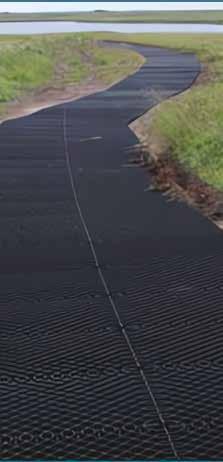

PO Box 92688 Anchorage, Alaska 99509 Office (907) 290-8031 Toll Free (844) 479-0763 alaskamaterials.com info@alaskamaterials.com
BEFORE a hardened trail project in Mekoryuk, Alaska.
AFTER a hardened trail project in Mekoryuk, Alaska.
www.akbizmag.com Alaska Business March 2023 | 19
and 78.4 years for men.
American Indian/Alaska Native people frequently contend with issues that prevent them from receiving quality medical care. These issues include cultural barriers, geographic isolation, inadequate sewage disposal, and low income.
Living in a village without adequate sewage and water treatment has been identified as a contributing factor to several negative and disproportionate health-related issues. To improve the health of rural Alaska communities, the Alaska Department of Environmental Conservation, in coordination with tribal, state, and federal agencies, is seeking better and more affordable ways to deliver drinking water and sewage disposal services.
Even in homes with indoor plumbing, Arctic families find themselves waiting in line to use the bathroom. Too many people in not enough homes is another challenge that the Voice is trying to address. According to a 2017 assessment by ASRC and the Alaska Housing Finance Corporation, 544 occupied units were estimated to be either overcrowded (15 percent) or severely overcrowded (12 percent). This is more than eight times the national average and the fourth most overcrowded of any region in the state.
An estimated 768 homes built before the ‘80s in the Arctic Slope region have yet to be retrofitted through a state program in the past ten years. Approximately 138 of the homes, or 7 percent, need complete kitchens, and approximately 216, or 11 percent, need complete bathrooms.

The region’s Taġiuġmiullu Nunamiullu Housing Authority directs affordable housing programs. However, there has been a waiting list of more than 300 applicants. Providing new affordable housing is difficult because the cost of shipping building materials, and providing utility infrastructure in the region is exceptionally expensive.
“There is so much opportunity for us on the North Slope,” says Harcharek in his welcome message on the Voice’s website, “and to help realize those opportunities is something I am looking forward to taking on.”
At the surface, the Voice and its Vision 2050 plan can read like a typical corporate publication, yet each priority seeks to address vital issues. The Voice seeks to be at the table when decisions are made to ensure the development of North Slope natural resources in a safe and responsible manner as well as promoting Iñupiat stewardship of Alaska’s Arctic region.

“The solution to improving graduation rates and teacher retention is schooling in which all students see themselves in the curriculum and communities see the schools and teachers as embracing local knowledge alongside the knowledge brought from outside.”
Diane Hirshberg Director
UAA Institute of Social and
Economic Research
State of Alaska 20 | March 2023 Alaska Business www.akbizmag.com
Northwest Arctic Borough School District hosts the Alaska Technical Center in Kotzebue for training in construction, process technology, culinary arts, professional skills, and nursing.


Congratulations
BSNC President & CEO Gail R. Schubert as a Laureate Inductee for the Alaska Business Hall of Fame.
Arctic Alternatives
Multiple roads to Alaska's energy future
 By Tara O’Hanley
By Tara O’Hanley
“The only reason we’re an Arctic nation is because of Alaska,” observes Givey Kochanowski, senior advisor to the US Department of Energy’s Arctic Energy Office.
“Wherever you are with political ideology, there’s an argument why Alaska matters” in conversations about energy, he continues. “If you’re environmentally focused, climate change is happening twice as fast in the Arctic as the rest of the world. If you’re more focused on Alaska’s untapped resources for domestic energy supply, you’re thinking those resources would be tremendous for our national security, because energy security is national security.”
Since the ‘70s, conversations about US Arctic energy have been dominated by oil and gas. The importance, or even possibility, of diversification of energy sources often gets lost amid that noise at the state level. Whether due to a lack of motivation when Alaska’s petroleum revenues are fleetingly high or due to a crippling lack of agency when revenues drop, the net effect over time is that projects end up with a false start or—too often—no start at all.
In short, at the federal level it’s all too possible that the public doesn’t know what they’re missing when it comes to the Arctic, and at the state level, policymakers are so busy holding on to one cookie that they tend to neglect other items available at the buffet.
US Department of Energy 22 | March 2023 Alaska Business www.akbizmag.com ENERGY
“These are tough issues,” Kochanowski says. “Energy cuts across every sector of the economy… and nobody has a 100 percent solution to what to do.”
What would a more diverse, multifaceted energy industry in Alaska look like? How can the state apply lessons learned from resource bonanzas in the past to properly seize opportunities in the future? What projects are worth risking investment? And how can Alaska stakeholders work with private industry to move projects forward in a way that will provide a more solid foundation to the state’s future, regardless of federal policy?
As is so often the case, the answers to these questions are, in a word, complicated.
Indian Country & Alaska Native Corporations

Carbon Monetization
A major pivot in Alaska’s resource policy occurred in December. Governor Mike Dunleavy, following up on discussions at his first annual Sustainable Energy Conference in May 2022, announced a bill to monetize the state’s capacity for carbon capture and sequestration. Instead of (or rather, in addition to) pulling carbon out of the ground in the form of fossil fuels, Alaska could see carbon dioxide reinjected into underground reservoirs, isolating the heat-trapping gas from the atmosphere. Or simply by leaving forest areas untouched, the plant biomass absorbs carbon dioxide.
Alaska Native corporations— including Ahtna, Chugach Alaska, and Sealaska—have been successfully developing carbon sequestration for several years, using forested tribal land as assets for carbon monetization. Federal incentives and growing corporate action on climate change
“Wherever you are with political ideology, there’s an argument why Alaska matters.”
Givey Kochanowski Senior Advisor, Arctic Energy Office
Preserving cultures and enhancing communities, represented by Schwabe.
We don’t just settle on knowing your industry. We live it.
Pair this knowledge with human, approachable legal services and you’ll see what it means to be represented by Schwabe. Schwabe, Williamson & Wyatt P.C. 420 L Street, Suite 400 Anchorage, AK 99501 (907) 339-7125 | schwabe.com www.akbizmag.com Alaska Business March 2023 | 23
Spotting trends and navigating turbulent waters can’t happen from behind a desk. The insights come when we put on our hard hats and meet our clients where they are.
are fueling major growth in carbon capture markets, and boatloads of private money are pouring in from tech companies seeking to help early-stage carbon capture and storage startups scale up and bring costs down.

Dunleavy sees an opportunity to raise hundreds of millions, if not billions, of dollars in revenue for the state within the next several years. According to Dunleavy, “Alaska probably has more capacity to sequester carbon underground than anywhere on the West Coast,” including a potential for 50 gigatons of carbon in Cook Inlet alone.
The scale of the carbon undertaking is enormous, with some experts predicting that meeting a goal of capturing 30 percent of emissions in 2050 would require building an industry three to five times the size of today’s global petrochemical industry. Companies such as Alphabet, Meta, Stripe, Shopify, and McKinsey are teaming up and launching initiatives to spur the market, to the tune of nearly
 Alaska Center for Energy and Power (ACEP) studies a plot of willows at the Fairbanks Experiment Farm.
Top, ACEP interns Henrique Goncalves (left) and Desneige Hallbert (right) monitor growth for potential use as biomass fuels.
Bottom, ACEP research technician Amanda Byrd (left) works with Steven Sparrow (right), dean of UAF’s College of Natural Resources and Agricultural Sciences.
Alaska Center for Energy and Power (ACEP) studies a plot of willows at the Fairbanks Experiment Farm.
Top, ACEP interns Henrique Goncalves (left) and Desneige Hallbert (right) monitor growth for potential use as biomass fuels.
Bottom, ACEP research technician Amanda Byrd (left) works with Steven Sparrow (right), dean of UAF’s College of Natural Resources and Agricultural Sciences.
24 | March 2023 Alaska Business www.akbizmag.com
Todd Paris | UAF
$1 billion, and Climeworks recently raised $650 million to launch a new direct air capture and storage plant in Iceland—the biggest funding round in the history of the carbon capture removal industry.



“With support from the legislature for our carbon management bill package, we’ll change the conversation about new revenue,” Dunleavy said in January upon the introduction of his legislation.
One bill would establish a statewide carbon offset program through forest sequestration. It would grant the Alaska Department of Natural Resources the ability to establish a carbon offset program, allowing private parties to lease state land for that purpose. A separate bill creates new authorities to license, lease, and administer subsurface “pore space” for geologic storage of carbon.
Commissioner of the Department of Natural Resources John Boyle says carbon management complements existing industries. “These bills do not lock up State land. Rather, they unleash new opportunities,” he says. “Carbon offset projects will not prevent mineral development, timber harvests, new oil and gas exploration, or infrastructure development. Land within the carbon offset program area will still be available for hunting, fishing, camping, and recreational activities for Alaskans and visitors.”
What sounds shiny and exciting in a press release, however, can pale when exposed to the sunlight of detailed evaluation. Despite the flood of capital being invested in the global carbon capture industry, questions remain about how these financing gymnastics might play out. With the opportunity to forge multigenerational contracts between the state and investors, the stakes are high, and ultimately the consequences are unknown.
Alaska at the Center
Inside the Joseph E. Usibelli Engineering Learning and Innovation Building on the UAF campus, the federal Arctic Energy Office shares close quarters with the Alaska Center for Energy and Power.



Kochanowski brings his experience as a US Air Force officer once stationed at Elmendorf and former manager of




“Who’s actually
it?
just
deploying technology,
doing
Not
talking… Who’s implementing, who’s
who’s
convening
and bringing people together, who’s coming up with sustainable solutions?”
Events | Concerts | Conferences | Conventions Banquets | Meetings | Trade Shows | Weddings In-house Catering | Equipment Technology Anchorage Convention Centers 907.263.2850 Anchorageconventioncenters.com Your space for any occasion Let’s get together ASM Global is the world’s leading producer of entertainment experiences. It is the global leader in venue and event strategy and management – delivering locally tailored solutions and cutting-edge technologies to achieve maximum results for venue owners. The company’s elite venue network spans five continents, with a portfolio of more than 350 of the world’s most prestigious arenas, stadiums, convention, and exhibition centers, and performing arts venues. www.akbizmag.com Alaska Business March 2023 | 25
Givey Kochanowski, Senior Advisor, Arctic Energy Office
the US Forest Service’s Alaska fleet. He was working for the Department of Energy Office of Indian Energy when he was tapped to give the department a physical presence in Alaska. The Arctic Energy Office, previously working under the Office of Fossil Energy, was re-established in 2001, the new century bringing a new focus on science and national security in the Far North.
Comprising about 6 percent of the Earth’s surface area—approximately equal to Africa—the Arctic holds an estimated 22 percent of the world’s undiscovered, technically recoverable fossil fuel resources, according to the US Geological Survey (USGS). Over time, as global supplies dwindle, the prices for oil and gas will rise while the cost of Arctic exploration and production (currently, nearly double the cost of other areas) will fall, but those curves have not crossed yet. Instead, the main drivers of today’s Arctic resource rush are minerals.
In addition to ranking in the top ten deposits in the world for coal, copper, lead, zinc, and silver, Alaska is also particularly rich in rare earth elements (REEs). This section of the periodic table has found its way into nearly all major high-tech devices, including military, industrial, and energy applications. Since the ‘90s, China has accounted for, on average, 90 percent of global REE production, but recent work by the USGS and Alaska Division of Geological and Geophysical Surveys have identified large deposits across the state.
The growing demand for REEs has resulted in the USGS listing them among thirty-five minerals and metals considered critical to the economic wellbeing and security of the United States. REEs are responsible for the great sound in tiny earbuds, but elements such as neodymium, praseodymium, terbium, and dysprosium are key to the renewable energy revolution, underpinning the technology behind
innovations including electric vehicles, solar, and wind.
In the meantime, as nations set goals to reduce carbon emissions, the very resource that powers Alaska’s economy—petroleum—is set to become less relevant on the world stage. But less relevant doesn’t mean gone.
“I don’t think rural Alaska’s going to be off fossil fuel anytime soon,” Kochanowski says. “However, the Department of Energy has helped many of those communities supplement their current fuel supplies with clean energy backed up by battery energy storage. No matter what, you want to be as efficient as possible with whatever fuel you’re bringing in at a premium to your community.” Pressure continues to build in these islanded communities to shift microgrid energy systems away from hydrocarbons to low-carbon sources. As a first step, significant efforts are being made to help villages
 USGS scientist Jennifer Lewicki measures the flow of a tributary to Hot Springs Creek on Akutan Island in the Aleutians. Springs that feed the stream expel steam nearby.
USGS scientist Jennifer Lewicki measures the flow of a tributary to Hot Springs Creek on Akutan Island in the Aleutians. Springs that feed the stream expel steam nearby.
26 | March 2023 Alaska Business www.akbizmag.com
Deborah Bergfeld | USGS
burn less fuel through measures like heat recovery and weatherization of homes and buildings.

Furthermore, because operating diesel generators is so expensive, renewable sources are comparatively more economical. Technological advancements in wind, solar photovoltaic, and battery energy storage, among others, have transformed Arctic communities into a new frontier for clean energy. This also makes the region an attractive test bed for companies to try out new technologies before deploying them more broadly elsewhere. Green energy has a real potential to be a key economic driver for areas of Alaska that otherwise struggle to attract industry.
Micro Steps
Alaska is well suited as a technology testing ground and has acted as an energy laboratory for decades. “We like to say that if a technology works in Alaska, it’ll work anywhere because our conditions are so extreme,” says Arctic Energy Office Director Erin Whitney.
Case in point: The US Army Corps of Engineers built the SM-1A Nuclear Power Plant at Fort Greely to test a stationary medium-sized reactor in a cold climate. The reactor, with an output of 20 thermal megawatts, operated from 1962 to 1972. The building stood empty for fifty years while radiation dissipated. Last July, Westinghouse Government Services of South Carolina was awarded a $103 million contract to complete the decommissioning, dismantling, and disposal.
At the same time, 75 miles north on the Richardson Highway, Eielson Air Force Base is preparing to welcome Alaska’s second ever nuclear reactor.
“Energy is a critical asset to ensure mission continuity at our installations,” Deputy Assistant Secretary of the Air Force for Environment, Safety, and Infrastructure Mark Correll said in an October 2021 press release, announcing Eielson as the site of the Air Force’s first microreactor.
Since the days of SM-1A, the nuclear energy industry has invented a new generation of reactors. The forefront of today’s nuclear revolution looks
“We like to say that if a technology works in Alaska, it’ll work anywhere because our conditions are so extreme.”
Erin Whitney Director Arctic Energy Office
GET THE EDGE UAF ECAMPUS IS THAT EDGE. Connect with UAF eCampus about our world-class online degrees. . . that are truly at your fingertips. Why Partner with UAF eCampus? We prepare Alaskans for Alaska’s Jobs - Online Quality - Leader in online education for over 30 years Variety - Over 45 online degrees and 650 courses Affordable - Online tuition is always at the in-state rate PLUS business partners get package pricing Convenient - Finish your degree online, on your time Individualized Student Support - Student success is our goal Help employees upskill, finish their degree, and boost morale 907-455-2090 www.ecampus.uaf.edu UA is an AA/EO employer and educational institution and prohibits illegal discrimination against any individual. http://www.alaska.edu/nondiscrimination University of Alaska Fairbanks eCAMPUS www.akbizmag.com Alaska Business March 2023 | 27
strikingly different from the large, traditional nuclear power plants in Europe or California. Some are portable enough to be trucked to remote sites and plugged in like batteries. The Eielson microreactor is rated for 5 MW of electricity. Construction is scheduled to begin in 2025, and after a year of testing, the reactor could enter commercial operation in 2027.
Nuclear microreactors are attractive to military bases for many of the same reasons that renewables are attractive to rural villages: they eliminate reliance on the grid. Small installations are particularly well suited for powering and heating remote bases. According to a 2018 roadmap for micronuclear deployment by the Nuclear Energy Institute, which was supported by the US Air Force, the Department of Defense (DoD) sees its needs for electricity growing as it requires power to desalinate water, produce hydrogen, and support data processing hardware, as well as to power robots and directed-energy weapons such as lasers that might be fielded in the future. In the near term, according to the roadmap, “Most DoD installations will seek one or more microreactors in the 2 to 10 MW range.”

For civilian applications, Copper Valley Electric Association is exploring whether microreactors would be feasible. Governor Dunleavy signed
legislation last May to simplify the regulatory process for microreactors in Alaska, recognizing the updates in technology.
“Alaska is very fortunate,” Kochanowski says. “Especially once Eielson Air Force Base gets its small reactor, we’re going to have every kind of technology up here. We’ve got river hydro technology in Igiugig. There’s a deployment coming to Port MacKenzie for tidal power. There’s geothermal here, being developed at Chena Hot Springs, which is a great test bed and proved that low-temperature geothermal works. There’s discussions and very heavy work being done to develop the Makushin Volcano Project in Unalaska, to power that community with renewable energy.”
Alaskans have long dreamed of a diverse energy portfolio, yet these are the handful of projects that are closest to reality. “What I challenge people to do is look behind the screen a little bit and say, who’s actually doing it? Not just talking, but asking,” Kochanowski says. “Who’s implementing it, who’s deploying technology, who’s convening and bringing people together, who’s coming up with sustainable solutions?”
In sum, he says, “There’s space and challenge enough in Alaska to solve our [national] energy crisis so that everybody has the potential to be at the table.”
“Carbon offset projects will not prevent mineral development, timber harvests, new oil and gas exploration, or infrastructure development. Land within the carbon offset program area will still be available for hunting, fishing, camping, and recreational activities for Alaskans and visitors.”
John Boyle Commissioner Alaska Department of Natural Resources
A photovoltaic project co-funded by the US Department of Energy brings fuel savings to the Northwest Alaska village of Buckland.
28 | March 2023 Alaska Business www.akbizmag.com
US Department of Energy
$3 billion invested over 4 decades created



ALASKA’S MOST ADVANCED NETWORK.




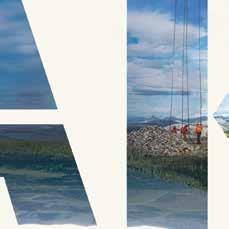

GCI.COM/BUSINESS
CONSTRUCTION IN ALASKA
Brick by brick, pour by pour, rivet by rivet, nail by nail—builders get it done. In advance of construction season , Alaska Business shines a spotlight on the industry that leaves its mark in concrete, asphalt, steel, and wood.

“Construction Roundup 2023” presents an overview of infrastructure projects that are finishing this year or are scheduled to begin. The roads, bridges, airports, and waterfront projects range in size from a couple million dollars to hundreds of millions.
“Terminal Conditioning” highlights one particular airport project: a renovation by Northern Pacific Airways as the start-up prepares to launch intercontinental flights through Anchorage later this year. And “Community Transportation Infrastructure” looks at a pedestrian stairway in Cordova and the Sitka Sea Walk among other projects funded by the state’s Community Transportation
Program and Transportation Alternative Program.
Specialists in Arctic construction share tricks of their trade in “Out in the Cold,” examining techniques and materials for adapting structures to Alaska’s most extreme conditions. That’s one of the niches that contractors have filled; “Honing In” explores others, such as Alaska Roof Restorations’ method for extending the lifespan of flat roofs, STG’s expertise in remote tower installation, and the hyper-specialized fabrication going on in Palmer at Triverus and TriJet.
Finally, a simple change to Anchorage’s land use code will have major effects on future building. The city wiped away its mandate for minimum parking areas, in hopes of stimulating new housing construction and commercial redevelopment, or possibly reshaping entire neighborhoods around transportation alternatives.
30 | March 2023 Alaska Business www.akbizmag.com CONSTRUCTION
US Department of Energy
YOU CAN HAVE IT ALL. When you own a versatile CASE C Series mini ex, digging is just the beginning. Operate in tight spaces, while experiencing industry-leading horsepower, automatic torque adjustment on slopes and standard auxiliary hydraulics for a wide variety of attachment use. It all adds up to productive performance.





PROUD SUBSIDIARY OF CALISTA CORPORATION ©2022 Yukon Equipment. All rights reserved. CASE is a trademark registered in the United States and many other countries, owned by or licensed to CNH Industrial N.V., its subsidiaries or affiliates.
ANCHORAGE 2020 East Third Avenue Anchorage, AK 99501 Phone: 907-277-1541
info@yukoneq.com
3511 International
Fairbanks, AK
Phone: 907-457-1541
info@yukoneq.com
7857
Wasilla,
Phone:
Yukon Equipment or visit www.yukoneq.com to learn more.
As hammers start pounding, flaggers start flagging, and heavy equipment starts rumbling and beeping, this section serves as a reminder of the hard work that goes into a construction project while envisioning the end product that makes the work meaningful.
ALASKA
Email:
FAIRBANKS
Street
99701
Email:
WASILLA
West Parks Highway
AK 99623
907-376-1541 Email: info@yukoneq.com www.yukoneq.com Contact
EXCAVATORS www.akbizmag.com Alaska Business March 2023 | 31 CONSTRUCTION
PRODUCTIVITY MEETS AFFORDABILITY CASE C SERIES MINI
Terminal Conditioning
Upgrades at ANC airport welcome a new intercontinental carrier
By Scott Rhode
“It’s not as easy as you might think to start a global airline,” says Rob McKinney.
Not that the CEO of Northern Pacific Airways is complaining. Progress has been swift in the nearly two years since the upstart airline was a glimmer in his eye, and not yet three years have elapsed since McKinney’s California commuter carrier bought Ravn Alaska at a bankruptcy auction.
While reviving Ravn’s routes to rural Alaska communities, McKinney has been busy acquiring a fleet of jets to connect Japan and China with the Lower 48, using Ted Stevens Anchorage International Airport (ANC) as a hub. Each 757, retired after service with American Airlines, cost about $10 million, and Northern Pacific bought four by the end of 2022 with eight more on order.
For somewhat less than the cost of an airliner, Northern Pacific invested in another start-up cost: refurbishing part of ANC’s North Terminal to welcome international passengers.

Across from Gate N5, glass doors automatically slide apart at the entrance to the Navigators Club, a lounge reserved for first-class flyers. A wall-sized abacus hangs above the bar, and wood paneling and black countertops suggest a sophisticated atmosphere.

32 | March 2023 Alaska Business www.akbizmag.com CONSTRUCTION
Cornerstone General Contractors
The adjoining mini-theater is meant for all classes flying on Northern Pacific. Fifty chairs face a floor-toceiling movie screen in a space little larger than a conference room. The minimalist chairs have ultra-thin seats that fold completely into the rectangular backs. The airline intends to show a movie with scenes of other Alaska destinations.
The idea came from IcelandAir, which promotes tourism in its home country for trans-Atlantic travelers. “For all these connecting people who are making a tight connection, we want them to see, ‘This is what you missed because you didn’t stay here.’ And next time they come through, they’ll book a couple extra days,” McKinney explains.
Northern Pacific plans to use all the gates in the terminal for its flights, including the international side for passengers screened by US Customs and Border Protection. Currently, travel between Alaska and Asia must pass through Seattle or other West Coast airports to clear customs.


Altogether, the $6 million refurbishment covers 20,000 square feet of leased space, including a crew area and ticket counter.

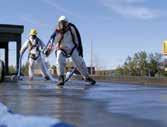


“We’re proud to say that Alaska’s North Terminal now looks the best it ever has,” McKinney says. “Visitors will be inspired to stay and explore Alaska, and Alaskans will have easier access to international travel than ever before.”


Too Much Taxidermy
These days, the North Terminal is quiet but not completely empty. In the last year, more than 14,000 travelers passed through, according to the airport’s communications coordinator, Megan Peters. That’s down from approximately 25,000 pre-pandemic in 2019—barely a planeload per day, year round, and vastly smaller than the 4 million passengers using ANC’s South Terminal annually.
“Anchorage used to bustle as an international hub with travelers connecting from Asia, Russia, and the Lower 48 alike,” McKinney says. The North Terminal was built in the ‘80s when Anchorage was the Air Crossroads of the World for flights avoiding the USSR’s Siberian air corridor. International flights from ANC disappeared after the fall of the Soviet
www.akbizmag.com Alaska Business March 2023 | 33 CONSTRUCTION
Union, leaving the terminal mostly idle except for seasonal flights to Frankfurt, Germany or PetropavlovskKamchatsky, Russia.
In the off-season, the lights are kept on for cargo crews that move through the North Terminal. The fixtures remain much as they were in the early ‘90s, such as the black leather seats slung from tubular frames at each of the gate areas. Vacant concession kiosks still


display ‘90s-vintage signs. The lobby is the same as ever. Maroon carpet has been scuffed and torn over the last thirty years.
Updating the whole building from what McKinney calls “the Reagan administration era” is beyond his company’s reach. “There’s no way we could take over an entire terminal,” he says. “I think there’s probably a little too much taxidermy in there, and

obviously the carpets really, really need to be redone.”
Making a clean spot in Northern Pacific’s leased area lit a fire under the state-owned airport to tidy up the common spaces.
“The North Terminal needed some renovations and some improvements since ’83, so it's about time,” says Todd Petrie of Cornerstone General Contractors. “It also kicked off a couple

34 | March 2023 Alaska Business www.akbizmag.com CONSTRUCTION
Alaska Business
When Northern Pacific’s first jet visited ANC in October, the decor at the North Terminal gate was frozen in time since the late ‘80s.
Installing the bar in the Navigators Club. Cornerstone General Contractors
other state projects that they're working on, as well as circulation finishes and the ticketing gate counter, so it's definitely helping move things forward.”
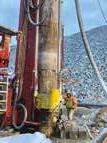

Explore Design

Petrie, who previously oversaw Concourse C construction in the South Terminal, was project manager for the Northern Pacific Airways renovation. But he couldn’t begin until the project had a design, which had its roots in New York City.
One of his first steps toward launching the airline had McKinney contact Forward Media for a branding package. “Edmond Huot [chief creative officer] came up with the name, came up with the livery design and pretty much the whole theme of northern lights, the colors and patterns that carry all the way through our branding,” he recalls.
The branding is one snag that’s keeping the airline grounded, unfortunately. BNSF Railway is suing for trademark infringement. The railroad owns the former Northern Pacific Railway, which was absorbed by the Burlington Northern Railroad in 1970. BNSF claims that it still uses the Northern Pacific name in its branding, which should prevent the airline from registering the name as its own trademark.
McKinney is optimistic that the trademark suit will work out in his favor. “That’s just gonna be a wrinkle in the road,” he says. “They have not used that trademark in fifty years commercially. They can still obviously sell their pillows and T-shirts and all this kind of stuff, and what we do is nothing like a railroad does.”
He’s seeking adjudication in the US Patent and Trademark Office, while the railroad prefers hashing it out in state court in Texas. “I’ve reached out to [BNSF owner] Warren Buffet specifically to see if there’s some amicable way to work this out,” McKinney says.



The railroad certainly has no trademark on the airline’s blackand-silver aurora borealis imagery, which informs the interior decoration.
Cara Rude of MCG Explore Design translated McKinney’s wishes and Huot’s branding into a plan for the construction contractor to follow. Her biography on the company website
that Alaska’s North Terminal
will
Alaska, and
to international
“We’re proud to say
now looks the best it ever has… Visitors
be inspired to stay
and explore
Alaskans will have easier access
travel than ever before.”
907.688.2759 sullivanwaterwells.com We Do DIFFICULT We specialize in difficult drilling & piling Largest dual rotary fleet in the Northwest Family owned & operated for 60+ years DRILLING - PILING - PUMPS Oilfield, mining, and construction support up to 40” diameter www.akbizmag.com Alaska Business March 2023 | 35 CONSTRUCTION
Rob McKinney, CEO, Northern Pacific Airways
notes that her father was a carpenter, and “the smell of sawdust brings back the excitement she felt watching as a child.”
With a design in hand, Cornerstone started preconstruction services in the fall of 2021. Petrie credits MCG Explore Design for a smooth process. “We were able to work collaboratively up front and everything,” he says. “Worked the way it was designed to be.”
Excellence in Construction
The renovation covered 4,600 square feet of lounge space, plus Northern Pacific’s fleet and ground
operations area, ticketing and baggage claim, maintenance and offices, and a backstage area for flight crews.
Rude’s design called for innovative techniques and materials, such as a transparent felt ceiling in the lounge to dampen sound.
“A lot of the products are low VOC [volatile organic compounds],” Petrie says. “The architect likes to have environmentally friendly type components and products in there. The flooring in particular was a special flooring, Chilewich flooring, that definitely has some recycled content.”
Another component of the ceiling
treatment is a drapery made by Cascade Coil, which specializes in wire fabrics. The effect is a gold pattern decorating the lounge’s bar. Petrie notes that the product ordinarily is hung vertically. “Took about four duct jacks and five guys to put that up in the ceiling there,” he says, “so it's a rather interesting and unique system to put in. We had a key guy to help trim it to the right length at the bottom and make sure everything was fit perfectly there.”
Putting up the heavy drape wasn’t the hardest part of the job. What gave Cornerstone the most trouble, Petrie recalls, was demolishing the old security

36 | March 2023 Alaska Business www.akbizmag.com CONSTRUCTION
Testing the slim seats in Northern Pacific’s Experience Theater, an idea CEO Rob McKinney borrowed from IcelandAir to show travelers what they miss by not booking more time in Alaska.
Cornerstone General Contractors
“The North Terminal needed some renovations and some improvements since ‘83, so it's about time… It also kicked off a couple other state projects that they're working on, as well as circulation finishes and the ticketing gate counter, so it's definitely helping move things forward.”
Todd Petrie, Senior Project Manager, Cornerstone General Contractors
We Bank On Alaskans
ACHIEVE MORE northrim.com | (907) 562-0062
At Northrim, we focus on serving the unique needs of Alaska and our neighbors who live here. We provide customized solutions to power your business, including specialized products such as fully FDIC insured sweep options and competitive analyzed accounts. See how a Northrim expert can help your business achieve more.
coils, or mesh curtains that barricade vendor spaces during off hours. “From basically the gate area to the tenant improvement space, there used to be security coils there that were put back in 1983,” he says. “It was unique that we had the guy that installed those back in that time period help us remove those from the building and get them out of there, so it's kind of a special thing.”
For his efforts, Petrie and Cornerstone were recognized by the Associated General Contractors of Alaska with the 2022 Excellence in Construction award for vertical construction between $5 million and $15 million. It’s an honor that Cornerstone General Contractors is used to, being awarded every year going back decades.
Most crucially, the job earned praise from the client. “My hat’s off to both MCG, the architects, and Cornerstone, the contractors,” says McKinney. “They both really knocked this out of the park, and I couldn’t be more pleased with the result.”
New Life
The finished renovation is ready for use as soon as the airline can take off. Cornerstone’s marketing manager, Pearl-Grace Pantaleone, says the project “breathes new life” into the North Terminal, where work continues in early 2023 in the common areas.

“The state is spending some money to improve the circulation areas,” Petrie says. “It'll be some new refurbishments along the way—not completely, but just some nice touches that'll help with the flow of traffic in the Northern Pacific Airways spaces.”
Peters, the ANC spokeswoman, says the faded old carpet is being replaced through May in high traffic areas.
As foot traffic ramps up, McKinney is counting on other amenities to set up shop to serve his passengers. “There’s gonna be vendors back in the North Terminal as well, so it won’t just be our lounge facility,” he says.
Passengers can’t book tickets yet on Northern Pacific Airways, but the airline is getting ready for business. In October, one of its jets circumnavigated its namesake body of water on a “show and tell tour.” Boeing 757-200 628NP took off from Ontario, California (the airline’s maintenance base inland from Los Angeles) and stopped in Maui, Hawaii and then Saipan in the Northern Mariana Islands before landing at ANC and greeting visitors at Gate N5.
McKinney originally hoped to be carrying paying customers shortly afterward, but that was before Russian airspace became a no-go. For a while, the airline explored destinations in Mexico as its first connections from Anchorage, but that ran into technical snags while the Asia-Pacific market opened back up.
For now, McKinney says, “It looks like that is most likely to be our first routes: Saipan to Australia and the Philippines. We’re still working out some of the regulatory hurdles to fly with a partner around Russia to get to Korea and Japan.”
When that 757 emblazoned with the “N” monogram returns to Anchorage for real, Petrie hopes to be back inside the terminal. “Someday in the near future, yes,” he says without hesitation. “I’d like to be on one of the first routes heading out of here, really. See what it looks like to experience Northern Pacific Airways.”
And McKinney, for his part, is grateful for his experience with Cornerstone. “More than what I even expected,” the CEO says. “It’s a beautiful, beautiful space that we have now.”
38 | March 2023 Alaska Business www.akbizmag.com CONSTRUCTION
“The state is spending some money to improve the circulation areas… It'll be some new refurbishments along the way—not completely, but just some nice touches that'll help with the flow of traffic in the Northern Pacific Airways spaces.”
Todd Petrie Senior Project Manager Cornerstone General Contractors
MCG Explore Design and Cornerstone General Contractors created a deluxe hangout for travelers halfway through their trips between East Asia and the Lower 48.
Alaska Business

 by Rachael Kvapil
by Rachael Kvapil

40 | March 2023 Alaska Business www.akbizmag.com CONSTRUCTION
Out in the Cold Constructing buildings for Arctic conditions
US Department of Energy
The same advice for dressing in cold climates applies to structures as well: layering. Contractors apply control layers to the building envelope—the shell of a building that protects occupants from the elements—to manage the water, air, vapor, and temperature within a structure. This complex layering system within the foundation, roof, walls, windows, and doors that make up the building envelope isn't obvious to the untrained eye. However, professional testing will quickly reveal the effectiveness of the control layers that make up the building envelope.
A structure with effective control layers is both durable and comfortable. In general, it has a water-resistive barrier outside of the framing to keep water from getting into the walls, is airtight for energy efficiency, prevents condensation in the walls, and has the right type of insulated walls. Creating this kind of balance in a cold-climate building wasn't always the priority of contractors in Alaska.
Dave Harrell, owner of Northern Home Consulting and former owner of Cold Climate Construction, says there was a big push in the ‘80s and ‘90s to make buildings airtight in the name of energy efficiency. However, it wasn't long before buildings started having problems with decay, mold, radon, and other issues. Harrell says contractors quickly found that sucking out the wet, stale air with an exhaust fan often led to backdrafting, pulling carbon monoxide from heating appliances into the living space and making people sick.
"We learned that the best practice is to have sealed combustion heating appliances and adequate balanced ventilation, such as with a heat recovery ventilation system," says Harrell. "Builders adopted the adage 'build it tight and vent it right.'"






Harrell considers moisture management to be one of the biggest challenges of designing and constructing cold-climate structures. He says moisture management is more than just the precipitation on the exterior of the building and the vapor from underneath but also the management of the moisture produced by those inhabiting the building doing daily activities such as cooking, washing, and

Alaska’s only Independent Polymer-Modified Asphalt Producer • Polymer-Modified Asphalt • Tack Coat • Chipseal Emulsion • Dust Control Emulsion 907-302-1866 DenaliMaterials.com info@denalimaterials.com General | Commercial | Design Build | Construction Management 6591 A Street, Suite 300 | Anchorage, Alaska 99518 907.562.2336 | davisconstructors.com www.akbizmag.com Alaska Business March 2023 | 41 CONSTRUCTION
simply breathing. Properly ventilating a building requires contractors to consider the entire design and specifications— and to be willing to ask for help when they don't know the answer.
The Right Stuff
Of all the materials in the control layers, insulation often gets the most attention. Over the years, manufacturers have developed a range of insulation types with R-values, which measure the insulation's ability to resist heat traveling through it, ranging from R10 to R60. The higher the R-value, the better the thermal performance of the insulation. That doesn't mean that R60 is the automatic choice for a structure. Structures can have insulation with different R-values throughout, depending on the need for temperature control. Added to this are the multiple insulation materials. Though fiberglass is one of the most common insulation materials, there are other options including cellulose mineral wool, polyurethane foam, and polystyrene.
In Alaska, Insulfoam manufactures expanded polystyrene (EPS) rigid foam insulation in Anchorage for distribution in building supply locations statewide. Stu Laidlaw, territory manager for
Insulfoam Alaska, says EPS offers many benefits over other insulation types. As a rigid foam, EPS doesn't suffer the disadvantages of spray foam insulation, including the potential for air bubbles to form during the installation process, which reduces the R-value, or material shrinkage that comes with aging and constant exposure to temperature changes. Compared to other rigid foams, Laidlaw says Insulfoam's manufacturing process ensures that the R-value of their products remains the same over time.

"Blowing agents used in our competitor's products create a scenario where off gassing results in an R-value decrease over time," says Laidlaw. "We don't have that problem. Our products retain the same R-values as the day they were installed."
In addition to being a highly customizable product that is durable and weather resistant, Laidlaw says Insulfoam products are readily available. Since they're manufactured within the state, distributors don't have additional shipping costs that come with products originating in the Lower 48. This results in significant cost savings and the highest R-value per dollar compared to competing rigid insulation like XPS (extruded polystyrene) and
polyisocyanurate. Due to foresight and careful planning, Laidlaw says Insulfoam managed to avoid supply chain disruptions with raw materials, meaning that they've been able to continue manufacturing products at a steady pace.
"The supply chain issues in Alaska are very real," says Laidlaw. "We anticipated the situation and didn't skip a beat getting our product to market at a price Alaskans can afford."
Harrell says contractors have to take the cost and availability of building materials into account more than before COVID-19. He says during the pandemic many builders had to try new products and adjust their methods because familiar materials weren't always accessible.
"There are plenty of good materials that will fail after a short while if installed incorrectly," says Harrell.
Harrell has seen this problem firsthand as a contractor and through his consulting firm in Talkeetna. He says the majority of Alaska doesn't have rules or regulations for building construction, and without a statewide building code, he finds a lot of Alaskans strike out to the rural areas and build their dream home or cabin without rules or interference. Unfortunately,
42 | March 2023 Alaska Business www.akbizmag.com CONSTRUCTION
Workers weatherize the Lakeview Lodge in Minto. Russell Snyder | Interior Regional Housing Authority | US Department of Energy



many of these Alaskans get in over their heads with disastrous results, and often they turn around and sell their home or cabin to someone who has no idea what they are walking into.
"Alaska is a fiercely independent place. So many of us want to do it ourselves and be stubbornly selfreliant," says Harrell. “I'm all for freedom and liberty, but I've seen this situation play out time and time again. When our government can't enforce rules and codes, which is hard at times, then we need to at least provide resources, education, and incentives so our housing stock isn't made up of falling down, rotting, dangerous homes."
Harrell recommends people check out the resources available on the Alaska Housing Finance Corporation and Cold Climate Housing Research Center (CCHRC) websites, two organizations taking the lead in providing information and research into new cold climate technologies and methodologies. Though he thinks the technology and methodology for retrofitting existing homes is improving, there's less work to weatherproof a home during the initial construction phases. When it comes to remodeling and renovating homes for cold climates, Harrell says people most likely will not get everything they want, since some ideas are not practical or cost effective.
Innovations in Building Science
Cold-climate construction is constantly evolving, though people may not see the results of that innovation right away. Benjamin Callahan, president of Callahan Construction Company in North Pole, says many times initial innovations happen either on the job site or at the engineering level.

"It takes a few years and some realworld examples before we start to see the newer ideas incorporated into state or federal projects," says Callahan. "I think the acceptance of new concepts and ideas are more frequent now than twenty years ago. Energy conservation is on everybody’s radar."
With finite resources, Callahan says contractors need to build structures that will still serve the needs of future
generations. Likewise, Harrell says the need for buildings will always be a crucial part of human existence, so it makes sense to construct safe, healthy, long-lasting buildings. Harrell says there is a growing trend for high performance homes designed to be Net Zero, where the energy a home consumes equals the energy it can generate. In 2022, Harrell pulled together his previous experience as a contractor and energy rater to help build a Net Zero home using a ground source heat pump and a large roof-mounted solar panel array. His company is currently collecting data to see if they have met their Net Zero goal.
foam board is attached to the vapor barrier. The key is to use enough foam so that two-thirds of the total wall R-value is located on the outside. The goal is to keep the point at which vapor turns to water (the dew point) outside the vapor barrier and warm-side wall cavities. This ensures the framing stays warm and dry. CCHRC has tested and refined the REMOTE wall in various climates of Alaska, and includes resources, a detailed construction manual, and a two-part video showing the step-by-step process of building a REMOTE wall on their website.
"We don't want to waste money and resources on creating buildings that won't last," says Harrell. "It's not just an environmental issue or a monetary issue. It's a social issue."
Harrell says one of the most significant recent innovations came from CCHRC when it started pushing the REMOTE (Residential Exterior Membrane Outside insulation TEchnique) wall system. CCHRC—a laboratory in Fairbanks established by the building industry in 1999—adapted the PERSIST (Pressure Equalized Rain Screen Insulated Structure Technique) wall technique used in northern Canada to form the REMOTE wall, which moves most of the insulation to the outside of the wall to keep the sheathing warm and dry. The vapor barrier is applied outside of the sheathing, rather than inside, and then
"The REMOTE wall system really got people to recognize that thermal bridging, the heat transfer through materials, was important and airtightness could be significantly improved," says Harrell.

CCHRC features several videos, construction manuals, and step-by-step instructions for both new construction projects and retrofits that meet coldclimate construction specs. They also have additional information about alternative energy sources and current building science research in Alaska.
Callahan cautions that there is no single method of building a coldclimate structure in Alaska. Techniques and materials are not necessarily the same as in other places that experience subzero temperatures, and he adds that environmental factors vary across the vastness of the state, affecting the combination of building materials and how they're installed.
"Building in Fairbanks is different than Anchorage," says Callahan. "Building in Fort Greely is different than Fairbanks. You must have experience, but also be willing to try new ideas."
44 | March 2023 Alaska Business www.akbizmag.com CONSTRUCTION
Callahan Construction
Callahan Construction




www.CraigTaylorEquipment www.PeterbiltAlaska.com
Community Transportation Infrastructure
How the CTP and TAP build local projects
By Dimitra Lavrakas
From bridges, roads, and trails to storm water drainage, habitat connectivity, and scenic overlooks, the Alaska Department of Transportation and Public Facilities’ (DOT&PF) Community Transportation Program (CTP) and Transportation Alternative Program (TAP) are all about getting from here to there. In September, DOT&PF opened the application period for the most recent funding cycle with up to $120 million to spend on CTP projects and up to $30 million for TAP projects.
“It’s been years since we put out a call for projects under the CTP Program,” said DOT&PF Commissioner Ryan Anderson in a press release. “These funds help our communities build

46 | March 2023 Alaska Business www.akbizmag.com CONSTRUCTION
transportation infrastructure that is sustainable, improves safety, addresses resiliency, and supports economic development.”
Cash for Communities
CTP projects for this round of funding can address any of the following goals: improve existing surface transportation facilities; improve or make new transportation facilities that provide access to important resources or connect communities; improve rural ports and barge landings; connect different types of transportation modes, such as transit and trails or roads; enhance travel and tourism; add electric vehicle charging infrastructure; or reduce wildlife-vehicle collisions.
www.akbizmag.com
TAP projects may include on-road and off-road facilities for pedestrians and bicyclists; safe routes for nondrivers, formerly called Safe Routes to School; converting abandoned railroad corridors into trails for non-motorized transportation users; creating turnouts, scenic overlooks, and viewing areas; supporting historic preservation and rehabilitation; supporting environmental mitigation related to stormwater and habitat connectivity; conducting vulnerable road user safety assessments; or installing streetlights.
During the application phase last September and October, communities could submit a Notice of Intent to Apply complete with project title, location, scope, a short justification,


Alaska Business March 2023 | 47 CONSTRUCTION
Corvus Design
and a completed screening. Phase II from November through February is the Call for Projects, a period to determine eligibility and prepare a scope, schedule, and cost estimate. This is the time communities develop full applications for projects found eligible. This month and next, DOT&PF is preparing packets that score each project. The Statewide Project Evaluation Board meets next month and will announce in May which projects receive funding.
All projects require a 9.03 percent local funding match.
Just by completing the Notice of Intent online using the project intake survey, communities can choose to have their projects analyzed for other funding opportunities beyond CTP and TAP. DOT&PF and the Alaska Municipal League also work with communities to help determine which projects are eligible and assist communities in strengthening the applications.
Each public entity is allowed to submit only two CTP projects, with a not-to-exceed federal share amount of $15 million. TAP projects are limited to two project submittals per community with a limit of $5 million in federal funding, although the total

cost of the project may exceed the federal share if the community has identified additional, alternative nonfederal funding.
Both programs advance the DOT&PF mission statement: “Keep Alaska moving through service and infrastructure.”
Maren Brantner, manager of DOT&PF’s Statewide Transportation Improvement Program (STIP), is responsible for maintaining the federally required and fiscally constrained four-year transportation plan for the state. Her section manages several competitive funding programs and coordinates with various other transportation plans.
“Minor changes were made to the criteria this round,” Brantner says. “These changes were available for public review and comment prior to approval.”
So far, she says, 192 intake surveys have been received and are still being reviewed for eligibility for state funding opportunities. After the surveys are matched with an appropriate program, the processing of project applications begins.
Julius Adolfsson, a statewide bicycle and pedestrian coordinator and rural transit planner at DOT&PF, says close to sixty-four Notices of Intent to Apply have been received for TAP funding.
“It’s been years since we put out a call for projects under the CTP Program… These funds help our communities build transportation infrastructure that is sustainable, improves safety, addresses resiliency, and supports economic development.”
Ryan Anderson Commissioner Alaska DOT&PF
Sitka and the National Park Service have agreed to extend the sea walk, but the middle section (in blue) requires expensive shoreline construction.
48 | March 2023 Alaska Business www.akbizmag.com CONSTRUCTION
City and Borough of Sitka
Cordova Takes Steps




One example of a past TAP project is a pedestrian amenity in Cordova. A stairway to improve foot traffic was built between the town’s waterfront and the civic building that contains the public library and historical museum on the main avenue, 1st Street.
Mayor David Allison announced the project in September 2021: “The new Cordova Center stairs are officially under construction! They will connect the harbor and Railroad Avenue to Main Street via a covered, lighted pedestrian stairway on the south side of the Cordova Center.”
The grand ribbon cutting came in April 2022. “We hope you’re as excited as we are for them to be finished,” the mayor added. “No more taking the long way around!”

Ninety percent of the funds for the Cordova stairway were provided by TAP, with federal funding of $375,174 and a match of $41,825 for a total of $417,000.
“People really like it,” says Cordova Historical Museum Director Mimi Briggs. “They use it for exercise because it’s a covered walkway and use it to come up from the harbor. We’re happy we finally got them.”
Before the stairway, the walking path between Cordova’s harbor and 1st Street detoured a couple blocks north or south of the Cordova Center.
“It’s been a game-changer,” says Cordova City Manager Helen Howarth. “Built on a mountainside with the harbor separated from us, and the harbor is our important infrastructure because we’re a fishing town. The stairwell provides easy access to downtown for groceries.”



It is also, she says, an easier way for children at Mt. Eccles Elementary School to go to the city swimming pool, downhill on Railroad Drive, rather than being bused less than a mile.

Reportedly the Cordova Volunteer Fire Department also uses the stairway for training.
“Yes, that is correct. Fire department members are using those stairs for training and physical fitness, wearing a full set of our fire personal protection equipment, a.k.a. bunker gear, and our self-contained breathing apparatus,” says Cordova Fire Marshal and Deputy Fire Chief Paul Trumblee.
800-528-4916 www.FountainheadHotels.com Our new Summit Suite is the finest room in Fairbanks, and impressive for VIP experiences or corporate retreats. Locally-owned and operated in Fairbanks, Alaska Take a Tour! RESET. REGROUP. RECONNECT. www.akbizmag.com Alaska Business March 2023 | 49 CONSTRUCTION
A little imagination and less than half a million dollars make a big difference in a small town.

Sitka Looks Forward to Sea Walk
For more than ten times the cash, Sitka has been pursuing a pedestrian project for more than ten years. The Sitka Sea Walk was initiated in 2011 to link Sitka National Historical Park to the cruise ship docks. It is designed as a destination for both locals and visitors and a waterfront showcase.
The proposed extension is split into three sections, from the current end of the sea walk built in Phase I to three Phase II sections, each about one-tenth of a mile, from Crescent Harbor to Totem Square and Lincoln Street.
All three sections have a total cost of $5.4 million, with the middle section along the shore eating up 80 percent of the price tag for the phase.

Phase I was completed and opened in 2013. Design on the segment to reach the visitor center began in 2020, and construction is set to start on that segment this year.
“We have completed preliminary design and scoping,” says Amy Ainslie, planning director for the City and Borough of Sitka. “These documents were presented to the public here in Sitka on November 30, and we had an open public comment period, which ended on January 4. We are currently awaiting completion of the environmental impact assessment.”
Ainslie says Phase I was very successful, and that portion of the sea walk is heavily used by locals and visitors alike and “has become a beloved community asset.”
Project Coordinator Kelli Cropper agrees. “It’s fantastic. It’s so heavily used and well loved,” she says. “I use it and it’s always crowded. Now we’re working on continuing it all the way to the end of town.”
Team Project Manager Tyler Bradshaw, who works out of PND Engineers' Juneau office, says that the public comment period and community information meetings are now complete, and the project is moving forward into final design. He anticipates construction will start in 2024.
The lights of the fishing boats Port of Cordova twinkle as seen from the Cordova Center stairs. Boaters can now access the city's shopping avenue more directly from the harbor.
City of Cordova
The new Cordova Center stairway opened in 2021, and many members of the community take advantage of them, including swimmers accessing the city pool at the bottom and firefighters running drills.
50 | March 2023 Alaska Business www.akbizmag.com CONSTRUCTION
City of Cordova






























At Petro 49, Inc., our mission is to provide best-in-class service and support We offer innovative solutions that positively impact our customers’ bottom line, and we believe in winning together Thank you for over six decades of partnership and trust ALAS K AN-O W NED SIN C E 19 5 9 petromarineser vices.com | shoresidepetroleum.com | north60petro.ca PETRO 49 c om p a nie s Whittier Seward Anchorage Wasilla Cordova Soldotna Homer Kodiak Sitka Skagway Juneau Petersbu Wr Craig Ketchikan Dawson City Stewart Crossing Watson Lake Haines Junction Whitehorse Fueling industries that fuel our economy.
Honing In
Specialty contractors

sharpen skills for market niches
By Rindi White
52 | March 2023 Alaska Business www.akbizmag.com CONSTRUCTION
Every construction company launches with a single project. How companies evolve from there depends on the market, clients, and the inclination of the owners. While diversity has its strength, for some construction companies, specialization has laid out a path for success.
Denali General Contracting, as the name implies, is not a specialist, yet the Anchorage-based company boasts a specialty: it’s prepared for projects in rural Alaska. Remote work takes a special skill set—advanced logistics, excellent attention to detail and, above all, a love for working in rural Alaska.

“You have to be prepared, you have to be organized, you have to be comfortable in that environment, and your team needs to be comfortable in that environment,” says Chris Hamre, president of Denali General.
At a job site in Anchorage, not having a tool or part can be fixed with a trip to the hardware store. Working remotely, small errors like that can cost time and significantly more money.






Making a rural project successful boils down to good planning, Hamre says. Ideally, projects are bid and planned over winter; Hamre’s goal is to have materials delivered dockside in Seattle by April, ready for a May shipment to Alaska and then consolidated for barges to the project site. The first barge has items for excavation and pouring concrete, and each subsequent shipment should contain materials needed for the next steps of the project. Hopefully everything arrives according to schedule and the work plan; if not, and the last barge of the year is missed, items might have to come via air freight or, in extreme cases, a plane might need to be chartered.
The timing of materials and equipment is key, but so is building a strong team, Hamre says. It’s easiest to work with people who are comfortable working a remote job; the hours are long, and the uninitiated might find it difficult to be away from home for a longer stretch.


Hamre says Denali General, celebrating its 40th year in business, has been working in rural Alaska for about thirty years, starting with a project in Bethel. Lessons were learned through that project, he says, including better planning for housing. Hamre has since

STG LEADING PROVIDER OF REMOTE ALASKA INFRASTRUCTURE CONSTRUCTION & MAINTENANCE SERVICES SINCE 1995 301 W. Northern Lights Blvd., Suite 300 Anchorage, AK 99503 907-278-6600 Conamco.com www.akbizmag.com Alaska Business March 2023 | 53 CONSTRUCTION
A roof renovation at Goldenview Middle School in South Anchorage initially called for a complete tear-off, but Alaska Roof Restorations used thermal imaging to determine only 2,000 of 100,000 square feet needed replacement. The rest of the roof was given a monolithic slab covering to extend its useful life by another twenty years.

purchased man camps that can be set up at some rural job sites, or he looks for local housing on others. Making sure workers are well rested and well fed is critical, he says.
“When a guy gets on a plane, we are responsible for him until he gets back off the plane in Anchorage. Those guys are working hard—we make sure they have a warm bed and a good meal,” he says.
Top of the Field
Roofing is already a specialized craft. Alaska Roof Restorations occupies an even narrower niche: the company repairs and restores flat, low-slope, and metal roofs, saving owners the cost and waste of completely reroofing a building.

“We’re the only ones that do specifically what we do; there are other companies out there spraying
roofs—we restore the roof assembly and the surface,” says Tyler Moor, president and founder of Alaska Roof Restorations.
Moor is a painter by trade, working in Alaska since 2014, and he also runs a drywall company. He says he started coating roofs to restore membranes and metal roofs, but the process evolved over time. His method currently involves assessing the damage on
Alaska Roof Restorations
54 | March 2023 Alaska Business www.akbizmag.com CONSTRUCTION
a roof—through collecting cores or thermal imaging—and repairing those sections before creating a new fluid-applied membrane over the whole roof that will last twenty to twenty-five years.






“We primarily restore commercial and industrial roofs,” Moor says. “The other roof that lends itself to what we do is… the pre-engineered metal buildings with the roof fastened onto

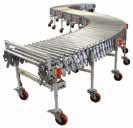










the structure. If you have a large, pre-engineered metal building, you have thousands of fasteners. As roofs move, those fasteners tend to come loose.”





In the case of a flat roof—like the roof on Goldenview Middle school in South Anchorage, which the company restored in 2020—a roof might have a few wet, damaged areas that must first be identified,
cut out and repaired with new wood, insulation, and cover board. Then the whole roof is covered in a thick, seamless monolithic polyurea base coat; silicone coating is applied as the top coat. The silicone coating alone can extend the life of the roof fifteen to twenty years, he says.
For the middle school, a full roof tear-off and replacement was initially planned. Moor’s analysis revealed
Denali General Contractors MATERIAL FLOW AND CONVEYOR SYSTEMS INC. Toll Free 877-868-3569 Phone 907-868-4725 Fax 907-868-4726 6112 Petersburg St. Anchorage, AK 99507 Visit Our Website: www.materialflow.com PALLET RACK Used and New Mezzanines - All Sizes and Types Two / Three Story Structures • Cantilever Racks • Bulk Racks • Mezzanines • Lockers • Steel Shelving • Work Benches IN-STOCK IN-STOCK IN-STOCK IN-STOCK IN-STOCK IN-STOCK Manual Pallet Jacks • Gravity & Powered Conveyors • Bubble Wrap • Stretch Wrap Machines • Carousels • Turntables Hilman Rollers Plastic Bulk Boxes Plastic Bins Stretch Wrap - All Types Self Dumping Hoppers Steel Banding / Tools Packaging Supplies IN-STOCK Casters INMidwest Warehouse 100 Models in Shipment Sealing Tape MANY SIZES AVAILABLE Bulk Shelving & Racks • Carts • Hand Trucks • Platform Trucks Power Flex Conveyors Steel Aluminum Gravity Roller Conveyors www.akbizmag.com Alaska Business March 2023 | 55 CONSTRUCTION
Denali
General Contractors employed its experience in logistics for rural Alaska during the four-year restoration and update of the UAF Nome campus.
that only about 2,000 square feet of the 100,000-square-foot roof was damaged and in need of replacement, so just those areas were repaired and the whole roof recoated, resulting in a significant cost savings to the Anchorage School District. When the roof reaches the end of its next life cycle, he says, the top coat can be reapplied, creating a renewable roof system that will never need to be torn off again.

The restoration system Moor uses is fairly new to Alaska, although it is used all over the world, often in northern climates. His company has used the system throughout Alaska, from Southeast to Nome, both on and off the road system.
Create Your Own Options
Contractors that supply parts and equipment can specialize by focusing on an elite customer base. Palmerbased Triverus began with exactly fourteen possible customers, namely the nations that operate aircraft carriers, of which there are only fortyseven afloat in the world. Triverus
manufactures machines that clean the decks of aircraft carriers. The company started in a two-car garage in Anchorage’s Muldoon neighborhood, responding to a federal Small Business
Innovation Research Program announcement requesting a unique innovation to keep decks of aircraft carriers clean while also restoring the friction necessary to allow jets to safely take off and land. The innovation also needed to prevent pollution—not wash dripped fuel or chemicals into the ocean as part of the cleaning process, for example.
Just getting taken seriously was a challenge, says Triverus CEO Hans Vogel. The company submitted a white paper outlining its proposed solution, but it wasn’t until it could show a 3D model that Triverus was seen as a legitimate contender. The company won an award to build a prototype in 2001, followed by several years of intermittent funding and other obstacles before it achieved a working machine that used high-pressure water, which was then filtered and recycled within the machine. By then the company had built its own facility at the Palmer Business District, a city-designated zone for manufacturing, warehouses, and distribution, with easy access to rail and road.
“We’re the only ones that do specifically what we do; there are other companies out there spraying roofs—we restore the roof assembly and the surface.”
Tyler Moor
56 | March 2023 Alaska Business www.akbizmag.com CONSTRUCTION
Founder and President Alaska
Roof Restorations




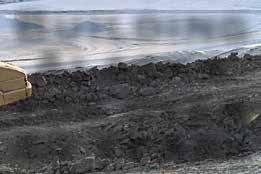


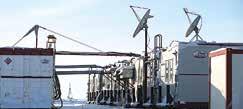
 The Mobile Cleaning Recovery Recycle System vehicle invented by Triverus in its natural habitat: scrubbing the deck of a US Navy aircraft carrier.
Triverus
The assembly of cleaning vehicles at Triverus’ manufacturing plant in Palmer.
The Mobile Cleaning Recovery Recycle System vehicle invented by Triverus in its natural habitat: scrubbing the deck of a US Navy aircraft carrier.
Triverus
The assembly of cleaning vehicles at Triverus’ manufacturing plant in Palmer.
Building Alaska for over 40 years • Heavy Civil • Oil Field • Marine Transportation • Camps PALMER: 907.746.3144 | DEADHORSE: 907.670.2506 | KENAI: 907.283.1085 | ONLINE AT CRUZCONSTRUCT.COM www.akbizmag.com Alaska Business March 2023 | 57 CONSTRUCTION
Triverus
STG can do just about any construction job in Alaska, but the company’s niche is erecting and maintaining telecommunications towers.


STG 58 | March 2023 Alaska Business www.akbizmag.com CONSTRUCTION
Along the way, Triverus strove to find vendors—preferably Alaska vendors—to supply the parts it needed. Specialization can be lonely.
“We had a design that was progressing, but Alaska didn’t have enough vendors to do the direct-todigital design that we needed,” Vogel says. “There were welding companies, but not enough vendors that could design out of different materials. These are large, complicated pieces of equipment. There are thousands of parts—this thing is as complicated as a helicopter.”
Thus, TriJet was formed—a manufacturing company also located at the business park in Palmer, to create the parts needed for Triverus’ mobile cleaning, recovery, and recycling system. TriJet independently contracts with other companies that need direct-to-digital parts manufactured.
The funding process for Triverus’ cleaning machine had fits and starts throughout, Vogel says. The initial prototype tested well in Norfolk, Virginia, but a few more prototypes sat idle in Palmer. Then two US Navy
amphibious assault ships were afflicted with particles on the flight deck that caused problems with Harrier jump jets, and an effective cleaner was needed. Two of Triverus’ machines were called in, and in less than two weeks the small carriers were certified to operate again. After a few more hiccups, Triverus jumped into full production—more than forty-three have been sold to the US Navy. Triverus sends employees out to assemble the machines and provides a week of training on maintenance and operation.
Successful Spinoff
From white paper to manufacturing took fifteen years. Vogel says he and others at Triverus learned a lot along the way. The company is still making new machines, maintaining existing machines, and expanding into other commercial cleaning and environmental cleaning markets. The COVID-19 pandemic put a damper on growth in the municipal and commercial sectors, but the company saw a rebound in 2022 and recently began shipping machines again.
“We’ve been really aggressive on the commercial side of this. We also have a surface cleaning business; we go out and do stormwater pollution prevention cleaning on the East and West Coasts,” he says. “Part of our big success was, we were able to focus on the Navy [proposal] and then transition… The Navy is not going to continue to buy these things.”
Meanwhile, TriJet has become a success in its own right. It operates separately, Vogel says, with different leadership, a different building, a different mindset. Customers other than Triverus are now its core clientele, mostly in the oil and gas, mining, and aerospace sectors.
“They give us parts they want us to make, and we make them—on time, every day. That’s what we do," Vogel says.
One of TriJet’s primary customers is The Launch Company in Anchorage, which provides ground support hardware and infrastructure for other rocket-launching companies.
“These are small components but they’re high value, and we make

www.akbizmag.com Alaska Business March 2023 | 59 CONSTRUCTION
Specializing by Generalizing
By Rindi White
In the crowded field of equipment suppliers, how does one stand out? For Yukon Equipment, flexibility is the company’s specialty. Whether leasing a loader in Kotzebue or servicing a broken backhoe in Bethel, for seventyfive years, the company has been evolving to meet the needs of its Alaska clients.
“We’re not the biggest equipment dealer in the state, but we are the most flexible,” says Charlie Klever, president of Yukon Equipment. The company, owned by Calista Corporation since 2010, operates three locations: its headquarters in Anchorage and branches in Wasilla and Fairbanks.

“As such we can change our business plan and adjust to the market much more quickly and, we think, more efficiently,” he says.
“The last few years we have really put an emphasis on our village and remote sales, partially because one of our mission statements is to supply support and benefit to the region—the Calista region, the Bethel area,” he says. “We sell equipment to villages and remote sites all over the state. We’ve gotten quite efficient at that.”
Klever says the company will rent the equipment and later sell it. A new machine circulates through the rental fleet for three years before being sold, which presents an affordable option for villages. ”They can buy several pieces of equipment instead of just one for half a million dollars,” Klever explains.
The company also does a brisk business in renting or leasing to homeowners and small contractors, he says, and that market is trending toward ownership lately.
Klever says, “When the opportunity arose, we were able to expand that opportunity. We had the customers, we had the demand, we could get the equipment, and it was wise for us to expand; we weren’t taking a leap of faith.”
hundreds of different components,” Vogel says. By focusing on familiar industry sectors, he says TriJet is positioning itself as a world-class specialized parts supplier. Or, as he puts it, “Can we make this as good as it would be made in the South 48?”
Do Good Work, Then Do It Again
Since its origins as St. George Construction in Kotzebue to its expansion and relocation to Anchorage, STG has done it all, from fuel systems and electrical grids to bridges and waterfronts. Its subsidiaries range from expertise in pilings and foundations to hoisting cranes 400 feet high. Lately, STG has become the go-to contractor for a certain type of structure: telecommunications towers, even on mountaintops.
The telecom portion of STG’s business has expanded in the last three years, says company president Brennan Walsh. He believes it will expand further as federal spending to increase broadband availability throughout Alaska begins to flow into the state.
STG isn’t new to tower construction; the company has been building towers for more than twenty years.
STG worked with internet provider GCI over the past several years to help the company execute its GCITERRA network, a 3,300-mile terrestrial broadband network that connects remote communities with Anchorage. Now, Walsh says, STG is called in to help maintain the towers built as part of that and other projects.
The difference is that demand for STG’s telecom work is increasing. The company stands ready to meet the demand.
“We have certified tower climbers and enough technicians. We have enough work to keep a couple of crews busy with tower work throughout the state,” Walsh says.
The work is pretty much yearround; the work slows in the winter, but the tower crews are still called out for emergency repairs. Walsh says moving toward telecom has helped to diversify STG’s business. That is, narrowing its specialty broadened the company’s portfolio of clients.
60 | March 2023 Alaska Business www.akbizmag.com CONSTRUCTION
Yukon Equipment

Paved Paradise
The development impact of parking requirements
By Scott Rhode
Hunting for a parking space can be frustrating, but excess parking spaces can plague a city and its inhabitants in quiet yet pernicious ways.
“Right now, we have these huge surface area parking lots that push everything farther apart. It extends the distance that people have to navigate our city if they’re on foot, if they’re not in a car,” says Daniel Volland, who joined the Anchorage Assembly in 2022 when a twelfth district was added to the body, representing the Downtown area. He adds that navigating is even harder for pedestrians with mobility disabilities, due to poor infrastructure.

Parking lots also add to the scarcity of developable land in the Anchorage Bowl. “I've heard many times over the years, people say Anchorage is running out of land,” says Jeannette Lee, a senior researcher with the Sightline Institute. “Well, how about, actually, Anchorage is using its land very inefficiently, with parking mandates being one example of that.”
From her Anchorage office, Lee is the Alaska lead for the Oregon-based nonprofit that advocates on housing, urban policy, and governance issues. She co-authored a report about parking mandates, citing a city-funded study that found one-quarter of spaces were empty during peak periods. Only four out of thirty-five sites surveyed filled all the parking required by Anchorage’s land use code, Title 21.
The Sightline report noted other problems associated with overbuilding of parking, such as paving over natural areas, the urban heat island effect, and added costs for housing and business development.
Jacob Boomsma iStock
62 | March 2023 Alaska Business www.akbizmag.com CONSTRUCTION
For all those reasons, the Anchorage Assembly voted unanimously in November to wipe out parking requirements citywide. Effective January 23, 2023, the amount of parking is left to the judgment of individual developers.
Limiting Uses

Title 21 listed more than 100 business and housing types and assigned each a minimum number of parking spots required. “For instance, if you were a bowling alley in Anchorage, you had to have four parking spaces for every one bowling lane,” Volland explains. “You’re constantly assuming that nobody carpools and that every night is league night and it’s always maximum capacity.”
Dictating the use of land outdoors could constrain the use of interior space. Michelle Klouda, a principal and owner at RIM Architects, faced that obstacle during the renovation of the Midtown Mall. “When you go into that parking lot, half of it is empty, and the development costs to bring that parking lot up to the current standards
for landscaping and so on was pretty high,” she recalls. “But it also restricts the ability for that property to be able to expand its footprint. We were limited in the uses that we put into that building, so we changed some of the uses [so they] didn't exceed the parking that was currently there.”
Variances were possible but not easy to obtain. Turnagain Brewing near Taku Lake spent a year on a parking study after city authorities discovered that the property was six spots shy of the minimum. The study confirmed what the brewery already knew: there’s plenty of parking on King Street during evening hours when the venue is open. The company was one of about twenty that year to receive a variance.
Volland notes that another brewer wanted to convert parking spots into a garden with tables, which slammed against the minimum requirement. Alaska Behavioral Health also had to postpone a clinic expansion because it couldn’t afford to add parking.
“You may preclude certain types of businesses from going in there












We
able
no.”
“Is our city going to run out of parking spots the day after we do this? Are people going to be cruising the streets and snarling up the roads
looking for parking?
were
to say
1040 O’Malley Road, Anchorage, AK 99515 “Serving the Community Since 1938” Anchorage Sand and Gravel Co., Inc. 888-349-3133 | 907-349-3333 | www.anchsand.com www.akbizmag.com Alaska Business March 2023 | 63 CONSTRUCTION
Jeannette Lee Senior Researcher Sightline Institute
based on the amount of parking that is required,” he says. “What is better for Anchorage: an empty building with ample parking or a revitalized building that’s open for business?”
Mandate Debate
Why do cities inflict parking mandates on themselves, if the rules are so onerous? Because they are supposed to solve the problem of not enough parking.
“If a private developer does not have enough parking, what happens? Where does the demand created by that use find parking? On streets or on a neighboring private property,” explains former municipal planner Tyler Robinson, now vice president of community development, real estate, and planning at Cook Inlet Housing Authority.
As written, Title 21 requirements were never a guarantee of sufficient parking. “When you see a parking ‘problem,’ where demand seems to exceed supply, it may very well be on a site that meets or even exceeds code,” says Robinson. “Think about popular
restaurants or busy lunch hour gyms or health clubs.”
For instance, Bear Tooth Theatrepub added an extra parking lot when a restaurant was added to the former Denali Theater, to comply with code, yet visitors often spill onto side streets. The business is a victim of its own success.


“In a city designed around cars, the default mode of thinking is that, yes, we should require, often at great expense, vehicle parking, but not bicycle parking or pedestrian facilities,” Volland says. “How do you weigh those values?”
The ordinance that passed the Assembly began with the municipal planning department exploring a more modest revision in certain areas of the city. The proposal caught Volland’s eye as a vehicle for broader change, and he found support from another new member, Kevin Cross.
A former chair of the Anchorage Platting Board, Cross represents a conservative constituency in Chugiak/Eagle River, yet his interests aligned with Volland’s progressive urbanist goals.
64 | March 2023 Alaska Business www.akbizmag.com CONSTRUCTION








The new South Anchorage branch of Credit Union 1 was recently built in compliance with the previous Title 21 parking minimum, whether all the spaces were needed or not.
• Bridges • Roads • Site Work • Environmental Cleanup Specializing in: SBA Certified HUBZone & DBE (907) 357-2238 | www.tutkallc.com WHERE ENGINEERING MEETS THE ENVIRONMENT. CATEGORY WINNER: General Contractors www.akbizmag.com Alaska Business March 2023 | 65 CONSTRUCTION
Bob Clark | DOWL
The unanimous vote, Volland says, was a result of showing how the ordinance could be a positive win for everyone. On one hand, it shreds bureaucratic red tape, the bane of the Assembly’s conservative wing. On the other, it advances progressive goals with broad appeal.
The role of Sightline Institute during the debate was to provide a national context, Lee says. “Even the planning department wanted to know, rightly so, what happened in other cities when they took away parking mandates. Is our city going to run out of parking spots the day after we do this? Are people going to be cruising the streets and snarling up the roads looking for parking? We were able to say no.”
Lee points to the examples of Buffalo, New York; Minneapolis, Minnesota; and Edmonton, Alberta. “All these places have done away with parking mandates,” she says. “They’re snowy, cold cities too, and it's been fine and actually beneficial.”


Breaking Free
Buffalo was the first US city to abolish parking minimums for new
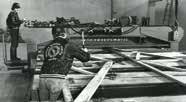
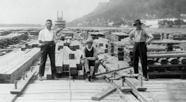
 When the Anchorage Assembly abolished parking mandates in November, Mayor Dave Bronson congratulated them by posting this image of a lot being converted into Block 96 Flats (although, being downtown, it was not subject to the mandate).
When the Anchorage Assembly abolished parking mandates in November, Mayor Dave Bronson congratulated them by posting this image of a lot being converted into Block 96 Flats (although, being downtown, it was not subject to the mandate).
Alaska’s Choice for Building Materials Since 1952. PRODUCTS & SERVICES: • Civil, Structural, Industrial • Commercial / Multi-Family • Custom Millwork • Design Services • Installed Services • Logistics / Distribution • Residential / Remodel • Rural Services • Trusses • Wall Panels At SBS, we partner with our customers through every aspect of
phases,
the
on the
We are there to assist customers
start to
Residential to commercial and everything in between, SBS is dedicated to being your strategic partner on any construction project. | WWW.SBSALASKA.COM 66 | March 2023 Alaska Business www.akbizmag.com CONSTRUCTION
Catie Gould | Sightline Institute
construction
from foundation coatings, to
shingles
roof.
from
finish.
development. In more than five years since, vacant and underutilized structures have come back to life.
When new projects are built in Anchorage, they will have more flexibility. “A multi-family over twentyfive dwelling units or commercial over 20,000 square feet, there’s a menu of options they can choose from,” Volland explains. “They can pick which requirement fits their development best. Things like an enhanced pedestrian walkway or having more bike storage than what is required. Paying for their tenants to have transit, things like that.”

Volland notes that market-based incentives are already working in the one part of Anchorage that hasn’t had parking requirements since the ‘60s: his own Downtown district. He cites the examples of Elizabeth Place, recently built by the Central Council of Tlingit & Haida Indian Tribes of Alaska, and the new developments at Block 96 Flats and at Block 41, where the 4th Avenue Theatre stood until recently. “They are all including parking despite the fact that they don’t have to,”

Volland says. “Why? They know that their customers and their tenants are going to want it.”



Klouda envisions similar developments spreading out citywide. “Right now, it generally doesn't pencil for developers, so they're not ambitious in developing residential. But if they were able to increase the square footage of their residential property, decrease square footage of the parking requirements of the lot— they begin to get more units on that property and begin to start to make things actually pencil out,” she says.
“And it doesn’t mean that no new parking will ever get built here,” Lee adds. “Just that it’ll be up to the people who know their projects best— Alaskans expanding their businesses or building the new homes and apartments that we need—to make the call on how much parking to include in their designs.”
What about the free-rider problem that parking mandates were meant to solve? “I don’t think we’re going to have a tragedy of the commons situation,” Volland says. He notes that

“In a city designed around cars, the default mode of thinking is that, yes, we should require, often at great expense, vehicle parking, but not bicycle parking or pedestrian facilities… How do you weigh those values?”
Daniel Volland District 1 Member Anchorage Assembly
Let us make your dreams more than just drawings p: 907.563.7441 e: info@wccak.com Alaska’s Alternate Delivery Specialists www.akbizmag.com Alaska Business March 2023 | 67 CONSTRUCTION
Image resources: Kevin G. Smith Photography & Spark Design, llc
his optometry clinic in Downtown, Ursa Optical, pays for parking as part of his lease, despite the lack of a mandate.
Klouda is also optimistic, if a little more cautious. “There is going to be a conflict in that, especially in the near future, especially if our public transportation is not up to the ability to take that over,” she says. “But we're also looking at good operators, good building owners. They're trying to make it successful.”
As a bonus, Klouda points out that the city benefits by trading empty space for taxable improvements. “Just the amount of building development that could happen versus parking,” she says, “that ratio of more building that's on that property means that assessed value of that property is higher. Which means more taxes. Which means more money back into the city.”
People, Not Cars
Because the ordinance only affects new developments, “People are not going to see radical change overnight or even over the course of a year or two,” Lee says. “It’ll be really incremental.”
Robinson wonders what the future holds. Will older properties redevelop, as promised? Will new developments build fewer spaces than the old minimums? Will streets be built with more parking capacity? Will transit ridership increase?

“I’m not sure I have the answers to what will happen overall,” Robinson says. He can only speak for Cook Inlet Housing Authority. “We will analyze each development specific to its location, environs, and anticipated tenant characteristics. In some cases this means that we’ll provide less parking than what would have been required in code, but in some cases it may be more. We develop and hold property for the long-term, so we will be careful to calibrate our parking
needs to our anticipated tenant demand,” he says.
Volland’s larger vision is a city designed for people, not cars. “When new developments go in, they can decide to have less of a suburban sprawl,” he says. That should lead to more affordable housing, adaptive reuse, more livable spaces, and multi-modal travel as an alternative to cars.
Those goals are shared by the Project Anchorage task force, which Mayor Dave Bronson formed in September as a response to a report by consulting firm Roger Brooks International. “Secret shoppers” scouted Anchorage in 2022, evaluating the city as a destination for tourists and businesses.
“We had fantastic views from the windows in our hotel room at the Captain Cook,” the consultant’s report said, “but it really showed us that downtown Anchorage has an overabundance of surface parking lots. During our stays, these parking lots were never full.” Echoing a report from May by The American Institute of Architects, Roger Brooks International suggested filling surface parking with more residential and commercial structures.
The task force parallels the Roadmap to a Vital and Safe Anchorage, an initiative of the Anchorage Chamber of Commerce that Klouda has been involved in. One of its goals is to provide more robust opportunities for residents to not need a car, echoing a goal from the twenty-year comprehensive plan the city adopted in 2001 for “town center” hubs. “Hopefully those hubs in the city will begin to have everything that that person needs in their dayto-day life, so they'll be able to work a quarter mile from where they live,” Klouda says. “That’s the hopeful outcome of this, I believe.”
Big transformations from repealing one simple rule. Volland figures it’s a worthwhile trade. “If in ten years we have enough cranes in the sky— and enough infill development and connective spaces—to where we need to pause and recalibrate, we can do so,” he says. “And I think that would be a very good spot for Anchorage to be in, in ten years.”
“We will analyze each development specific to its location, environs, and anticipated tenant characteristics. In some cases this means that we’ll provide less parking than what would have been required in code, but in some cases it may be more.”
Tyler Robinson
68 | March 2023 Alaska Business www.akbizmag.com CONSTRUCTION Bob
|
Vice President of Community Development, Real Estate, and Planning Cook Inlet Housing Authority
Clark
DOWL

Construction Roundup 2023 Infrastructure projects starting or finishing this year
 By Katie Pesznecker
By Katie Pesznecker
Any given year in Alaska, a skilled industry of contractors, architects, and engineers are designing and deploying projects across the state that will expand and improve on existing infrastructure. This annual roundup of airports, harbors, bridges, and roads is a high-level capture of some of the work wrapping or launching in 2023.
AIRPORTS Joint Base ElmendorfRichardson Runway Extension
The US Army Corps of Engineers Alaska District contracted Kiewit Infrastructure West Co. for this estimated $309 million project. The north-south runway, currently 7,500 feet long, is being extended to 10,000 feet, and the southern threshold is being shifted 400 feet to the north to meet airfield design requirements. According
to the Air Force Installation and Mission Support Center, this project is the largest Pacific Air Forces construction project awarded to date.
This project involves moving 12 million cubic yards of dirt and installing runway and airfield drainage. There is a significant paving component, with hot mix asphalt and poured concrete. Kiewit is installing new airfield lighting that includes a state-of-the-art instrumentation landing system and glide slope technologies. The project is also extending two JBER parallel taxiways, adding an arm/disarm pad, rerouting Airlifter Drive around the north end of the extension, and relocating airfield perimeter fencing and utilities. Notice to proceed was issued August 24, 2022; target completion is August 27, 2025.
Project equipment includes twenty new Caterpillar 777 100-ton heavy-
hauler rock trucks to augment Kiewit’s fleet of ten Cat 777s. Up to 130 Kiewit staff are expected onsite in summer 2023, joined by 130 craft laborers.
Shifting more operations to this extended runway will reduce conflicts with civilian aircraft operating through Ted Stevens Anchorage International Airport (ANC), Lake Hood Seaplane Base, and Merrill Field. Departures to the north may also reduce noise in neighborhoods adjacent to the base.
Northlink South Campus E-Commerce and Express Cargo Terminal
MCG Explore Design is working with Northlink Aviation to develop a 120-acre parcel at ANC. This facility will provide for more efficient cargo transfer, refueling, and maintenance to support cargo operations at the airport. CRW Engineering Group, RSA Engineering,
Blue Planet Studio | iStock
70 | March 2023 Alaska Business www.akbizmag.com CONSTRUCTION
Corvus Design, and Coffman Engineers are also contributing to architecture and engineering, and Cornerstone General Contractors is building the $200 million project. Site work begins in summer 2023.


The South Campus Cargo Terminal is meant to enhance the competitiveness of ANC as a global cargo hub and sustain future cargo volume growth. With more efficient turnaround times, the transfer facility will minimize time on the ground for carriers. “We’re excited about this project and its potential for Anchorage, further establishing our state as a global hub for aviation cargo,” says Jason Gamache, principal architect at MCG Explore Design. “This terminal will be one of the greenest aviation projects in the country and a model for sustainable design. It will be the first at ANC to employ an onsite glycol recovery and recycling system, dramatically reducing the environmental impact of airplane deicing operations.”
Kaltag Airport Improvements
The Alaska Department of Transportation & Public Facilities (DOT&PF) is resurfacing the 4,000foot runway in the Yukon River village of Kaltag. The $10.7 million project also includes reconstructing the taxiway, apron, and access road; constructing a new snow removal equipment building, and replacing the airport lighting system. DOT&PF hired Brice Incorporated as the general contractor, and Stantec is the engineer of record, as well as the architect of record for the snow removal equipment building. Most airport and building construction materials were barged to Kaltag on the Yukon River, with other supplies flown in on cargo flights. The project is approximately 90 percent complete,

anchorageak palmerak juneauak seattlewa portlandor houstontx vancouverbc www.pndengineers.com 907.561.1011 valdez fire station 1 design-build valdez, alaska ◊ CIVIL DESIGN ◊ STRUCTURAL DESIGN ◊ SURVEY ◊ CONSTRUCTION ADMINISTRATION www.akbizmag.com Alaska Business March 2023 | 71 CONSTRUCTION
MCG Explore Design
with completion scheduled for June 2023.
Bethel Airport Main Runway Reconstruction


DOT&PF is rehabilitating Bethel’s
runway 1L/19R; re-grading runway and taxiway safety areas; replacing runway and taxiway lighting, signs, and markings; and adjusting Federal Aviation Administration Navigational Aid (FAA NAVAID)
equipment. Knik Construction is the general contractor, and R&M Consultants is the engineer on the $31.9 million project. The target date for completion is November 1, 2023.
NMCG Explore Design WE’RE HIRING! • Carpenters • Laborers • Pipefitters • Welders
Concept art of Northlink Aviation’s cargo transfer facility at Ted Stevens Anchorage International Airport.
ANA Construction is a full-service general contractor that provides core services to the mining as well as oil and gas industries. We have operations in the following locations: Big Lake, Red Dog Mine, Pogo Mine, Ft. Knox and the North Slope. For more information, email recruiting@nana.com or call (907) 265-4172 or 1-877-717-6262. Construction Industry Jobs Pre-employment drug screening and a background check are required. NANA shareholder preference. NANA Construction is an equal opportunity employer. All qualified applicants will receive consideration for employment without regard to race, color, religion, sex, national origin, disability status, protected veteran status or any other characteristic protected by law. Apply online today! nanaconstruction.com/employment • Mechanics • Scaffold Builders • Electricians • Equipment Operators 72 | March 2023 Alaska Business www.akbizmag.com CONSTRUCTION
New Stuyahok Airport Resurfacing
DOT&PF is resurfacing the runway, taxiway, and apron in the Nushagak River village of New Stuyahok; replacing the lighting system; adjusting

FAA NAVAID underground utilities; abandoning a runway culvert and ditch; replacing wind cones, beacons, and signs; and applying dust palliative. ASRC Civil Construction is the general contractor, and R&M Consultants is the
engineer on the $6.3 million project. Completion is estimated for fall 2023.

Cold Bay Snow Removal Equipment Buildings
DOT&PF is replacing a derelict fire hall at Cold Bay Airport with a new snow removal equipment building and chemical storage building. The project includes a new preengineered metal building to house the airport’s MB-2 heavy-duty snow removal vehicle, plow, and tracking broom and to accommodate de-icing chemical bulk storage and mixing. Site improvements include new water and sewer utility services, a new 30-footwide cantilever slide gate, and new electrical service utilities. Olgoonik Construction Services is the general contractor, and R&M Consultants is the engineer on the $9.38 million project. Work is to be completed in 2023.
Chefornak Airport Rehabilitation
DOT&PF is reshaping the airport embankment and resurfacing the
Stantec designed improvements that Brice Incorporated has been building at the Kaltag airport.
Stantec
www.akbizmag.com Alaska Business March 2023 | 73 CONSTRUCTION
Chefornak airport runway, taxiway, and apron operating surfaces. The project also includes resurfacing the access road and replacing the airfield lighting system, as well as replacing culverts, signs, wind cones, and the rotating beacon; constructing drainage ditches;



applying dust palliative; and re-leveling the snow removal equipment buildings. Knik Construction is the contractor and R&M Consultants provided engineering work for the $26.7 million project, which is slated for completion in October.


Kipnuk Airport Rehabilitation
DOT&PF is expanding the runway embankment; resurfacing the runway, taxiway, and apron; and replacing the airfield lighting system at the Kipnuk Airport. Other improvements include replacing wind cones and the rotating

 Brice Incorporated is 90 percent complete building the improvements at Kaltag airport and should finish later this year.
Brice Incorporated is 90 percent complete building the improvements at Kaltag airport and should finish later this year.
Safe and responsible construction services in Alaska for over 40 years • Road construction • Airport construction • Site development • Site reclamation • Underground utilities • Erosion protection 2975 Van Horn Road, Fairbanks (907) 452-5617 • (800) 440-8924 www.grtnw.com • Riverbank restoration Locally Owned & Operated 74 | March 2023 Alaska Business www.akbizmag.com CONSTRUCTION
Stantec
Before Huna Totem Corporation completes a new cruise ship passenger terminal for Whittier, the Prince William Sound town is getting a 1,650-foot double berth dock large enough for 4,000-passenger vessels. Concept art shows the dock jutting into Passage Canal.

Turnagain Marine Construction
beacon and applying dust palliative. Knik Construction is the general contractor, and R&M Consultants is the engineer on the $14 million project. Work is to be completed by October 15, 2023.
HARBORS AND SEASIDES
Cordova Harbor Improvements
The City of Cordova contracted Turnagain Marine Construction as a design-builder to replace the existing floats and improve the uplands parking
area near the South Boat Harbor. The project includes approximately 1,100 feet of soldier pile and concrete bulkhead, a pile supported concrete fixed dock, 80-foot by 80-foot drive down float, and timber surfaced
BEFORE AFTER
INDUSTRIAL RESIDENTIAL COMMERCIAL Fix Your Pipes from the Inside Half the Cost of Pipe Replacement!

3” Water Main Before & After Epoxy Coated
Cast Iron Drain Line Before & After Epoxy Lined
BEFORE Epoxy Coatings 2” HVAC Steel Line Before & After Brushed on High Temp Polyurea Coating San Francisco Hyatt SOMA Polyurea 5,000’ 2” HVAC lines
Why Replace? Our patented technology creates a new pipe within the original pipe restoring it to a “better than new” condition for a long-term solution—without digging or tearing up walls, ceilings or floors. 50-year life expectancy. Certified Green Technologies, NSF 61 certified.
Used in host pipes consisting of copper, clay, concrete metal, iron, clay, concrete, metal, iron, steel, PVC, and fiberglass. Pipe diameter applications range from 1/2” to 12”. Applicable use in the following piping systems, in any infrastructure, in every market sector: • Potable hot & cold drinking water lines
Why Replace? Our patented technology creates a new pipe within the original pipe restoring it to a “better than new” condition for a long-term solution—without digging or tearing up walls, ceilings or floors. 50-year life expectancy. Certified Green Technologies, NSF 61 certified. Used in host pipes consisting of copper, clay, concrete metal, iron, clay, concrete, metal, iron, steel, PVC, and fiberglass. Pipe diameter applications range from 1/2” to 12”. Applicable use in the following piping systems, in any infrastructure, in every market sector:
• Potable hot & cold drinking water lines
• Hydronic systems (air & water)
• Potable water distribution mains


• Industrial pressure applications
• Compressed air systems

• Process pipes
• Fire suppression sprinkler systems


• Hydronic systems (air & water)
• Rain & roof leaders
• Drain & sewer lines
• Heating and cooling lines
• Natural gas & petroleum product lines
• Vertical & vent stacks
• Electrical conduit
• Industrial pressure applications
• Repair broken pipes
• Collection, Hold & Transfer (CHT) systems in maritime vessels
• Storm drains
• Rain & roof leaders
• Drain & sewer lines
• Vertical & vent stacks
• Industrial pressure applications
• Repair broken pipes
Epoxy
Lined 2" - 10" Cast
Bremerton,
BEFORE Structural Liners
Nu Flow Alaska www.nuflowalaska.com (907)677-2145 fax(907)677-2566 info@nuflowalaska.com Nu Flow AK (Washington state) www.nuflowak.com (425)256-4386 fax(425)749-5669 info@nuflowak.com Nu Flow South Pacific www.nuflowsp.com (808)426-7924 fax(808)518-4555 info@nuflowsp.com
Pipe
Iron Drain Lines
WA
6”
• Potable water distribution mains • Industrial pressure applications • Compressed air systems • Process pipes • Fire suppression sprinkler systems
• Heating and cooling lines • Natural gas & petroleum product lines • Electrical conduit • Collection, Hold & Transfer (CHT) systems in maritime vessels
• Storm drains
Fix Your Pipes from the Inside - Half the Cost of Pipe Replacement! INDUSTRIAL RESIDENTIAL COMMERCIAL Nu Flow Alaska www.nuflowalaska.com (907)677-2145 info@nuflowalaska.com Nu Flow AK (Washington state) www.nuflowak.com (425)256-4386 info@nuflowak.com Nu Flow South Pacific www.nuflowsp.com (808)426-7924 info@nuflowsp.com 70’ 4” Epoxy Liner Being Installed & 4” Toilet
Line After Installed www.akbizmag.com Alaska Business March 2023 | 75 CONSTRUCTION
Drain
harbor floats built by Transpac Marinas. AJD Engineering is also contributing to the $40 million project. Onsite construction is scheduled to start September 2023 after fishing season ends, and the project is to be substantially complete prior to the next fishing season that begins in April 2024.
The Turnagain concept developed for the uplands improvements removes significant in-water construction, which could have released contaminants to the environment, and it avoids modifications to the currently in-place marine revetment. That approach would have required a fullwave model analysis, US Army Corps of Engineers review process, and approval prior to installation, delaying the project through an additional fishing season. The approved concept accomplishes the needed work while expanding the uplands parking and staging area.
Eareckson Air Station Fuel Pier
The US Air Force contracted a joint venture of Turnagain Marine Construction and Brice Environmental to update the fuel pier at Eareckson Air Station on Shemya Island in the Aleutian Island chain. Temporary repairs through the years have failed to maintain the dock in working condition, and it has been repeatedly damaged by storms, most recently
and significantly in 2021. It cannot receive barges in its current state. With additional engineering by Stantec, the existing pier is being encapsulated with an interlocking pipe pile wall around the full perimeter, filled with cyclopean concrete for fortification. The shoreline west of the pier is being reinforced with new interlocking CORE-LOC dolosse.
Due to the potential for WWII-era military munitions to be present, all in-water work is being performed with cranes and excavators that Turnagain and Brice are modifying to operate remotely. Design is ongoing. Construction is scheduled seasonally between March and September of 2024 through 2026. The $177 million project will be completed by September of 2026.
Whittier Cruise Ship Berth
Huna Totem Corporation contracted Turnagain Marine Construction to build a double-berth marine facility in Whittier. The contract encompasses design, permitting, and construction. In-water work starts in spring 2023 and is scheduled to be complete by the fall.

The $65 million project features a world-class cruise ship berthing facility to complement Whittier’s new 38,000-square-foot passenger terminal, opening in spring 2024. The project entails a 1,650-foot
double-berth dock to accommodate Norwegian Bliss and similarly sized ships. The Head of Bay Cruise Ship dock was designed in-house by Turnagain Marine’s engineering department and will be constructed by two of Turnagain Marine’s crane barges. The dock consists of a 500foot by 70-foot pontoon float designed by AJD Engineering and fabricated by Transpac Marinas, two mooring dolphins and two float restraint dolphins fabricated by T Bailey, Inc., and a mooring trestle and transfer span fabricated by Jesse Co., along with a 500-foot approach trestle.
JD Fields is supplying nearly 13,000 linear feet of pipe pile in 36-inch and 48-inch diameters. The longest pile to be installed is estimated to be more than 300 feet long. Turnagain Marine is working with subcontractor GMC Contracting to groom the uplands to accommodate the building terminal. Solstice Alaska Consulting is overseeing environmental permits and providing marine mammal observers.
Homer Harbor Cathodic Protection
The City of Homer contracted R&M Consultants for engineering services in the design of a cathodic protection system at Homer Harbor. The project commenced last October and is anticipated to be completed in May 2023.
Work was substantially completed over the winter on the new school for Kivalina, relocating approximately 8 miles inland from its original location.
76 | March 2023 Alaska Business www.akbizmag.com CONSTRUCTION
ASRC SKW Eskimos
Homer Pioneer Dock Fender Repair
The City of Homer also contracted R&M Consultants for engineering services to repair fenders at Pioneer Dock. A general contractor had not been awarded at press time; bidding closed in January. The project timeline is anticipated for March through July 2023.
Ninilchik Revetment Replacement

The US Army Corps of Engineers Alaska District contracted Tutka of Wasilla to demolish existing shoreline revetment at Ninilchik and construct a new multi-layer rock revetment of various gradations and thicknesses for continued protection of Ninilchik Harbor. The estimated project cost is $6.8 million.


BRIDGES AND TRESTLES
Quartz Creek Bridge
Removal and Replacement
DOT&PF contracted Tutka to remove and replace the Quartz Creek Bridge (No. 1020) in Cooper Landing. The $8.1 million project includes grading, drainage, paving, guardrail, signing, and striping. The target date for completion is October 2023.
Water Street Trestle No. 1 Improvements
DOT&PF contracted R&M Consultants for surveying and engineering design services to replace the Water Street Trestle No. 1 in Ketchikan. The 117-foot timber trestle built in 1922 connects access along Second Avenue, also known as the Second Avenue trestle. Damage to the structural timber elements caused by a failed uphill retaining wall—as well as age and weathering— have limited allowable loads. The $3.4 million project replaces the trestle with a Mechanically Stabilized Earth retaining wall. The project also involves relocating or replacing utilities, improving drainage, modifying adjacent retaining walls, and improving pedestrian facilities, such as stairs. Dawson Construction of Ketchikan is the general contractor.
Steep terrain, complex utility systems, and homes close to the right-of-way require close coordination with the





SOLUTION DRIVEN. F o r n e a r l y 5 0 y e a r s , A S R C C o n s t r u c t i o n h a s c o n s i s t e n t l y d e l i v e r e d t h e b e s t v a l u e t o o u r c l i e n t s t h r o u g h t h e k n o w l e d g e a n d e x p e r i e n c e o f a l e a d i n g t e a m o f c o n s t r u c t i o n p r o f e s s i o n a l s . ASRCCONSTRUCTION.COM 2023 Constru C tion s pending r eport n ow Av A il A ble! ■ Construction Industry Jobs and Income Impacts ■ Construction Funding Sources and Trends ■ 2023 Construction Spending Forecast Download the study at www.agcak.org The Associated General Contractors of Alaska ANCHORAGE 8005 Schoon Street Anchorage, AK 99518 907.561.5354 FAIRBANKS 3750 Bonita Street Fairbanks, AK 99701 907.452.1809 Web: www.agcak.org Fax: 907.562.6118 www.akbizmag.com Alaska Business March 2023 | 77 CONSTRUCTION
City of Ketchikan, local utilities, and residents. Work is scheduled from spring to fall 2023.
ROADS AND HIGHWAYS
Dalton Highway Milepost 18-37 Reconstruction
DOT&PF contracted R&M Consultants as the engineer of record for a federally funded upgrade to 19 miles of the Dalton Highway between mileposts 18 and 37, around Hess Creek. The project will improve the highway’s horizontal and vertical geometry; provide a widened, consistent top width; and improve drainage. Great Northwest Inc. of Fairbanks is the general contractor on the $83.4 million project. Work is scheduled to begin in spring 2023, and completion is not anticipated until fall 2025.
Muldoon Road Pavement Preservation
DOT&PF contracted R&M Consultants as the engineer of record for pavement preservation on Muldoon Road in East Anchorage, from Debarr Road to East 36th Avenue. The project includes resurfacing 1.6 miles of Muldoon Road, lining sections of the storm drain system, and upgrading curb ramps to meet accessibility guidelines. Granite Construction is the general contractor
on the $4.8 million project. Work is scheduled from spring to fall 2023.
Sterling Highway Milepost 45 to 60 Early Work
DOT&PF contracted R&M Consultants for Stage 3 and 4 of the realignment of two miles of the Sterling Highway, Sunrise to Skilak Road, between Cooper Landing and Quartz Creek. A joint venture of Colaska, QAP, and Traylor Bros. was selected as general contractor on the $100 million project. The job involves large excavations, rock blasting, slope stabilization treatments, retaining walls, passing lanes, 2 miles of new pathway, and large diameter culverts.
The work from spring 2023 until fall 2025 is part of the larger Sterling Highway Mileposts 45-60 project, creating a 14-mile bypass around Cooper Landing. The early phase work informs the design of later phases.
Cheri Lake Drive, Karen Avenue, and King Arthur Drive Upgrade
The City of Houston contracted with Stantec’s Anchorage office as a design consultant on roadway upgrades as part of the Matanuska-Susitna Borough 2021 Transportation Infrastructure Package. Anticipating continued growth of subdivisions around Milepost
56 of the Parks Highway and associated increases in traffic volumes, the $3 million scope of work includes subgrade improvements, drainage, and paving. A general contractor was not selected at press time, though construction is anticipated to begin in 2023.
SCHOOLS Kivalina Replacement School

The Northwest Arctic Borough School District contracted with Burkhart Croft Architects to design a new school for Kivalina, which is relocating approximately 8 miles inland from its current site. ASRC SKW Eskimos is the general contractor for the $53 million project. The contract was awarded in March 2020, and substantial completion was expected this past winter.
The project includes the 33,437-square-foot school building; a 2,369-square-foot mechanical building; a 1,440-square-foot wastewater treatment facility and piping, water storage, and distribution; and bulk fuel tanks.
Structural steel buildings were constructed on piles. The remote location created logistical and physical challenges that required phased construction; because the new school is located inland, extra time was factored in for getting all air and barge freight back and forth.
Burkhart Croft Architects designed a new school for about 141 students in Kivalina.
78 | March 2023 Alaska Business www.akbizmag.com CONSTRUCTION
ASRC SKW Eskimos
DESIGNED, BUILT, AND TESTED IN THE ARCTIC.




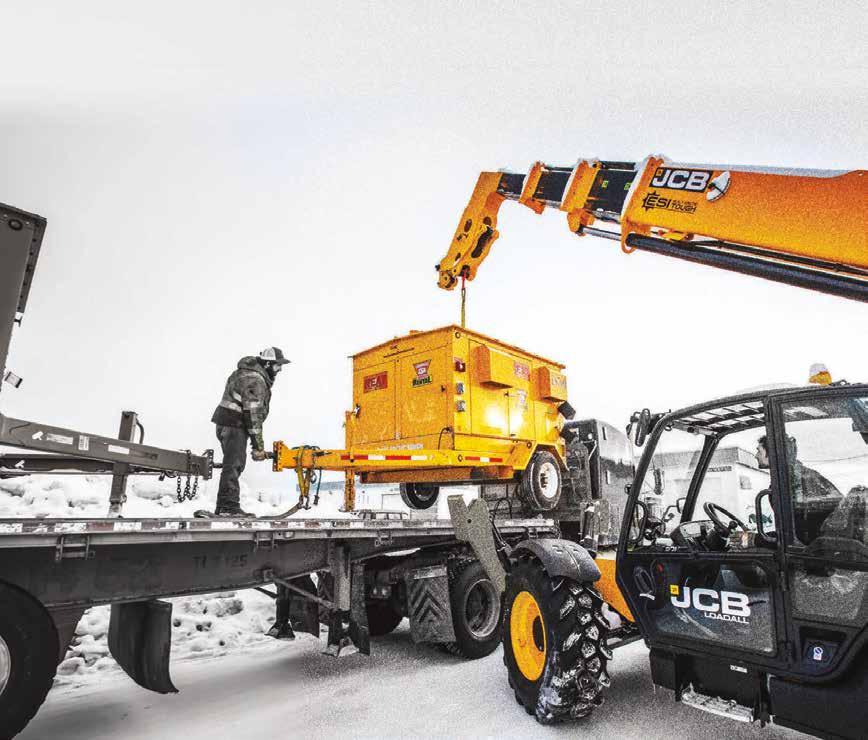

Equipment Source Inc. designs and builds equipment that stands up to Alaska’s harshest environments, because getting the job done doesn’t mean waiting for better conditions. From your backyard to the Arctic Slope, ESI has a solution for you. Shop or rent our wide range of heaters, generators, pumps, and more at esialaska.com. ANCHORAGE 907.341.2250 FAIRBANKS 907.458.9049 OIL & GAS · CONSTRUCTION · AVIATION TELECOMMUNICATIONS · MINING · LODGES EMERGENCY PREPAREDNESS · REMOTE LOGISTICS ALASKA
Merit Shops and Free Enterprise
A Q&A with ABC Alaska President and CEO Alicia Maltby
 By Tasha Anderson
By Tasha Anderson
Alicia Maltby took on the role of President and CEO of Associated Builders and Contractors (ABC) Alaska in November 2021. Before taking on the position, she had “zero construction experience.” But, as she told interviewers during her application process, “I don’t really need to know how to run a construction project. I need to know how to advocate for you, and I’m very good at that… I don’t like to lose.” In the following Q&A, Maltby provides her insights into advocating for Alaska’s contractors.

Tasha Anderson: What is some of your experience with advocacy?
Alicia Maltby: I started my career in hotels… and before I came here [to ABC Alaska] I worked for Alaska Hotel and Lodging Association… As far as associations [in general], I fell into it. I really like the advocacy component, and I think it's so important to fight for businesses to be able to run their business the way they want to, without having too
FatCamera| iStock
80 | March 2023 Alaska Business www.akbizmag.com
Alicia Maltby ABC Alaska
CONSTRUCTION
much government overreach. That is such a premise of ABC's mission and vision, that open merit shop philosophy and free enterprise.
Anderson: Who else works with you at the ABC Alaska office?
Maltby: We have a director of apprenticeship, and she has an apprenticeship coordinator. We had a part-time admin that went between the chapter and the training trust when I first started; we've now extended that to a full-time position. He does a lot of our event coordination, and then he assists with the Trust.
Anderson: I’m not familiar with ABC Alaska’s trust, can you tell me a little more about that?
Maltby: The chapter was established right around 1998/1999. Watterson Construction, Klebs Mechanical, Aurora Electric, and Wilson Financial were the four incorporators of the organization. We became a federally recognized program that same year and received our final 501(c)3 designation in 2012.


The [ABC Alaska] chapter is a 501(c)(6), because we do advocacy. The 501(c)(3) trust allows for the organization to focus its interests specifically on training, education, and workforce development.
Today we have about 300 apprentices that fall in our apprenticeship program that is run by the training trust. In the first years, the chapter had to fund some of that, but now it's standing on its own with its own budget and set of trustees, but it's all under the ABC umbrella.
We operate under Federal Department of Labor guidelines and standards, and we use NCCER [National Center for Construction Education and Research] curriculum for related instruction. Because NCCER is nationally recognized, it benefits workers who potentially move in or out of the state.
Anderson: That’s a great asset for workers who want the flexibility to work here or elsewhere, though obviously the preference is for them to stay here.
Maltby: We want them to stay here, absolutely. Alaska needs a workforce. Every industry needs a workforce.
PU W/O CHG MC 09/09/20 www.akbizmag.com Alaska Business March 2023 | 81 CONSTRUCTION
It doesn’t matter if you’re choosing our program or somebody else’s—as long as you choose a program.
Anderson: You’ve mentioned events that ABC Alaska puts on. What are some of the events that you do?

Maltby: Last year we only had our golf tournament and our annual dinner, and we did a small membership Christmas social. This year we’re hosting Beer and Bites, which is like a membership drive, where we let [current members] bring potential members for free. We'll do our clay shoot this year, and our golf tournament will be back. We’re hoping to throw in a few apprentice events this year… Apprentices are the future of this organization. We've seen a quite a few come back and start their own businesses. And they wanted to be a member so that they could hire apprentices and start training. We want to nurture that relationship with them and offer events that might just be apprentice specific, because it's not always comfortable to be in the room with your bosses.

Anderson: Other than advocacy, what are some of your goals and priorities on behalf of your members?
Maltby: This year we're really looking at workforce development. How can we continue to collaborate? It's not just about one program versus the other. We always like to say we're not anti-union, we just think everybody needs to have a choice on which direction they take their business or their apprenticeship program. There's
room for all of us in the market, because if the ultimate goal at the end of the day is workforce development, we should all work together to make that happen, right? Obviously, project labor agreements are huge, making sure that those are not government mandated. If somebody wants to put a project labor agreement on their project, they have the right and free will to do that. We just don't want the local, state, or federal government to be predicating who we choose to do business with and who our contractors or subcontractors choose to do business with. Alaska is so much about relationships and who you trust, and for the guys who've been in business for forty years, they don’t want anybody telling them who they can and can't work with. So those are our main goals: keeping that open merit shop, making sure those jobs are being awarded based on safety, cost and the quality of the work.
Anderson: Other than workforce issues, which you’ve mentioned, what are the biggest challenges you see facing the construction industry in Alaska?

Maltby: I think it's the same issues that everybody is seeing. Energy costs are still going up. Fuel costs are expensive. The cost of doing business has gone up, and supply chain issues haven’t been completely fixed yet—getting products here in a timely fashion because we're so backlogged from COVID. All of our
challenges are the same, it doesn't matter which industry you’re in.
Anderson: In theory, there’s a lot of potential projects in Alaska’s near future stemming from the Infrastructure Investment and Jobs Act. What’s your take on that?
Maltby: That's a tough question for us because we come from the open shop, free enterprise perspective. Yes, there's going to be a nice influx of federal money, but on the same token, you now have the administration that's putting federally mandated project labor agreements on federal projects. So if that goes through— and it will be the most strict policy, probably since Clinton—you’d see a lot of general contractors not bidding that work because they would have to be signatory to do the work. So as much as you want to see money come in, we also want all construction companies in the state to be able to bid. Yes, on the surface, it looks great. We're going to have this influx of projects. But the project labor agreement, the way it's written, would not allow for a lot of our contractors to bid. ABC national did surveys and 83 percent of private sector construction is now non-union in this country. Alaska sits right at 74.6 percent. So when you look at the big picture, some of these government mandates would take out 75 percent of the people who would be qualified or able to work on those jobs if they stay in their current position. This is a repetitive story for Alaska,
Greg Roads of Samson Electric (left) and Alicia Maltby as Roads receives a safety award at ABC Alaska’s Annual Dinner, October 2022.
ABC Alaska
ABC Alaska’s Annual Dinner, held in October 2022.
82 | March 2023 Alaska Business www.akbizmag.com CONSTRUCTION
ABC Alaska
because it's a look at how federal policy doesn't necessarily match what’s actually happening on the ground. It's a high view, when in reality that high view is just a little bit off base. The construction industry in Alaska is robust and it is highly skilled. So how do we approach making sure that [businesses] can do their jobs?

ABC members don't want a handout. They don't want a free pass; they just want a vertical playing field. If infrastructure projects are coming, and there's going to be an influx of money and work to be done, they just want a seat at the table to bid those projects directly and continue to build their business and contribute to infrastructure in Alaska. It's why they built their businesses to begin with.


Anderson: Is there any particular type of infrastructure or specific project that you think would benefit Alaska?


Maltby: I don't think there's any bad infrastructure if it's going to bring good jobs and health and safety to Alaskans. I don't care if it's through mining, oil and gas, or construction. Across the board, put Alaskans to work, give them steady, stable employment so that they're not looking for the next best thing and not wanting to leave. Alaskans want to continue to raise their families here, but with the assurance that there's enough work to make that happen for the future, right? You have to be able to raise a family here. It's not cheap to be in this state.
I'm a lifelong Alaskan. I grew up here. I went out of state to go to college. Coming back and raising my children here was a choice.
If more people could collaborate and come together and say, what's the best for Alaska, then we would all be in a much better place. That probably sounds a little like rainbows and lollipops. But when it comes to infrastructure, we need to look at what’s best for the people of the state, and not what’s best for padding the pockets of politicians or appeasing Outside interest groups.
We support anything that allows everybody to be at the same table fighting for the same work that is being given to people based on their experience, the quality of work, and the price.

WE ARE BUILDING AMERICA TOGETHER We represent the highest skilled craftspeople and are committed to excellence, safety, and productivity. Scan the QR code to learn more about partnering opportunities. nwCarpenters.org opeiu11aflcio ® Nenana Heating Services, Inc. PO Box 9 • Nenana, AK 99760 We are the exclusive distributor for Clean Burn waste oil heating equipment in Alaska. We carry a full range of Clean Burn Genuine OEM parts and o er sales, installation help, unit cleaning and return services. (907) 832-5445 or (800) 478-5447 E-mail: NHSI@alaska.net cleanburn.com/nenana-heating – Burns waste oil – Generates more heat – Long service life We ship anywhere in Alaska USE WASTE OIL TO HEAT YOUR FACILITY! ENERGY SYSTEMS The World Leader in Used-Oil Heating Systems www.akbizmag.com Alaska Business March 2023 | 83 CONSTRUCTION
Against the Darkness
Promoting mental health in Arctic workplaces
 By Alexandra Kay
By Alexandra Kay
“Although psychosocial risks can be found in all sectors, some workers are more likely to be exposed to them than others, because of what they do or where or how they work,” notes a World Health Organization (WHO) fact sheet titled “Risks to Mental Health at Work.”
If the “where” is north of the Arctic Circle, workplaces face unavoidable risks from geographic isolation, extreme weather, and dark winter days. “Physical and social isolation due to weather and socioeconomic burdens, as well as the lack of sunlight leading to a marked deficiency in Vitamin D, all contribute to mental/emotional health struggles,” says Joseph Delong, a physician assistant with Alaska Behavioral Health, which provides behavioral healthcare services around the state.
In Utqiaġvik, Alaska’s northernmost town, the sun is down for sixty-five days in a row in winter. “Towards around February, you start getting a little itchy,” says Jeff Seifert, general manager of radio station KBRW. “I've seen folks that just can't take it.”
To compensate, city streets are well lit, but little can be done about the town’s remoteness. Seifert says, “I don't know what we’d do if we didn't have air service. A couple of times this winter, we've gone several days without being able to get a plane in. When that happens, people get a little nervous.”
The landscape itself adds to the desolation. “It's just flatter than a fritter here,” says Seifert. “There's no mountains; there's barely hills. You can look out on the tundra and actually see
Explora_2005 iStock 84 | March 2023 Alaska Business www.akbizmag.com HEALTHCARE
the curvature of the earth. I mean, it just goes on forever.”
Fortunately, there are many things employers can do to help support employees’ mental health and well-being.
Offer Flex Work Schedules
“Think outside of the conventional 8 a.m. to 5 p.m., Monday through Friday work week,” says Sarah Koogle, clinic manager in Fairbanks for Alaska Behavioral Health.

According to WHO, risks to mental health at work can include “long, unsocial, or inflexible hours” and “conflicting home/work demands.” WHO recommends that employers prevent mental health conditions at work “by implementing organizational interventions that target working conditions and environments… [including,] for example, providing flexible working arrangements.”
Flexible work arrangements are schedules that differ from the traditional work week. These can include reduced hours; a compressed work week, where employees work longer days to have more days off; remote work; flex time; opportunities for job sharing; or leave time of various types. According to the Canadian Centre for Occupational Health and Safety, flexible work arrangements help employees manage responsibilities outside of work and lead to “increased job satisfaction, energy, creativity, and ability to handle stress.”
A 2011 study from researchers led by University of Minnesota sociology professor Phyllis Moen noted that employees at Best Buy who were allowed to change their schedules and whereabouts based on individual need experienced several positive benefits, which included reduced psychological stress, emotional exhaustion, and workfamily conflict, as well as increased self-reported health, sleep quality, and energy levels. The study concluded that giving workers more freedom with both location and time enabled them to care for themselves better. According to Moen, “Emphasizing actual results can create a work environment that fosters healthy behavior and well-being.” And both of these are essential for good employee mental health.

Scheduling flexibility can also provide employees with the time needed to
take part in traditional cultural activities, which is an important component of mental health. A 2006 study by Kevin Yoder of the University of North Texas found that “higher identification with the traditional culture (enculturation) was protective against suicidal ideation.” This finding was corroborated by a report from WHO and a Canadian Royal Commission on cultural change and identity among the indigenous people of the Canadian Arctic. Giving employees time to take part in cultural
activities of their choice can help them to feel a larger part of their community, thus improving mental health.
Those activities are mostly in summer. Seifert notes that longtime residents of Utqiaġvik tend to hole up in their homes and workplaces in winter. “You just stay inside in the light and stay busy and keep working. It's a good opportunity to get things done that you can't do in the summer because you want to be outside and active,” he says.
Voting Starts: March 1
Voting Ends: March 31
To Vote visit: AKBIZMAG.COM/BOAB or SCAN THE QR CODE SUPPORT YOUR FAVORITE BUSINESSES! WINNERS WILL BE REVEALED IN THE JULY ISSUE It’s
TO
Time
VOTE
2023
www.akbizmag.com Alaska Business March 2023 | 85
Encourage Social Interaction

According to an article in the Journal of Health and Social Behavior by Debra Umberson and Jennifer Karas Montez, “Social relationships—both quantity and quality—affect mental health….” The authors add that “social support may have indirect effects on health through enhanced mental health, by reducing the impact of stress, or by fostering a sense of meaning and purpose in life.”
Since employees spend much of their waking hours at work, it’s important for employers to nurture social interaction if they want employees to feel their best. The Reward & Employee Benefits Association—a network for human resources, risk management, and wellbeing professionals—suggests that employers allow time for socializing, such as time after a weekend to let employees catch up with each other, which lets them get to know one another better and allows them to build connections. For remote workers, this includes employers reaching out so that employees feel connected, such as inviting remote workers to social events and activities.
Employers can also utilize events like shared meals, wellness challenges, and team building activities to help employees build relationships with each other, as all three offer informal time at work for employees to chat and get to know others. Further, employers can take time to introduce employees to each other and provide an initial connection that can help employees feel more comfortable reaching out to one another.
Finally, offering a comfortable social space in the office—such as a break room or comfortable couch or chair groupings—can help employees gather informally when they are eating a meal or taking breaks.
Promote a Healthy Work Culture
The first day Seifert arrived in Utqiaġvik in 2013, it was May but still dark and cold. He had lived in Sitka, so he was used to inclement weather. Now he added more layers to his wardrobe.
As a manager, Seifert says he makes sure to take care of his team. Despite very high turnover in remote
The Alaska Heart Run & Walk is designed to help companies positively impact employee overall health and well-being. Get involved and inspire your team to be more engaged, reconnect with colleagues, reach their physical activity goals, support a great cause and have a lot of fun doing it. Company teams are forming now.
For more information contact Mike Lajoie at mike.lajoie@heart.org

“A very important thing in Barrow is to be able to get off the rock… get down to the bigger city. So folks try to get out of here at least a couple of times a year, just to preserve their sanity.”
& WALK SATURDAY, APRIL 15 5K RUN 5K WALK 3K WALK HEART RUN ALASKA AIRLINES CENTER PROCEEDS BENEFIT THE AMERICAN HEART ASSOCIATION AlaskaHeartRun.org USATF CERTIFIED COURSE Presented by:
Jeff Seifert, General Manager, KBRW
86 | March 2023 Alaska Business www.akbizmag.com
communities, his four-person staff has held together for the whole decade he’s been at KBRW. He checks in on their well-being, and the team shares responsibilities.


Koogle emphasizes the importance of a healthy work culture. According to Workplace Strategies for Mental Health, which provides resources for workplace mental health and psychological safety, “When an organization has a psychologically safe culture, employee well-being, job satisfaction, and organizational commitment are all improved. Conversely, if the culture is negative, it can undermine the effectiveness of great programs or policies intended to support the workforce. If an organization has a culture of fear and constant chaotic urgency, it can create an environment in which burnout and low morale are common.”
The Society for Human Resource Management says that organizations need to move beyond the “just get work done” idea and think long term with employees’ concerns at the top of their mind. Ninety-four percent of managers
Jeff Seifert
agree that a positive workplace culture creates a resilient team of employees, and since resilience can directly correlate to better mental and physical health, it’s important for employers to take steps to ensure their employees feel positive about the culture of an organization. And according to Business Review at work ultimately serves employees
Breakup of sea ice on the coast of Utqiaġvik opens a slim maritime connection for a town otherwise accessible only by air travel.
www.akbizmag.com Alaska Business March 2023 | 87
workforce managers should encourage clear and open communication among all employees as well as transparency between managers and workers. Workers should be given clear guidelines and expectations for work.
According to WISQ—a platform that helps improve social well-being by enabling employees to connect, share, and build relationships at work—improving workplace climate can be done by forming an inclusion council made up of workers across departments and levels of seniority, investing in recruitment tactics that foster diversity and inclusion, and encouraging employees to find community and support within the company through employee resource groups. WISQ also notes that empowering managers to share real-time feedback and recognition with employees and finding a balance between focusing on results and the experiences people have in achieving those results are also beneficial to culture. And finally, employers can hire people whose values align with those of the organization, and they can actively recognize behavior that supports that culture.
Help Employees with Self-Care
Each year, 18.8 million American adults (9.5 percent of the adult population) suffer from a depressive illness, says the US Centers for Disease Control and Prevention (CDC). Further,
depression is responsible for an estimated 200 million lost work days each year, at a cost of $17 billion to $44 billion to employers.
“GoodRx Research has found that many Arctic communities live in a mental health desert, meaning they live in an area with no mental health providers,” says Tori Marsh, director of research at GoodRX, an online prescription drug clearinghouse. “For instance, the Kusilvak Census Area [in the Lower Yukon region] has a 96 percent American Indian/Alaska Native
not feel culturally competent for Arctic communities.”
Marsh recommends that employers bridge the gap in the lack of mental health providers by offering employees options for teletherapy. “Increasing access to telehealth is just one of many public health strategies that could help address mental health disparities the AI/AN community faces and provide timely care in rural areas,” says Marsh. “Our research also found that many Arctic communities had a lower than average percentage of households with any form of broadband. Broadband internet is typically necessary for video or online telehealth calls, and broadband internet is not always accessible to those living in rural areas.”
Employers can also offer benefits that support mental health, such as paid time off and subsidized therapy. Among states, Alaska had the fourth highest proportion of uninsured population in 2020 (behind Texas, Oklahoma, and Georgia), according to Alaska Scorecard 2021.
population with more than ten tribes... yet no mental health providers.”
As if living in a mental health service desert weren’t enough, Marsh adds that Arctic communities also face greater need for services due to “isolation, colder climates, or less daylight leading to Seasonal Affective Disorder. Additionally, currently available mental health options may


Additionally, employers can offer mental health training that includes ideas for mindfulness and stress reduction techniques, and they can work to promote open conversations about mental health to reduce any perceived stigma employees might feel over admitting any struggles.
The CDC suggests other strategies, “such as holding depression recognition
Preparing a
in
the 65-day night.
grave
Utqiaġvik during
Jeff Seifert
88 | March 2023 Alaska Business www.akbizmag.com
Jeff Seifert
screenings; placing confidential selfrating sheets in cafeterias, break rooms, or bulletin boards; promoting greater awareness through employee assistance programs (EAP); training supervisors in depression recognition; and ensuring workers’ access to needed psychiatric services through health insurance benefits and benefit structures.”


To that list, Koogle adds that employers can help employees to partake in self-care, such as offering discounts at local gyms.
On the North Slope, self-care often involves venturing south of the Arctic Circle. “A very important thing in Barrow is to be able to get off the rock,” says Seifert. “Every once in a while, get down to the bigger city. So folks try to get out of here at least a couple of times a year, just to preserve their sanity.”
Provide Support
Employers can also support people with mental health conditions to participate in and thrive at work by providing three interventions, says WHO:
x Provide reasonable accommodations at work to adapt working environments to the capacities, needs, and preferences of a worker with a mental health condition.
x Offer return-to-work programs with ongoing clinical care to support workers in meaningfully returning to work after an absence associated with mental health conditions.
x Support employment initiatives to help people with severe mental health conditions to get into paid work and maintain their time on work through continuing to provide mental health and vocational support.
Those who live and work in the Far North have good reasons to be there. Seifert calls Utqiaġvik a “hard working community” and says his neighbors are “the toughest people I’ve ever met in my life.”
To stay put, they must figure out how to stay healthy. “That's just something you get used to doing,” Seifert says. “We just suffer through the darkness and look forward to when the sun starts peeking up.”
www.akbizmag.com Alaska Business March 2023 | 89
Countdown to Graphite One

Restoring the US supply of a critical mineral
By Amy Newman
The Kigluaik Mountains stretch 42 miles east to west along the Seward Peninsula just north of Nome. Grizzly bears and moose roam the area, its lakes are home to a unique subspecies of Arctic char, and it’s the site of the Grand Union Glacier, the only active glacier in Western Alaska.
The mountains are also home to Graphite Creek, site of the largest known flake graphite deposit in the United States. Located 37 miles outside of Nome and 3 miles inland from Windy Cove, the deposit contains more than 8 million tonnes of graphite, according to the United States Geological Survey (USGS) US Mineral Deposit Database.
Vancouver, Canada-based tech company Graphite One hopes to make that deposit the linchpin of a threepronged project that will increase the North American supply of graphite and reduce US dependence on foreign sources of the mineral.
“Our goal is to create the first dominant [graphite] supply chain in the history of the United States,” Graphite One founder and CEO Anthony Huston said of the company’s plans in 2020.
Graphite One isn’t the first company to extract graphite from the hills of Nome, though it is the most ambitious.
At the start of the 20th century, Minnesota couple Nicholas and Evinda Tweet came to Nome in search of gold, Huston says. They formed N.B. Tweet & Sons and acquired 176 mining
claims spread across 23,680 acres. During the first and second World Wars, the company turned its attention to extracting graphite, which it sold to steel manufacturers in Seattle and San Francisco to aid the war effort.
Huston learned of the graphite deposit in 2012 and obtained permission from the Tweets’ descendants to extract and test graphite from their claims to determine whether it could be used to produce lithium-ion batteries. After tests confirmed it could, Graphite One purchased 163 of the Tweets’ original claims and leased the remaining 13.
Since then, the company has worked steadily to get the Graphite Creek project online and, despite some COVID-19 related setbacks, is on track for first production to begin in 2028.
Domestic Supply of a Critical Mineral
A naturally occurring form of crystalline carbon, graphite is soft and easily split, yet extremely heat resistant and nearly chemically inert. These properties suit a variety of practical, everyday uses. Graphite is a vital component in batteries that power laptop computers, LEDs, smartphones, and electric vehicles, as well as being used to make solar cells and nuclear reactors. Because of its versatility, it is consistently included on the USGS’ annual list of minerals critical to the US economy and national security.
envato 90 | March 2023 Alaska Business www.akbizmag.com MINING
Despite its critical status, graphite has not been produced in the United States since the ‘50s, according to the USGS, and the country’s last known graphite mine, located in Montana and operated by United Minerals, closed in 1990. This makes the United States 100 percent dependent on foreign sources to meet its graphite needs. In 2021, the USGS reports that the United States imported 53 tonnes of graphite, primarily from Canada, Mexico, and China.
Graphite One plans to reduce that foreign dependence with a vertically integrated operation that will mine, refine, and recycle high-grade anode materials and provide the United States a domestic source of this critical mineral.




“Graphite One is anchored by our Graphite Creek project, but we are more than just a mine,” Huston says. “We know we have to build out a full domestic advanced graphite supply chain. It’s a full circular economy approach. Nothing less than that will get the United States back in the graphite game, at a time that graphite is key to so many high-tech transitions.”
The approach begins with the Graphite Creek mine, planned as a one-mile long, half-mile wide open pit up to 1,000 feet deep. The yearround truck and shovel operation is expected to mine four million tonnes of graphite annually, with one million tonnes delivered to the adjacent processing plant. From there, graphite mineralization will yield 60 thousand tonnes of graphite concentrate, which will be shipped from Nome to Graphite One’s manufacturing plant in Washington.
The Washington plant will pelletize and thermally purify the graphite to a minimum concentration of 99.9 percent. It will then be air-milled, turned into spheroid particles, and coated and graphitized. The process is expected to yield 41,850 tonnes of battery-grade coated spherical graphite, which can be used in electric vehicles and lithium-ion batteries, and 13,500 tonnes of advanced graphite materials, which can be used in energy storage systems and a range of manufacturing supply chains.
“Graphite One anticipates that the electric vehicle and energy storage















STEW ARD SHIP

“Amazingly, and all credit to our Graphite One team, we managed to keep development going as much as possible, so we are looking at mine construction commencing in 2026, with first production in 2028.”
Anthony Huston, Founder and CEO, Graphite One
heclagreenscreek.com www.akbizmag.com Alaska Business March 2023 | 91
As the only mine within a protected national monument, we hold ourselves to a higher standard. Every day we work hard to keep our footprint small by recycling our waste, conserving water and utilizing a dry stack tailings system. We also use hydropower whenever it’s available. It’s all part of our commitment to go beyond what’s required. That’s the Greens Creek Difference.
SETTING THE HIGHEST STANDARDS
sectors will soak up around 70 percent of our production, with the remainder going to established industrial applications and new technology uses,” Huston says.
Growing Global Demand
In 2020 Huston said the worldwide demand for graphite was driven by the push toward green technology, specifically electric vehicles. At the time, the World Bank projected that worldwide demand for graphite would increase by 383 percent by 2050. It has since revised its projections and anticipates that demand will increase by 494 percent.
“The primary demand driver comes from the tightening timelines to transition to electric vehicles, added on top of the existing industrial demand for graphite,” Huston says.
The tightened timelines are coming on both the domestic and global fronts. As part of his Build Back Better agenda, President Joe Biden signed an executive order that requires at least 50 percent of all new vehicle sales be zero-emission by 2030. Globally, China has pledged that 40 percent of all new vehicles will be zero-emission by the end of the decade, and the European Union has committed to having at least 30 million electric vehicles on the roads by 2030.
Though graphite’s role in the creation of lithium-ion batteries usually takes
center stage in conversations about the mineral, Huston says there is an increased demand for graphite in other applications as well.
“While battery applications get most of the media attention, graphite demand for other technology applications continues to evolve, which is where graphene comes into play,” he says.
Graphene—sheets of carbon atoms that, stacked together, make graphite crystals—can boost the capacity, longevity, and charge rate of lithiumion batteries. Researchers are also examining its ability to improve energy generation and potential uses in the biomedical field, including targeted drug delivery, improved brain penetration, and as “smart” implants.
“The world is in the midst of a materials science revolution, and graphite is a big part of that revolution,” Huston says.
Revising Expectations
Graphite One released its prefeasibility study (PFS) in October 2022, a year later than initially anticipated due to COVID-19 setbacks. The study, conducted on an approximately one-square-kilometer assessment representing 7 percent of the formation, found that the mine had an annual production potential of 75,000 tonnes, an increase from the 50,000 tonnes Graphite One predicted ahead of the study. Based
on those results, combined with a continued increase in demand for graphite anodes, Graphite One revised its initial estimates as it heads the feasibility stage.
“As we completed the preliminary feasibility study, we knew from enduser discussions with major electric vehicle manufacturers that graphite anode demand would be much higher than the assumptions we made several years back when beginning our PFS,” Huston explains. “As a result, in our feasibility study, Graphite One is looking at several multiples of that 50,000 metric ton figure, likely between 100,000 and 150,000 metric tons of annual production. Market demand will support it, and we believe our project will be that much more economically robust.”
During its 2022 field program, Graphite One drilled 2,090 meters at the mine site. Additional core and sonic drilling provided geotechnical data for building the proposed mill, dry tailings/waste rock storage areas, and the mine’s access route. Graphite One also conducted ongoing baseline environmental surveys, installed weather stations, and increased its camp capacity from twenty-four to sixty persons.
Graphite One’s pre-COVID-19 timeline had construction at the mine slated to begin in 2025. Though the pandemic caused some delays, Huston
 Capacity at the Graphite Creek camp expanded in 2022 from 24 to 60 workers. Once production begins, the mine is expected to employ up to 200 workers year round.
Capacity at the Graphite Creek camp expanded in 2022 from 24 to 60 workers. Once production begins, the mine is expected to employ up to 200 workers year round.
92 | March 2023 Alaska Business www.akbizmag.com
Graphite One
says they were minimal and that the project remains relatively on track.








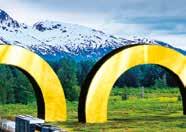
“Amazingly, and all credit to our Graphite One team, we managed to keep development going as much as possible, so we are looking at mine construction commencing in 2026, with first production in 2028,” he says.
There are also plans to have the Washington manufacturing facility operational before construction begins at Graphite Creek. Huston says Graphite One plans to buy graphite concentrate on the open market and run it through its Washington manufacturing plant, and then flow material from Graphite Creek in when the mine comes online.

“We’re looking at ways to flip the script on the linear ‘mine first, refine second’ approach to project development, to get our advance materials facility up and running sooner,” Huston explains. “Demand [for graphite products] is huge, so we really see value in innovating to begin production sooner.”
Economic Impact on Nome

The Graphite Creek mine’s success hinges in part on the Port of Nome’s ability to handle the increased traffic.

“The Port [of Nome] is a key infrastructure element for our project,” Huston says.
Nome exports rock and gravel using the WestGold Dock, part of a causeway that stretches more than half a mile to deeper waters of Norton Sound. Those current operations must seamlessly integrate with Graphite One’s new demands, Port Director Joy Baker explains.
“Additional vessel traffic to move cargo, fuel, natural resources, and construction materials always impacts the operations, as vessels compete not only for berthing space but dock staging areas for working cargo, staging equipment, gravel/rock materials, and for handling passengers and crew that disembark and embark on cruise ships, scientific vessels, NOAA ships, and USCG vessels,” she says.
The US Army Corps of Engineers added a breakwater in 2006 to partially enclose the causeway docks, yet Baker anticipates that the port will require additional improvements to prepare for Graphite One.
FOR
SEAMLESS LOGISTICS Full-service logistics. Get a free quote: 800.321.6518 AlaskaRailroad.com/freight Join the sponsor list at alaskaminers.org The Alaska Miners Association has been hard at work for Alaska’s mining industry. All of AMA’s efforts are made possible through the support of our members and Durability Project sponsors. www.akbizmag.com Alaska Business March 2023 | 93
The Alaska Railroad has been keeping vital industries on track for 100 years. Freight moving by rail isn’t subject to seasonal weight restrictions like those on the road system, and that is just another reason to choose Alaska Railroad. Less hassle getting materials to the job site means you can focus on the project.
A CENTURY
“At this point, the port has made improvements in uplands laydown space, which is intended to serve not only the staging of graphite, but heavy equipment, armor stone, and gravel and sand materials, as well as project materials,” Baker says. “This area will also include set-aside working areas for users and tenants to rehandle equipment and materials that could be an export or an import for transshipment throughout the region.”
Though Baker currently doesn’t anticipate any operational changes at the port, she says that could change as the mine’s extraction volumes grow.

Huston views the Graphite Creek mine as part of an economic development system that will confer benefits not just on Graphite One but the community of Nome as well.
“[The Port of Nome] is a great example of how Graphite One is part of a large ecosystem of economic development,” he says. “We need a vibrant port, the port needs a large, anchor tenant like Graphite One, and… Alaska needs strong economic drivers to support ports of refuge and an Arctic strategy, given the importance of the region. Graphite One sees itself as a partner in these long-term developments, which
confer benefits far beyond our business case.”

Huston says the Graphite Creek mine will also serve as a source of good, long-term, well-paying jobs for locals. He estimates that the project will employ up to 200 workers, and he says the company is committed to implementing a local hire preference and to training its employees.
“Our people can build their skill sets and move up to new opportunities as we operate,” he says. “Our 26-year project life is based on exploration of just 7 percent of our total deposit, [so] Graphite One is going to be around for a long time.”

“We need a vibrant port, the port needs a large, anchor tenant like Graphite One, and… Alaska needs strong economic drivers to support ports of refuge and an Arctic strategy, given the importance of the region. Graphite One sees itself as a partner in these long-term developments.”
Anthony Huston, Founder and CEO, Graphite One
94 | March 2023 Alaska Business www.akbizmag.com
A boat leaves the Port of Nome to dredge for gold offshore. andykazie| iStock








GOLD & SILVER BULLION IS A GREAT INVESTMENT. Buy from an Experienced and Trusted Local Dealer. Protect Yourself from In ation and an Unstable Global Economy. ■ ANCHORAGE ■ FAIRBANKS BUY : SELL : TRADE www.oxfordmetals.com 1.907.561.5237
Snagged by Accident
Escaping the bycatch blame game to seek balanced solutions
By Vanessa Orr
Anglers talk about “the one that got away,” but just as much of a headache for commercial fishers is the one caught accidentally. Bycatch occurs when fishermen unintentionally catch fish or other marine species that they do not want, cannot sell, or are not allowed to keep. What ends up in someone’s trap, net, or longline might be someone else’s harvest, gone to waste.
The issue of bycatch has grown more important as some fisheries get smaller and those who depend on the fish for their livelihood or survival find that there are not enough fish to go around. This raises the question of whether bycatch is at the root of the problem or if other issues facing fisheries must be addressed.
How Big a Problem Is Bycatch?
According to Karla Bush, extended jurisdiction program manager with the Alaska Department of Fish and Game, bycatch occurs in all fisheries, so how “big” the issue is depends

96 | March 2023 Alaska Business www.akbizmag.com FISHERIES
on a number of factors, including what species are taken as bycatch, the economic or cultural value of that species, current abundance levels, and what proportion of all removals of that species is taken as bycatch.














“For species such as halibut, the proportion taken as bycatch in recent years is at historically low levels. For other species, like sablefish, bycatch in some fisheries has increased because the sablefish population has increased,” she explains. “For snow crab and many of the salmon species (such as Chinook [king salmon] and chum salmon) that have been negatively impacted by recent marine heatwaves in the Gulf of Alaska and the Bering www.akbizmag.com
 Alaska Department of Fish & Game
Alaska Department of Fish & Game
Alaska Business March 2023 | 97
Sea, all removals—including bycatch— becomes a greater concern because there are fewer of them.”
Bycatch is monitored in a combination of ways, through atsea observers, electronic monitoring, seafood processing plant observers, logbooks, and fish tickets.
“In the Bering Sea, approximately 94 percent of all catch is observed, including 99 percent of all trawl catch,” Bush explains. “In the Gulf of Alaska, 40

to 50 percent of all catch is observed across all gear types.”
She adds that most of the groundfish harvest (cod, halibut, or sole) occurs under the full coverage monitoring program with either a human aboard or a camera turned on at all times. In the Alaska pollock fishery, cameras are used to make sure that nothing is discarded, and all of the catch is sampled when it is delivered.
“Most fixed-gear fisheries statewide and trawl fisheries in the Gulf of Alaska are monitored under the partial coverage observer program and have either a human observer or camera on for a portion of their trips. This information is used to extrapolate the bycatch on unobserved trips,” says Bush, “and because these observed trips are assigned randomly throughout the season and similar types of fishing efforts are grouped together, we have
“We’re not trying to shut down a fishery, we’re trying to get everyone to help conserve… If our people catch one chum on the Yukon or Kuskokwim, we are criminals, but the commercial fleet can catch hundreds of thousands out there, and it’s just an accident.”
Brian Ridley, Chief/Chairman, Tanana Chiefs Conference
Commercial gillnetters fishing for sockeye salmon at the mouth of the Naknek River.
98 | March 2023 Alaska Business www.akbizmag.com
Alaska Department of Fish & Game
pretty good precision in the estimates of what is being caught.”

According to these measures, Bering Sea trawl fisheries retain approximately 96 to 98 percent of their catch, with bycatch accounting for about 2 to 3.5 percent. Bering Sea fixed-gear fisheries using pot and longline gear keep about 85 to 90 percent of their catch and discard 10 to 15 percent.



“However, the total pounds of catch in the trawl fisheries is several times greater than the fixed-gear fisheries, so overall bycatch amounts are larger for trawl than the fixed-gear fisheries, which have higher discard rates,” says Bush.
In the Gulf of Alaska, trawl fisheries discard anywhere from 5 to 13 percent of their catch, and fixed-gear fisheries dispose of 20 to 33 percent of the catch.

“The amount of bycatch depends on how much of the target species is being caught, what the bycatch rates are, and how discriminate the gear is,” says Bush. “Pot gear is good at catching the target groundfish species but can catch more crab than other gear types. Longline gear has low bycatch rates for crab but can have higher rates for nontarget groundfish species. With trawl gear, the amount of bycatch depends on where they’re fishing, what the target fishery is, and the type of trawl gear that’s used.”
Some fisheries do have strict bycatch limits. “For trawlers, there’s a hard cap on king salmon, for example, and the fleet is very cognizant of that fact,” says John Jensen, a halibut and crab fisherman from Petersburg who chairs the Alaska Bycatch Review Taskforce (ABRT). “They pay close attention to what is going on as far as catches go.”
Jensen adds that the whole fleet is interconnected by data collection agency records that note the amount of fish kept and the amount returned to the sea. This information can also be used to avoid "rolling hot spots,” where boats may be catching a higher percentage of a species, such as king salmon, and will need to move from there to a different area to avoid increased bycatch.

“Unfortunately, sometimes that means that they’re intercepting another

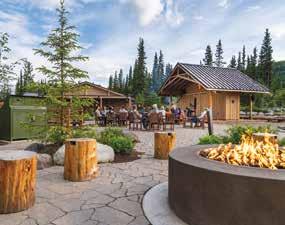

We are Alaska’s Tug and Barge Company. Cook Inlet Tug & Barge has been dedicated to providing quality marine services since 1924. Find out more at www.cookinlettug.com. www.akbizmag.com Alaska Business March 2023 | 99
kind of prohibited species when they do that,” says Jensen.
The Issue in Western Alaska
One of the areas most affected by decreased salmon returns is Western Alaska, where smaller runs are having devastating impacts on the residents of the Kuskokwim River and Yukon River basins. According to Brian Ridley, chief and chairman of the Tanana Chiefs Conference, finding out what is affecting the fish runs is vital, and this includes a focus on bycatch.
“We’ve not been able to fish on the Yukon and Kuskokwim rivers for three years, and runs have been really bad for the better part of eight years,” Ridley explains. “We use fish escapement into Canada as our gauge, and this year 22,000 chum and 12,000 king made it into Canada; that’s only 34,000 total fish. Since we began tracking it in 1982, it is the lowest it’s ever been. Even when we went through a low period in 2012/2013, there were still twice as many fish making it across the border.”
According Tanana Chiefs Conference Executive Director of Tribal Government and Client Services Amber Vaska, bycatch is just one of the many factors affecting fish returns. “Part of it is climate change, which includes long, hot summers that are warming up the water, which affects

fish migration up the rivers,” she explains. “There are also the issues of ichthyophonus illness and predation.”
The main factor under human control is the size of the harvest. Vaska says, “Our tribe has been trying to conserve Yukon River salmon for the past three years—in fact, even longer— but none of this is affecting the big commercial fisheries.”
To this end, Ridley recently introduced two resolutions at the Alaska Federation of Natives (AFN) convention that requested that the Alaska Department of Fish and Game support measures to decrease the intercept of Chinook and chum salmon at sea in Area M along the Alaska Peninsula, which Native communities use for commercial and subsistence fishing, and that the North Pacific Fishery Management Council address salmon bycatch and mortality issues in the Bering Sea/Aleutian Islands that affect coastal western and interior Alaska salmon stocks. Both resolutions passed.
“If we can get help in those two areas, we can hopefully get more fish back to the river,” says Ridley. “I worry that for too long, everyone has been pointing at everything else, and nothing has changed. That’s what has gotten us to where we are today.”
At the AFN convention, Ridley acknowledged that just having
“While there is a perception that bycatch is taking chum and king salmon away from the people of the Yukon River and other Western Alaska systems, the task force proved that there are other issues—outside of bycatch or incidental catch—that are taking those fish away.”
John Jensen Chairman
Alaska Bycatch Review Taskforce
Snow crab harvested in the Bering Sea being sorted for processing.
100 | March 2023 Alaska Business www.akbizmag.com
Alaska Department of Fish & Game
the discussion was controversial, seemingly setting regions and user groups against each other.



“We’re not trying to shut down a fishery, we’re trying to get everyone to help conserve,” he says. “If our people catch one chum on the Yukon or Kuskokwim, we are criminals, but the commercial fleet can catch hundreds of thousands out there, and it’s just an accident. And something has to change if we want our fish to come back.”
In the Bering Sea’s monitoring program, genetic samples from one of every ten Chinook salmon caught as bycatch indicate where the fish came from. “About half of the Chinook salmon taken as bycatch come from Western Alaska river systems, and the rest come from the other areas in Alaska, Canada, Washington, and Oregon,” says Bush. “Knowing the origin of the bycatch can help us estimate the impact that it may be having on the number of fish returning to those systems.
“The Chinook salmon caught as bycatch in 2020 is estimated to be about 3 percent of the total Chinook salmon returning to Western Alaska and the Yukon River,” she adds. “While that’s not a lot of salmon—and 10,000 or so salmon would not have changed management decisions in the area— without that bycatch, there would have been more salmon returning for future runs. It’s not an insignificant number when stocks are at critically low levels.”
While not everyone agrees how much bycatch is to blame, those in the fishing industry are also concerned about these issues that affect their livelihood.
“Many of Alaska’s salmon, halibut, and crab stocks are at historically low abundance levels, severely impacting Alaska’s coastal communities, subsistence users, fishing vessel owners and their crews, seafood processors and their employees, and other cultural and economic stakeholders. Understandably, this has led to recent conflicts between fisheries, gear-types, and regions,” said Jon Hickman, vice president, in a statement provided by Peter Pan Seafood Company.

“Although it is easy to blame bycatch in one fishery for low abundance in another, recent science suggests that


Shop local for superior service today! TV the way it should be with DISH Requires credit qualification and 2-year commitment. Other restrictions apply. PREM_766085 BEST VALUE FREE LOCALS ON DEMAND Satellite Alaska 844-244-3675 2208 Cleveland Ave., Anchorage, AK 99517 Alaska Owned & Operated Since 1979 We work as hard as you do to provide great service and insurance protection to our clients. Let us show you how to control your Insurance costs. ph: 907.276.7667 www.chialaska.com info@chialaska.com www.akbizmag.com Alaska Business March 2023 | 101
Jon
there are more and larger problems: the retreat of seasonal sea ice coverage, warming waters, low food abundance, and increased predation are just a few,” Hickman added. “We need to better understand the causes of large mortality events like the recent opilio (snow) crab collapse as well as the more drawnout decline in Arctic Yukon Kuskokwim salmon returns and statewide declines in chum and Chinook salmon.”
The Peter Pan Seafood statement goes on to say that fisheries management must evolve in response to a changing environment. “The current challenge to maintain sustainable fisheries, communities, and cultures is growing, and we support the state, federal, and industry-funded initiatives to adapt and increase our understanding of the ocean and how we can continue to manage these important marine resources,” said Hickman.
The Alaska Bycatch Review Taskforce
issue and provide recommendations to policy makers. What the task force found, according to Jensen, is that bycatch is only part of the equation.
President
In November 2021, Governor Mike Dunleavy established the Alaska Bycatch Review Taskforce to explore the

“We need to make it clear to the public that it’s more than just bycatch,” he says. "There are many factors facing Alaska’s fisheries, including climate change, ocean conditions, and marine mammal predation. For example, water temperature plays a big factor; while the Bering Sea is cooling down now, it was abnormally warm there for a few years.”
Jensen adds, “While there is a perception that bycatch is taking chum

“Although it is easy to blame bycatch in one fishery for low abundance in another, recent science suggests that there are more and larger problems: the retreat of seasonal sea ice coverage, warming waters, low food abundance, and increased predation are just a few.”
Hickman Vice
Peter Pan Seafood Company
A sockeye salmon caught in a set gillnet.
Alaskans Demand the Best. Span Alaska has been perfecting transportation to the Last Frontier for almost 50 years. Our customers know they can depend on our experienced teams to deliver the reliable solutions they need to keep business running smoothly. To schedule a pickup or find the terminal nearest you, call 1-800-257-7726 or visit spanalaska.com. Serving Alaska since 1978 102 | March 2023 Alaska Business www.akbizmag.com
Alaska Department of Fish & Game
and king salmon away from the people of the Yukon River and other western Alaska systems, the task force proved that there are other issues—outside of bycatch or incidental catch—that are taking those fish away.”



After spending a year witnessing more than forty presentations from agencies, research organizations, and industry groups, the ABRT came up with recommendations for more research, both generally and related to salmon, crab, and halibut specifically.

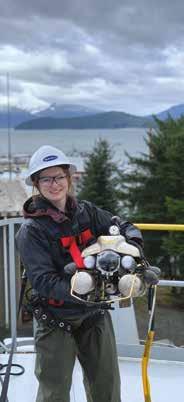
“While there is quite a bit of research going on all of the time, more research—
as well as the funding to support it—is still needed,” says Jensen. “We need to figure out strategies on how to fish where other fish are not present as well as research gear modifications, like excluders, that can let salmon out when trawling for pollock.”
The taskforce also proposed more rules, including a rationalization program for the Gulf of Alaska, fractioning the fishery into shares or quotas. “It would be different than the one in the Bering Sea because different communities would be affected,” says Jensen, adding that Alaska could


see such a rationalization program taking place in the next four years. “Rationalization is a heavy lift, but folks want it now, so I think we’ll probably be looking at it early on.”



One thing that is certain is that no one group of people—whether state and federal officials, commercial fishermen and processors, or Native organizations and tribes—can fix this problem on their own. It will take everyone working together to try to ensure that in the future, Alaska’s seafood industry will be healthy enough to support all its users.


The
Alaska
of
&
FAIRBANKS 907-452-5688 ANCHORAGE 907-222-2445 JUNEAU 907-586-6813 Tank Inspections Engineering Design Phase I & II ESA Industrial Hygiene / CIH Environmental Remediation Hazardous Materials Management Regulatory Compliance Support Certi ed Inspection Services HSE Program Development Contingency Planning Energy Ef ciency Sanitary Surveys Learn more at www.nortechengr.com ENGINEERING RESULTS TO MEET ALASKAN CHALLENGES SINCE 1979 www.akbizmag.com Alaska Business March 2023 | 103
Alaska Bycatch Review Taskforce proposes rationalization in the Gulf of Alaska, similar to Bering Sea fisheries divided into quotas or shares.
Department
Fish
Game
Sharing Value
The rich past and uncertain future of 7(i) and 7(j) revenue
By Elwood Brehmer
Abrief but powerful provision of the Alaska Native Claims Settlement Act (ANCSA) has led to the dispersal of billions of dollars across the state for the betterment of Alaska Native communities, but uncertainty regarding future revenue has led some to question the long-term viability of the program.
It starts at the fundamental level of the land and what it provides.
ANCSA, the landmark legislation passed by Congress in 1971 that called for the establishment of the 12 operating Alaska Native regional corporations and more than 200 village corporations, also mandated that Alaska Native corporations (ANCs) could collectively select roughly 44 million acres of land. Those lands have been selected and mostly conveyed over decades to serve as an economic engine for the ANCs and their shareholders. Revenue generated from the use and careful development of ANC lands across Alaska—whether for tourism, mining, oil and gas, or timber operations—not only improves a corporation’s bottom line but
supports an array of shareholder benefits rarely found anywhere else in the business world.
shareholders. That’s where the deeply rooted Alaska Native cultural value of sharing the harvest comes in, according to ANCSA Regional Association President Kim Reitmeier.
Section 7(i) of ANCSA directs the regional corporations to share most of the income they receive from resource projects on their lands with all the other regional corporations. It simply stated that “70 percent of all revenues received by each Regional Corporation from the timber resources and subsurface estate patented to it pursuant to this Act shall be divided annually among all twelve Regional Corporations” when it was passed in 1971.
“It is more than the money you see; it’s the cultural aspect of making sure that we are taking care of one another,” Reitmeier says.
ANC leaders say the situation speaks to the unique bond the corporations have with their shareholders. ANC shares cannot be bought or sold, and everything the corporations do is intended to be for the social, cultural, and economic benefit of their
More recent amendments have clarified the legislation, such as specifying that it is net income that is shared, notes Nathan McCowan, who is president and CEO of St. George Tanaq Corporation and chair of the Alaska Native Village Corporation Association.
 Carter Damaska Alaska Business
Carter Damaska Alaska Business
FINANCE
“It is more than the money you see; it’s the cultural aspect of making sure that we are taking care of one another.”
104 | March 2023 Alaska Business www.akbizmag.com
Kim Reitmeier, President ANCSA Regional Association
“Congress wanted to ensure that all Alaska Natives had something approaching a fair and equitable distribution of benefits coming from our natural resources,” McCowan says. “Congress recognized that there were going to be regions rich in resources and there were going to be other regions that were not.”
Section 7(j) of ANCSA further assures that the resource wealth helps with local needs by instructing the regional corporations to share 50 percent of their annual 7(i) distribution with the village corporations in their regions.
Other ANC leaders have described it as similar to how subsistence harvests are shared within Alaska Native communities.
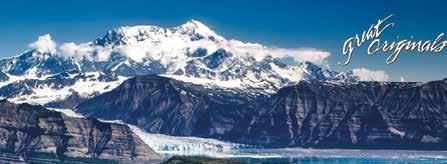
Hyper-Local Needs


Since the first ANC resource income was shared decades ago, more than $2.5 billion has been distributed through the closely tied 7(i) and 7(j) programs, according to an economic analysis by McKinley Research Group.
Reitmeier notes that annual 7(i) distribution totals have varied widely year to year, given they are subject to sometimes volatile commodity markets, whether for timber from Southeast, oil off the North Slope, or minerals across the state. According to the economic analysis, 7(i) revenues have exceeded $230 million in some recent years, but often the annual pool has been $50 million or less over the life of the program.
At the regional level, ANCs put shared funds toward a wide range of causes; ANCSA does not limit how it is invested or spent. Some ANCs opt to fund shareholder distributions, but there are numerous other ways it is utilized, Reitmeier emphasizes.
“It goes beyond the dividends; it goes to the culture camps, to scholarships, to language revitalization, and contributions to nonprofits. All twelve regional corporations provide elder dividends, potlatch and burial assistance, along with other services,” she says. “And 7(j) is an integral part of the ability for village corporations to provide greater services to their shareholders and communities.”

Most village corporations are small entities, which McCowan



907-561-8922 www.greatoriginals.com 360 E. International Airport Road Anchorage, Alaska Customer Service Hours: 9am - 5pm, Monday - Friday Produ ction Ho urs: Till the work is done, as we promised! If it requires printing of any type, quick & reliable local production, email us for an quick Estimate at greatos@alaskan.com. www.akbizmag.com Alaska Business March 2023 | 105
describes as “fractions of the regional corporations” that employ thousands of people nationwide through their subsidiaries. While 7(i) funds are a bonus for regional corporations, most village corporations depend on 7(j) revenue to subsidize or directly fund their basic operations.
“The most common things that [village corporations] are doing is running the bulk fuel operation or whatever the local critical infrastructure is in the village with those 7(j) monies,” he says.
ANCSA was designed for village corporations to own the lands in their
Nathan McCowan, Chair, Alaska Native Village Corporation Association

vicinity and help support the hyper-local needs of the community, according to McCowan, while the regional corporations hold the subsurface rights to village corporation lands as well as the rights to minerals beneath their own property holdings.

For more than thirty years, the Red Dog mine on NANA Regional Corporation lands in Northwest Alaska has been a primary source of 7(i) revenue sharing, particularly since oil production has declined over decades from leases controlled or jointly held by Arctic Slope Regional Corporation.
Red Dog, the world’s largest zinc mine, is operated by Teck Resources, and NANA receives royalty payments for the zinc and other minerals extracted from the mine under an operating agreement with Teck.
According to the Alaska Industrial Development and Export Authority— the state development bank that owns the 52-mile road and port utilized by Teck—royalty payments from Red Dog have averaged more than $130 million annually, and most of that is distributed through 7(i) and 7(j).

Unlike the lion’s share of revenue from resources extracted from state

“Congress wanted to ensure that all Alaska Natives had something approaching a fair and equitable distribution of benefits coming from our natural resources… Congress recognized that there were going to be regions rich in resources and there were going to be other regions that were not.”
Your Business Comes First! Hometown Dealer Pricing! Promaster RAM Cab and Chassis • Next Day Service • Loaners • Shuttle • Extended Service Hours • Account Manager One Great Location! Robbie Dixon 907-264 -2242 rdixon@ accak.com “I’m at your service the minute you call.” accak.com 11 Awesome Acres on E. 5th Ave. accak.com 106 | March 2023 Alaska Business www.akbizmag.com
or federal lands and waters—Prudhoe Bay oil, for example—shared ANC resource revenue stays in the Alaska economy. The McKinley Research report estimates that $100 million in 7(i) distributions generates $150 million in economic activity spread across the state, thanks to a multiplier effect.
The Looming Void
The long-term challenge, however, is that Red Dog is reaching maturity. Opened in 1989, Teck has said the deposits on NANA lands will be exhausted around 2032. Teck has two large prospects nearby to extend the life of the mine, but they are on state land that will not fund the 7(i) program.
Some state and ANC leaders have pointed to the Donlin Gold project in Western Alaska as the long-term solution because Calista Corporation holds the subsurface rights to the deposit. Donlin Gold’s parent companies are in the advanced resource evaluation stage but still years away from production. Whether it will

be generating revenue before 2032, no one can say for sure.
Calista officials also do not know how much shared revenue would likely come from Donlin over the mine’s 27-year projected life because of the inherent uncertainties of future price and production. Still, Calista expects it could “have a profound impact on the 7(i)/7(j) program.”
While there are still uncertainties regarding those specifics, Calista officials said they don’t know what other large-scale project would fill the looming 7(i) void if Donlin ultimately stalls.
“What is certain is that if another project (other than Donlin) is developed, it must be on ANCSA land for corporations to receive 7(i)/7(j) revenue. These are our lands, and our environment and subsistence way of life comes first,” Calista said in a written statement. “We hope that Alaskans understand this real opportunity that Donlin offers to Alaska Native regional and village corporations in the Y-K region and throughout Alaska to provide income and funding for rural
education and other basic services and benefits that we now enjoy thanks to Red Dog mine.”
Whatever the amount of cash available for resource revenue sharing, the 7(i)/7(j) mechanism remains solid in ANCSA’s second half-century.
“I think the long-term outlook is good,” Reitmeier says. “Recognizing this is an ever-changing world that we live in, if we continue to be guided by our traditional values and guided by our respect for the land, I think we still have incredible opportunities for our Alaska Native people.”
Both Reitmeier and McCowan believe that, as a resource development state with a good environmental track record, Alaska will see new 7(i) and 7(j) projects; it is just a matter of when. They also agree that the Native value of sharing the bounty that the lands provide will always be a part of Alaska.
www.akbizmag.com Alaska Business March 2023 | 107
Elwood Brehmer is a longtime reporter and writer in Alaska.
LeeAnn Munk and Mary Beth Leigh Inducted into the Innovators Hall of Fame
By Tasha Anderson
The State Committee for Research is an advisory body formed to promote “research and development as an enterprise and as an engine for economic development in Alaska.” To further that goal, it established the Alaska Innovators Hall of Fame in 2014, honoring and celebrating both individuals and inventions in Alaska that “contribute to the state’s growing culture of ingenuity.”
The original 2014/2015 cohort included more than a dozen innovators, such as Cathy Cahill, who invented an air-sensing system that alerts pilots that they are encountering volcanic ash particles; Elden Johnson, one of the engineers that found solutions for how TAPS would carry hot oil over frozen ground; Mark Gronewald, who contributed to the development of fat tire bikes; and Tim Meyers, who used innovative farming methods to
improve the agricultural output of Alaska’s tundra.

Just short of a decade later, two more exceptional Alaskans are being inducted into the Alaska Innovators Hall of Fame: LeeAnn Munk and Mary Beth Leigh.
The Integration of Art and Science
Dr. Mary Beth Leigh, a professor of biology at UAF, was nominated by Dr. Diane O’Brien, interim director of the Institute of Arctic Biology.

In her nomination, O’Brien writes that she nominated Leigh for her work in building public engagement and understanding of the science of climate and the environment. She writes: “These efforts reached a new and greatly increased level of impact with the first
Arctic Fest, a community celebration featuring the arts, sciences, and indigenous cultural and knowledge systems focused on the changing environment. This festival built on over a decade of innovation led by Dr. Leigh and her partners through the In a Time of Change (IToC) program, which brought together scientists and artists as part of the Bonanza Creek Long Term Ecological Research… These efforts have resulted in multiple shows, performances, and other artistic expressions of the science of the environment and climate change, which in turn have increased public engagement with and understanding of that science.
This is a highly innovative approach to diversifying the perspectives of science and improving the accessibility of science for all.”
108 | March 2023 Alaska Business www.akbizmag.com EDUCATION
Dr. Mary Beth Leigh UAF
According to O’Brien, Leigh started innovating art/science integration early in her position at UAF, utilizing her background in dance and her involvement in a local band. At Arctic Fest, which took place in September 2022, forty-five artists created works of music, dance, photography, sculpture, storytelling, puppetry, textile arts, painting, printmaking, collage, book making, science illustration, poetry, and essays that illuminated aspects of boreal forest science, including nutrient cycling, insect outbreaks and damage, fire ecology, plant dispersal, and plant phenology.












Leigh says she has a “brilliant collaborator in this work, Dr. Lissy Goralnik.” Goralnik is a social scientist at Michigan State University who studies the impacts of arts/humanities/ science collaboration on participants and audiences. Her work “helps us understand how building relationships between people and place can inspire care for communities and landscapes,” Leigh explains. She says Goralnik’s insights have helped the IToC program evolve over a decade and help steer it in exciting new directions.
While Arctic Fest was a culmination of years of work, it wasn’t a conclusion. Leigh’s vision is for Arctic Fest to become an annual event, attracting visitors from around the world and engaging stakeholders in the Interior “in a shared conversation about our changing environment,” O’Brien writes. “Her work is bringing tangible benefits to the quality of life for Alaskans, in a way that is poised to spark economic development and impact the conversation about the changing Arctic environment.”
She continues, “Dr. Leigh’s insight into what brings people together across the spectrum of human expression, her unique vision, her commitment to the work, and her skill in building communities is truly innovative.”

When asked how she views herself as an innovator, Leigh says: “I suppose my work is viewed as innovative because it's reaching across the disciplinary silos that structure our prevailing academic systems. This is by no means a new idea, it's an ancient one, harkening back to the days before the arts and sciences became so separated in Western culture—and to Indigenous culture and

Auditing, Review, Compilation Tax Consulting & Preparation Accounting & Payroll Management Consulting Election & Tabulation Services Personal Attention Let Altman Rogers help grow your business with big rm resources and the personal attention only a locally owned rm can provide. altrogco.com | 907-274-2992 Like You. Fiercely Independent 274 2992 Anchorage | Juneau | Soldotna www.akbizmag.com Alaska Business March 2023 | 109
Alaska’s Legal Elite: Coming Soon!
The 2023 Legal Elite will cover the state’s major legal services:
Alaska Native Law
Appellate Law
Arctic Law
Aviation, Maritime, and Transportation
Bankruptcy Law
Corporate Counsel

Cyber, Blockchain & Technology Law
Elder Law
Employment Law
The survey is open from February 27, 2023 to April 10, 2023. If you are a licensed and practicing attorney in Alaska, you are eligible and encouraged to participate in the nomination process. If you are a business person, this list will be an invaluable resource if you need legal services.

The team at Alaska Business magazine is excited to announce a new resource for the business community, Alaska’s Legal Elite. Independently researched and surveyed, the Legal Elite listings will feature the top licensed and practicing Alaskan attorneys as nominated and selected by their peers. Alaska Business is inviting all active in-state members of the Alaska Bar to nominate attorneys whom they highly regard and would recommend to others.
Environmental/Natural Resources
Estate Planning & Probate
Ethics & Compliance
Family Law
Government & Administrative
Healthcare Law
Immigration Law
Intellectual Property Law
International Law
Mediation & Arbitration
New Lawyers
Personal Injury
Public Contracts Law
Real Estate Law
Service Members, Veterans & Military Families

Taxation Law
Workers’ Compensation
Winners will be notified in May, and results will be published in our August 2023 issue. Watch for it, and let us know what you think! In the meantime, learn more by visiting akbizmag.com/legalelite.
Charles Bell Vice President of Sales & Marketing 907-230-8213 cbell@akbizmag.com

“In Alaska, our relative isolation and extreme environment has always required creative and collaborative problem solving. The fact that our environment is shifting so rapidly now means we need to support an even stronger culture of innovation.”
Dr. Mary Beth Leigh, Professor of Biology, UAF
In a Time of Change program artists on a field trip in 2021 at Bonanza Creek Experimental Forest, near Fairbanks.
Leif Van Cise
The opening reception of the Boreal Forest Stories exhibit at the Fairbanks Arts Association Bear Gallery.
Todd Paris
–SPONSORED CONTENT–
110 | March 2023 Alaska Business www.akbizmag.com
knowledge systems that have remained more holistic. I'm just a small part of a larger groundswell of interest in the value of multiple ways of knowing.”
She sees innovation as “making a breakthrough” and “bringing a fresh perspective to a challenge,” which she says is important in the 49th State. “In Alaska, our relative isolation and extreme environment has always required creative and collaborative problem solving. The fact that our environment is shifting so rapidly now means we need to support an even stronger culture of innovation.”
And how might that happen? Her advice is to reach out to the University of Alaska. Leigh says, “We'd love to partner with you to find innovative solutions to your challenges, and to give our students real world problemsolving experience that'll prepare them to be the employees you're looking for in the future.”
Critical Minerals Research
Dr. LeeAnn Munk, a professor of geochemistry at the Department of

Geological Sciences at UAA, agrees that Alaska’s future can only be strengthened through partnerships between the state’s universities and businesses.

“From my perspective working in the University [of Alaska] System for twenty years, the University is a hub of science, technology, and innovation. Building strong partnerships with industry is critical,” Munk says. “There are already a lot of connections between Alaskan industry and the University, but finding new and innovative ways to expand on those partnership and connections— there’s a lot of room for that, and it’s likely to result in positive outcomes for all the people of Alaska.”
It's not just seeing opportunities for creative connections and ideas that led to her induction into the Innovators Hall of Fame. Munk was nominated by Simon Kattenhorn, associate dean of the College of Arts & Sciences at UAA and a professor of geological sciences there. In his
nomination letter, he writes: “Dr. Munk exemplifies research excellence in Alaska with a profound body of work that ultimately will benefit the world through its importance for alternate energy resources in the form of lithium as well as the implications of her work to critical minerals exploration.”
Asked about the innovation she sees in her own work, Munk says it’s the “interdisciplinary science approach where we are able to integrate chemistry, hydrogeology, geology, and even looking at climate change through time that has impacts on the environments we work in.” She continues, “It’s really the innovation of tying together and bringing together a lot of pieces of information, being able to synthesize data to help answer a particular question.”
As Kattenhorn explains in his recommendation, Munk is one of the world’s leading experts in lithium deposits “and has worked in collaboration with numerous
www.umialik.com YOUR CLIENTS ARE PROUD TO BE ALASKAN . SO ARE WE .
Dr. LeeAnn Munk UAA
At Umialik Insurance, we’re proud to protect Alaskans all across our great state. And when your client is protected by Umialik, they get insurance coverage they can be proud of. It’s peace of mind, made in Alaska. UICAd-(AlaskaInsuranceJournal).indd 3 1/26/2022 11:16:55 AM www.akbizmag.com Alaska Business March 2023 | 111
Photo by Stacey Matteson Umialik Employee




“I got into lithium when lithium was not such a popular element. Myself and my research group have the advantage of getting into this a little early before it really became important, so now we’re pretty well positioned to make some big impacts.”
Dr. LeeAnn Munk, Professor of Geochemistry Department of Geological Sciences, UAA
Above, Dr. LeeAnn Munk samples a stream near Kachemak Bay, and below she samples a stream in Argentina, both for geochemical analysis.
112 | March 2023 Alaska Business www.akbizmag.com
Wyatt Mayo LeeAnn Munk
academic organizations and alternate energy companies in this regard to develop models for their formation and to develop global expertise in the geochemistry of lithium brines.”
Munk says she was inspired to work in this particular field by retired geologist Dwight Bradley, whom she describes as a mentor and one of her best friends. “He came to me about 13 years ago and said, ‘Hey, what do you know about lithium?’ I was in my office and got out my periodic table and looked around and thought, ok, lithium. Must be a lot like sodium. I didn’t really know anything—I hadn’t been working on it. But I was really intrigued. He was working on other lithium deposits, and lithium brines were an area outside his expertise but were in line with my work, so we just started working on it.”
As an example, Munk was awarded a patent for her “innovative research on the utility of using the copper isotopic signature of very dilute waters to discover concealed copper deposits,” Kattenhorn writes. Essentially, Munk and her team analyzed surface waters with dilute copper concentrations, on
the parts per billion scale. Her team was able to identify copper signatures in the water that were indicative of weathering from ore grade copper materials, and her method allows mining companies to identify concealed ore deposits.

Kattenhorn explains that lithium resources, and especially lithium brines, have lagged behind in terms of understanding how such deposits form and their potential as sustainable resources of lithium. Munk says, “I got into lithium when lithium was not such a popular element. Myself and my research group have the advantage of getting into this a little early before it really became important, so now we’re pretty well positioned to make some big impacts.”
According to Kattenhorn, her team already is. “The implications of her published work with a diverse team of colleagues are numbers,” he writes.

“For example, 'Lithium Brines: A Global Perspective' was the first and only ore deposit model developed for lithium brines which host most of the world’s lithium resources.” He also uses the example of a report led by one of Munk’s graduate students, 'Lithium Storage and Release from Lacustrine Sediments: Implications for Lithium Enrichment and Sustainability in Continental Brines,' which “defined a new type of lithium deposit and discovered a massive amount of lithium in Clayton Valley in western Nevada.”
For Munk, her ability to contribute so significantly to research that is vital for renewable energy development is “a little bit serendipitous.” She says, “Pursuing my research interests, I have had various opportunities to get involved with some of these important projects that are a little more applied research and help in the exploration and discovery of lithium and copper, which are both critical minerals for the energy transition. I see it as, I get to combine what I love with applications to things that are important, not only to Alaska but the rest of the world.”
Get started at cu1.org/alaskabusiness Insured by NCUA
Here for you and your business.
www.akbizmag.com Alaska Business March 2023 | 113
When you bring your business needs to CU1, you’re not just getting the great rates and fewer fees that you enjoy with a personal account. You’re also aligning your business goals with ours: people helping people to make our Alaskan communities a better place to live.
Molly Bz
A baker from Eagle River whose cookie brand already made a national impact is taking off for an intercontinental audience, thanks to an airline partnership. Molly Bz Cookies reached an exclusive agreement to provide treats for Northern Pacific Airways, doing business as Ravn Alaska. Molly Bz is offering an exclusive special recipe, Cinnadoodle, plus seasonal varieties throughout the year. CEO Molly Blakeley has already positioned her wares in Target cafes, hotels, resorts, and boutique shops, and they’ve been stuffed in gift bags at the Oscars, Grammys, and International Emmys. mollybz.com
Ghost Kitchen
Just as ghost writers author books on behalf of other people, Ghost Kitchen serves food from other Anchorage restaurants. Billed as “multiple restaurants in one location,” the new shop near Tudor and Lake Otis prepares meals for takeout or delivery, with menu items borrowed from other establishments, such as the Korean chain Top Bop or the new Eat’Alia in South Anchorage. Ghost Kitchen’s business model also includes brands that are dipping a toe in the market. K-Roll, Hangry Chicken, and Wazza (pizza waffles) were tested over the winter to see if they could support stand-alone restaurants. akghostkitchen.com
Rage City Vintage
The newest business to tag itself with an up-and-coming nickname for Alaska’s largest city held a grand opening in December. Rage City Vintage sells secondhand
housewares and apparel, largely on consignment, from a shop near Spenard Road and 34th Avenue. Co-owners MacKenzie Tubbs and Emma Hill wanted to expand from selling at a market booth, and they pooled together with other artists and vintage curators to afford rent. The store also includes a gathering space for performances and presentations. ragecityvintage.com
The Joint Chiropractic
Arizona-based The Joint Corp., the nation’s largest provider of chiropractic care through The Joint Chiropractic network, opened its first Alaska location in Wasilla. Franchise owners are opening a second clinic in South Anchorage in early 2023, and a third location later in the year has yet to be named. Alaska extends The Joint’s footprint to forty states, with 800 locations. thejoint.com/alaska
Northrim Bank
The typhoon that battered the Western Alaska coast in September hastened the opening of a Northrim Bank branch in Nome. The bank received special permission to open a temporary location on Front Street to meet the needs of the Nome community. A new, larger Financial Center will follow in 2023 on Fifth Avenue, giving Northrim eighteen branches statewide. northrim.com
Costco
The former Sam’s Club warehouse store at Tikahtnu Commons in Anchorage's Muldoon neighborhood
is coming back to life thanks to a competitor. Costco is planning a $5.1 million renovation to convert the building into a Business Center, which caters to small businesses but is also open to all member customers. The Washington-based chain operates fifteen Business Centers nationwide. It would be the fifth Costco store in Alaska. Walmart closed all three of its Alaska Sam’s Club locations in 2018 as part of a nationwide downsizing. costco.com
Golden Valley Electric Association
Fairbanks-area electricity customers could put money toward solar panels, even if their own homes or businesses aren’t suitable, thanks to Alaska’s first community solar project. Golden Valley Electric Association is applying for permits to allow members to invest in shares of a solar panel, like those at the utility’s 563-kW, 3-acre farm. Investors could take advantage of a renewable energy credit to lower their bills without the direct costs of installation or maintenance.
gvea.com
ASRC | F.D. Thomas
A subsidiary of ASRC Industrial, F.D. Thomas, is expanding with the acquisition of Redwood Painting Company of California. F.D. Thomas already has branches in California, Washington, and Maryland, in addition to its Oregon headquarters; joining forces with Redwood adds to the company’s expertise in specialty coatings.
fdthomas.com
114 | March 2023 Alaska Business www.akbizmag.com
ANS Crude Oil Production 496,048 barrels 0.4% change from previous month 1/30/2023 Source: Alaska Department of Natural Resources ANS West Coast Crude Oil Prices $81.92 per barrel -0.5% change from previous month 1/31/2023 Source: Alaska Department of Natural Resources Statewide Employment 359,300 labor force 4.3% unemployment 12/1/2022. Adjusted seasonally. Source: US Bureau of Labor Statistics INSIDE ALASKA
ECONOMIC INDICATORS
BUSINESS
CROWLEY FUELS ALASKA
With terminals and delivery services spanning the state, and a full range of quality fuels, Crowley is the trusted fuel partner to carry Alaska’s resource development industry forward.
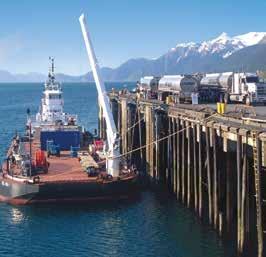



Crowley.com/Alaska

Diesel | Gasoline | Lubricants
Propane | Heating Fuel
Aviation Fuels
Cook Inlet Lending Center

A spinoff of Cook Inlet Housing Authority gained a new CEO for the new year.
The board of Cook Inlet Lending Center (CILC) named Jeff Tickle as CEO. Tickle had served as the general manager for CILC since 2015. As CEO, he is responsible for expanding residential mortgage lending and small business lending opportunities to underserved people in communities across Alaska. Tickle is a UAA graduate with thirteen years of banking and mortgage experience.
The CILC team includes Joe Chavez, hired last July as Mortgage Loan Originator. Chavez has seventeen years of banking, consumer lending, and mortgage lending experience. In his role, Chavez supports the growth of CILC’s mortgage lending across Alaska by assisting homeowners in their pursuit of homeownership.

Alaska USA
Alaska USA Federal Credit Union added two new vice presidents to its executive leadership team and promoted a current executive.




Jeff Gregg, previously vice president, Business and Commercial Lending, received a promotion to Executive Director, Business and Commercial Services. In his new role, Gregg is responsible for planning, implementation, direction, and control of all business and commercial lending and deposit activities, including coordination
of operations, sales, and administration functions. Gregg has more than 35 years of commercial lending experience and has been with Alaska USA since 2016.
Bryan Rosbach takes Gregg’s place as the new Vice President, Business and Commercial Lending. In his new role, Rosbach manages commercial loan production with a team that spans Alaska; Washington; Maricopa County, Arizona; and San Bernardino County, California. Rosbach has been with Alaska USA for 5 years and started as a commercial loan officer prior to this promotion.

Noël Gabler was promoted to Vice President, Corporate Relations. In her new role, Gabler is responsible for management of community partnerships, employee engagement, and the administration of the credit union’s diversity, equity, and inclusion program. Gabler has been with Alaska USA for 12 years and served as marketing manager before transitioning to the corporate relations team in 2018. Gabler brings experience in nonprofit management, marketing, and advertising to her new role.
GCI
The first person to hold the position of Senior Director of Diversity, Equity, and Inclusion (DEI) at GCI is a 25year veteran of the telecom company. In the new role, Deborah Ferrell focuses on growing the company’s Business Resource Groups,

which are voluntary employee groups organized around a shared background, interest, or issue. GCI created the DEI director position last year, and a year earlier Ferrell was chosen as the first chair of GCI’s DEI Council. Ferrell was previously GCI’s director of consumer sales and retail operations since 2019. She joined GCI in 1996 after working her way up from teller to supervisor at Alaska USA Federal Credit Union. Ferrell has a bachelor’s degree in elementary education from UAA.
Coffman Engineers
Coffman Engineers added Process Safety Management (PSM) to the services in its Anchorage office and hired Sisi Cooper as the new Senior Process Safety Consultant. PSM complements many of Coffman’s process and mechanical engineering services, integrating technologies, procedures, and management practices to help organizations comply with federal regulations and keep employees and environments safe. Cooper has worked for firms specializing in process control and process safety consulting, engineering, and integration services and has overseen PSM teams. Much of her focus has been on process safety and risk management for upstream and midstream oil and gas projects in Alaska.
Nortech
Jason Gresehover recently joined the staff at Nortech as an environmental engineer. Gresehover graduated from UAF with degrees in civil engineering and mathematics, and he holds a 40-
Keeping Alaska Open for Business
 Tickle
Rosbach
Ferrell
Chavez
Gabler
Gregg
Cooper
Tickle
Rosbach
Ferrell
Chavez
Gabler
Gregg
Cooper
116 | March 2023 Alaska Business www.akbizmag.com
MOVES IS BROUGHT TO YOU
RIGHT
RIGHT
BY NORTHERN AIR CARGO
MOVES
certificate. Gresehover has conducted Phase I and Phase II investigations throughout Alaska. He has been project lead on several site remediation projects and has experience in all aspects of investigations, including site research, regulatory approval for sampling plans, conducting soil and groundwater sampling, and tank removal. He adds to Nortech’s expertise in fuel system decommissioning, environmental permitting, and water and wastewater systems design.
NOAA Fisheries
NOAA Fisheries Alaska Region selected Amilee Wilson as Tribal Relations Coordinator. Wilson previously served as the tribal coordinator for the NOAA Fisheries West Coast Regional Office in Lacey, Washington, and in Portland, Oregon. She worked extensively on grants administration, including emergency fisheries funding, and she revamped the Tribal Relations Training Program. Wilson is a descendant of the Shinnecock Nation on the eastern side of Long Island, New York, but she was raised on the West Coast at a 200-acre cattle ranch near Olympia, Washington. She earned a bachelor’s degree in environmental studies and a master’s degree in public policy from Evergreen State College. She currently resides in Yakutat.
MCG Explore Design
MCG Explore Design, formerly the firm of McCool Carlson Green, promoted an interior designer to Principal and Owner. As part of the ownership team, Melissa Pribyl plays a pivotal role in the future growth


of the design firm. Raised in Alaska, Pribyl graduated with a degree in interior design from Northern Arizona University in 2007 and joined MCG in 2016. She is certified by the National Council for Interior Design Qualification and the American Society of Interior Designers and is an accredited professional in the WELL building standard.


Alaska Railroad
The Alaska Railroad Corporation (ARRC) promoted its controller, Michelle Maddox, as the new Chief Financial Officer. As head of the ARRC Finance Division, Maddox oversees the railroad’s financial planning and analysis, accounting, supply management, grant administration, technology, and risk management. The CFO also advises the railroad’s executive management team and board of directors in financial matters. Originally from Idaho, Maddox completed her bachelor’s degree in accounting from Utah State University. She and her husband moved to Alaska in 1998, and within weeks she secured a job as assistant controller with the railroad. Since then, Maddox has been in charge of payroll and accounts payable, and she was promoted to controller in 2020.

Municipality of Anchorage
The acting Chief Fiscal Officer for the Municipality of Anchorage can keep the position for the long haul. Grant Yutrzenka has been doing the job since last September, working previously as CFO for the Anchorage Water and Wastewater Utility as well as its assistant general manager. Mayor Dave Bronson named Yutrzenka as his choice for CFO as of the new year. Yutrzenka has
a bachelor’s degree in business administration with an emphasis in accounting from UAA. He has more than 30 years of financial and management experience in public accounting, fisheries, and telecommunications, working for Municipal Light and Power, GCI, and UniSea.


Palmer Museum of History and Art
An active community volunteer in Palmer has a paid position with the local museum. The board of the Palmer Museum of History and Art hired Amber Lindstrom as Executive Director. Lindstrom was born and raised in Palmer. She has volunteered with Palmer Fire & Rescue and the Greater Palmer Chamber, currently serving on its board of directors. She has also been a board member for the museum. Lindstrom has been working for a Palmer engineering firm in its real estate service section, handling acquisitions and relocations, title research, document preparation, and appraisal review. That role took on greater responsibilities for public involvement and marketing.
UAF

The Alaska Satellite Facility (ASF) at the UAF Geophysical Institute selected Wade Albright as its new Director, overseeing a team of 100 people. He had been serving as interim director since late January 2022, when then-Director Nettie La Belle-Hamer left to become UAF vice chancellor for research. Albright has been with ASF since 1996, just five years after it became operational.

hour HAZWOPER training
Gresehover Pribyl
Maddox
Yutrzenka
Lindstrom
Albright
For more information, please visit us at www.nac .aero.
www.akbizmag.com Alaska Business March 2023 | 117
Northern Air Cargo is committed to getting your cargo where it needs to be, on time, so you can worry about what really matters.
ALASKA TRENDS
Hauling in a 50-pound halibut might be a once-in-a-lifetime triumph for an angler. For a commercial halibut vessel, it’s the start of a good fishing day. For trawlers targeting other groundfish, like Pacific cod, catching a halibut is a hassle. The trawler might not have permission to keep a halibut, and its hold has only so much room for saleable species. Easier to discard the halibut overboard, even if the accidental encounter proves fatal. The bycatch removes the fish from the ecosystem without any economic reward for the crew. What a waste.
Sustainably managed fisheries have strong incentives to minimize bycatch, at the cost of some inconvenience to hardworking crews. Regulations, specialized gear, monitoring technology, and in-person observers are some of the tools at the disposal of NOAA Fisheries. The agency keeps detailed reports from every active vessel about the amount of bycatch to the nearest gram, or less than the weight of a single halibut’s weird eyeball.
Now, halibut are relatively safe, with bycatch at historically low levels. As Vanessa Orr’s article “Snagged by Accident” reports, other fisheries are suffering, particularly Western Alaska salmon, and even if bycatch is not the most important factor in the decline, it is the most controllable.
This edition of Alaska Trends dips into the overwhelming abundance of data to fish out a few facts.
Note 1:
Source for all data and facts: NOAA Fisheries
Midwater Trawls
TARGETED
SPECIES
Bottom Pollock
Midwater Pollock
Pacific Cod
Rockfish
Sablefish
POLLOCK = $383M
In 2021, commercial landings in the Bering Sea and Gulf of Alaska totaled 3.2 billion pound valued at $383 million.
BYCATCH IN 2022

347 Bairdi Tanner Crabs
5 Blue King Crabs
42 Opilio Tanner Crabs
14 Red King Crabs
19,661 Chinook Salmon
243,932 Non-Chinook Salmon
136,386 kilograms of Halibut
Data includes the CDQ. Note 2: Data includes estimates for vessels with and without observers or electronic monitoring. Note 3: Halibut data does not include Halibut or Sablefish hook-and-line targets. Note 4: Bycatch rates and estimates may change to reflect updated information when new data enters or existing data are updated.
WORLDWIDE VALUE
118 | March 2023 Alaska Business www.akbizmag.com
The Alaska pollock fishery is one of the most valuable in the world.
Traps & Pots
TARGETED
SABLEFISH OIL
Sablefish are the highest valued finfish per pound in Alaska and US West Coast commercial fisheries because of their rich oil content.
Non-Pelagic Trawl Gear


16,704
128,370
Hook & Line Gear
TARGETED
SO MANY ROCKFISH
Rockfish species include bocaccio, canary rockfish, Pacific Ocean perch, shortspine thornyhead, and yellowtail rockfish.
Jig Gear
TARGETED
COD = $330.4M
TARGETED SPECIES
Alaska Plaice
Arrowtooth Flounder
Atka Mackerel
Bottom Pollock
Flathead Sole
Greenland Turbot
Kamchatka Flounder
Midwater Pollock
Other Flatfish
Pacific Cod
Rex Sole
Rock Sole
Rockfish
Sablefish
Shallow-Water Flatfish
Yellowfin Sole
ARROWTOOTH
FLOUNDER = $3.8M
In 2021, commercial landings of arrowtooth flounder totaled 36 million pounds, valued at $3.8 million.
80% RETENTION
Although arrowtooth flounder are a low-value fish, fishermen have been retaining many of the fish they catch, up to about 80 percent in Alaska.
BYCATCH IN 2022
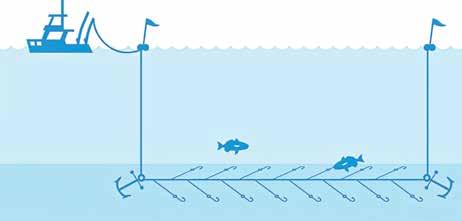

375,531 Bairdi Tanner Crabs
453 Blue King Crabs
3,524 Gold King Crabs
188,989 Opilio Tanner Crabs
3,187 Chinook Salmon
6,475 Non-Chinook Salmon
2,219,836 kilograms of Halibut
In 2021 the commercial harvest of Pacific Cod totaled 330.4 million pounds and was worth $86.5 million.
SPECIES Pacific Cod Rockfish
BYCATCH IN 2022
159 kilograms of Halibut
SPECIES Pacific Cod Sablefish BYCATCH IN 2022
Crabs
111,790 Bairdi Tanner
Crabs
6,160 Gold King
Opilio Tanner Crabs
Crabs
Red King
Halibut
213,379 kilograms of
SPECIES Pacific Cod Sablefish Rockfish BYCATCH IN 2022 7,626 Bairdi Tanner Crabs 3,915 Blue King Crabs 22,325 Opilio Tanner Crabs 567 Red King Crabs 129 Gold King Crabs 7 Chinook Salmon 109 Non-Chinook Salmon 1,474,958 kilograms of Halibut
www.akbizmag.com Alaska Business March 2023 | 119
What book is currently on your nightstand? A Man of Iron: The Turbulent Life and Improbable Presidency of Grover Cleveland by Troy Senik.
What charity or cause are you passionate about?

Children in need… We’ve given charitably to places like Covenant House and MyHouse (in the Mat-Su).
What vacation spot is on your bucket list? I would love to be able to spend more time in, oh gosh, from France to Italy to Eastern Europe. That area.
What are you superstitious about?
Not much.
If you could domesticate a wild animal, what animal would it be? How about those that cause harm and I’d like them not to cause harm? [he laughs] Any kind of snake.
120 | March 2023 Alaska Business www.akbizmag.com
Photos by Kerry Tasker
Sean Parnell
Toward the end of his term as governor of Alaska, someone showed Sean Parnell a word cloud compiled from his public addresses. The largest, most frequent word turned out to be “opportunity.” That theme connects his current role as UAA chancellor through his years in elected office and his career as a commercial attorney.
“Because every client is with you because they want to create something different for themselves or their business,” he says, “I saw those as creating opportunity for the client.”
Parnell might’ve never gone into law, instead pursuing his dream to become an Air Force fighter pilot, were it not for a pivotal conversation with Renita Yahara, his French teacher at Anchorage Christian School. He recalls her saying, “You were meant to be around people continually during the day. I really don’t see you in a cockpit.”
Applying his interpersonal skills to politics, Parnell spent eight years in the Alaska House and Senate, eight more as lieutenant governor and governor, and he continues to draw a state paycheck today, hired in 2021 to lead UAA’s five campuses.

Alaska Business: What’s the most daring thing you’ve ever done?
Sean Parnell: Besides putting my name and face out there for public office? [he laughs] Raising two daughters.
AB: What do you do in your free time?
Parnell: I love to hike and walk. I love to spend time with my grandchildren. I love to just be with my partner in life and wife, Sandy, and with friends.
AB: What’s the first thing you do when you get home after a long day at work?
Parnell: [he laughs] If Sandy’s there, I give her a great big hug and tell her, “I love you and it’s great to see ya,” and then we start making dinner together.
AB: Is there a skill you’re currently developing or have always wanted to learn?
Parnell: I’m a beginner woodworker… I would love to develop that into more of a furniture making type skill for myself… I have a basement to go down and make some noise in. [he laughs]
AB: What’s your favorite local restaurant?
Parnell: Sorrento’s on Fireweed… Don’t get me wrong: there are a lot of restaurants, and I could name about five that I frequent regularly, but that one comes to mind as a historic Anchorage spot.
AB: Dead or alive, who would you like to see perform live in concert?
Parnell: You’re gonna laugh, but I would love to go see a Luke Combs concert… I was a rock ‘n roll kinda guy until about 2015, and I got switched to more modern country… I love acoustic guitar.
AB: What’s your greatest extravagance?
Parnell: Both Sandy and I love being able to bring gifts to others, so that for us is an extravagance.
AB: What’s your best attribute and worst attribute?
Parnell: [he laughs] As a positive attribute, my care and concern for the others I work with and the people that we work for… Worst attribute? I like to disappear for an hour to take a walk during the day. My schedule is usually such that it’s back-to-back-toback-to-back, and if there’s an hour in there and I can slip out and go for a walk, it gives me time to think.
www.akbizmag.com Alaska Business
OFF THE CUFF




Airport Equipment Rentals .................... 123 airportequipmentrentals.com Alaska Dreams Inc 54 alaskadreamsinc.com Alaska Materials 19 alaskamaterials.com Alaska Miners Association 93 alaskaminers.org Alaska Pacific University .......................... 89 alaskapacific.edu Alaska Railroad 93 akrr.com Alaska Roof Restorations 33 alaskaroofrestorations.com Alaska School Activities Association 11 asaa.org Alaska Traffic Company ........................... 47 alaskatraffic.com Alaska USA Federal Credit Union 13 alaskausa.org Alcan Electrical & Engineering Inc 39 alcanelectric.com Altman, Rogers & Co. 109 altrogco.com American Heart Association .................... 86 heart.org Anchorage Chamber of Commerce ....... 69 anchoragechamber.org Anchorage Chrysler Dodge 106 accak.com Anchorage Convention Centers 25 anchorageconventioncenters.com Anchorage Sand & Gravel 63 anchsand.com ASRC Construction .................................. 77 asrcconstruction.com Associated General Contractors of Alaska 77 agcak.org Avis Rent-A-Car 107 avisalaska.com Bering Straits Native Corp 21 beringstraits.com Carlile Transportation Systems ................. 9 carlile.biz Conrad-Houston Insurance Agency 101 chialaska.com Construction Machinery Industrial 2 cmiak.com Cook Inlet Tug & Barge Inc 99 cookinlettug.com Craig Taylor Equipment ........................... 45 craigtaylorequipment.com Credit Union 1 113 cu1.org Crowley Fuels 115 crowley.com Cruz Companies 57 cruzconstruct.com Davis Constructors & Engineers Inc ....... 41 davisconstructors.com Denali Materials 41 denalimaterials.com DesertAir Alaska 112 desertairalaska.com Design Alaska 71 designalaska.com Equipment Source, Inc ............................ 79 esialaska.com First National Bank Alaska .......................... 5 fnbalaska.com Fountainhead Development 49 fountainheadhotels.com GCI 29 gci.com Great Northwest Inc 74 grtnw.com Great Originals Inc ................................. 105 greatoriginals.com Hecla Greens Creek Mining Company 91 hecla-mining.com Holmes Weddle & Barcott 97 hwb-law.com JEFFCO Inc. 19 jeffcogrounds.com Lynden .................................................... 124 lynden.com Material Flow & Conveyor Systems, Inc. 55 materialflow.com Matson Inc. ............................................... 43 matson.com Meridian Management, Inc. 56 meridianak.com Moda ......................................................... 87 modahealth.com NANA Construction LLC 72 nanaconstruction.com NECA Alaska Chapter 59 alaskaneca.org Nenana Heating Services, Inc 83 nenanaheatingservicesinc.com New Horizons Telecom, Inc. 73 nhtiusa.com Nortech Environmental & Engineering 103 nortechengr.com Northern Air Cargo 116, 117 nac.aero Northrim Bank .......................................... 37 northrim.com Nu Flow Alaska 75 nuflowak.com NW Carpenters Union.................................. 83 nwcarpenters.org Oxford Assaying & Refining Inc 95 oxfordmetals.com Parker, Smith & Feek ................................ 15 psfinc.com Personnel Plus Employment Agency 109 perplus.com Petro Marine Services 51 petromarineservices.com PND Engineers Inc. 71 pendengineers.com Samson Tug & Barge 101 samsontug.com Satellite Alaska ........................................ 101 Schwabe, Williamson & Wyatt, P.C.......... 23 schwabe.com/locations-anchorage-alaska Sheet Metal Inc 58 sheetmetalinc.com Span Alaska Transportation LLC 102 spanalaska.com Spenard Builders Supply 66 sbsalaska.com Stellar Designs Inc .................................... 97 stellar-designs.com Sullivan Water Wells 35 sullivanwaterwells.com Superior Group 81 superiorpnh.com T. Rowe Price 3 alaska529plan.com The Plans Room ....................................... 89 theplansroom.com Tikigaq 53 conamco.com Tutka, LLC 65 tutkallc.com Tyonek Native Corp 64 tyonek.com UA Local 375 Plumbers & Pipefitters....... 61 ualocal375.org UAF eCampus ........................................... 27 ecampus.uaf.edu Ukpeagvik Inupiat Corporation 7 uicalaska.com Umialik Insurance Company 111 umialik.com USI Insurance Services 17 usi.com Watterson Construction .......................... 67 wccak.com Westmark Hotels - HAP Alaska 99 westmarkhotels.com WILLSCOT 81 willscot.com Yukon Equipment Inc 31 yukoneq.com To Vote visit: AKBIZMAG.COM/BOAB or SCAN THE QR CODE It’s Time TO VOTE Voting Starts: March 1 Voting Ends: March 31 Voting takes minutes. Select Winners in Over 40 Categories. 2023 SUPPORT YOUR FAVORITE BUSINESSES! WINNERS WILL BE REVEALED IN THE JULY ISSUE 122 | March 2023 Alaska Business www.akbizmag.com ADVERTISERS INDEX

Thank You Alaska!



Thank you to our friends, neighbors, and valued customers for your ongoing support and partnership, and special thanks to each of our dedicated employees for their continued care, expertise, and ingenuity as we all work together to keep Alaska moving. We look forward to continuing to serve our communities by providing multi-modal transportation and logistics solutions across the entire state!





















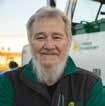









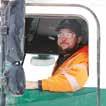









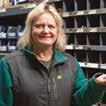














 By Amy Newman
By Amy Newman
 By Jesse Leman James R. Evans UAA
By Jesse Leman James R. Evans UAA



 by Rachael Kvapil
by Rachael Kvapil







 By Jesse Leman
By Jesse Leman


















 By Tara O’Hanley
By Tara O’Hanley


 Alaska Center for Energy and Power (ACEP) studies a plot of willows at the Fairbanks Experiment Farm.
Top, ACEP interns Henrique Goncalves (left) and Desneige Hallbert (right) monitor growth for potential use as biomass fuels.
Bottom, ACEP research technician Amanda Byrd (left) works with Steven Sparrow (right), dean of UAF’s College of Natural Resources and Agricultural Sciences.
Alaska Center for Energy and Power (ACEP) studies a plot of willows at the Fairbanks Experiment Farm.
Top, ACEP interns Henrique Goncalves (left) and Desneige Hallbert (right) monitor growth for potential use as biomass fuels.
Bottom, ACEP research technician Amanda Byrd (left) works with Steven Sparrow (right), dean of UAF’s College of Natural Resources and Agricultural Sciences.









 USGS scientist Jennifer Lewicki measures the flow of a tributary to Hot Springs Creek on Akutan Island in the Aleutians. Springs that feed the stream expel steam nearby.
USGS scientist Jennifer Lewicki measures the flow of a tributary to Hot Springs Creek on Akutan Island in the Aleutians. Springs that feed the stream expel steam nearby.







































 by Rachael Kvapil
by Rachael Kvapil













































































 The Mobile Cleaning Recovery Recycle System vehicle invented by Triverus in its natural habitat: scrubbing the deck of a US Navy aircraft carrier.
Triverus
The assembly of cleaning vehicles at Triverus’ manufacturing plant in Palmer.
The Mobile Cleaning Recovery Recycle System vehicle invented by Triverus in its natural habitat: scrubbing the deck of a US Navy aircraft carrier.
Triverus
The assembly of cleaning vehicles at Triverus’ manufacturing plant in Palmer.






























 When the Anchorage Assembly abolished parking mandates in November, Mayor Dave Bronson congratulated them by posting this image of a lot being converted into Block 96 Flats (although, being downtown, it was not subject to the mandate).
When the Anchorage Assembly abolished parking mandates in November, Mayor Dave Bronson congratulated them by posting this image of a lot being converted into Block 96 Flats (although, being downtown, it was not subject to the mandate).






 By Katie Pesznecker
By Katie Pesznecker












 Brice Incorporated is 90 percent complete building the improvements at Kaltag airport and should finish later this year.
Brice Incorporated is 90 percent complete building the improvements at Kaltag airport and should finish later this year.





















 By Tasha Anderson
By Tasha Anderson











 By Alexandra Kay
By Alexandra Kay





























 Capacity at the Graphite Creek camp expanded in 2022 from 24 to 60 workers. Once production begins, the mine is expected to employ up to 200 workers year round.
Capacity at the Graphite Creek camp expanded in 2022 from 24 to 60 workers. Once production begins, the mine is expected to employ up to 200 workers year round.




































 Alaska Department of Fish & Game
Alaska Department of Fish & Game


























 Carter Damaska Alaska Business
Carter Damaska Alaska Business










































 Tickle
Rosbach
Ferrell
Chavez
Gabler
Gregg
Cooper
Tickle
Rosbach
Ferrell
Chavez
Gabler
Gregg
Cooper





































































